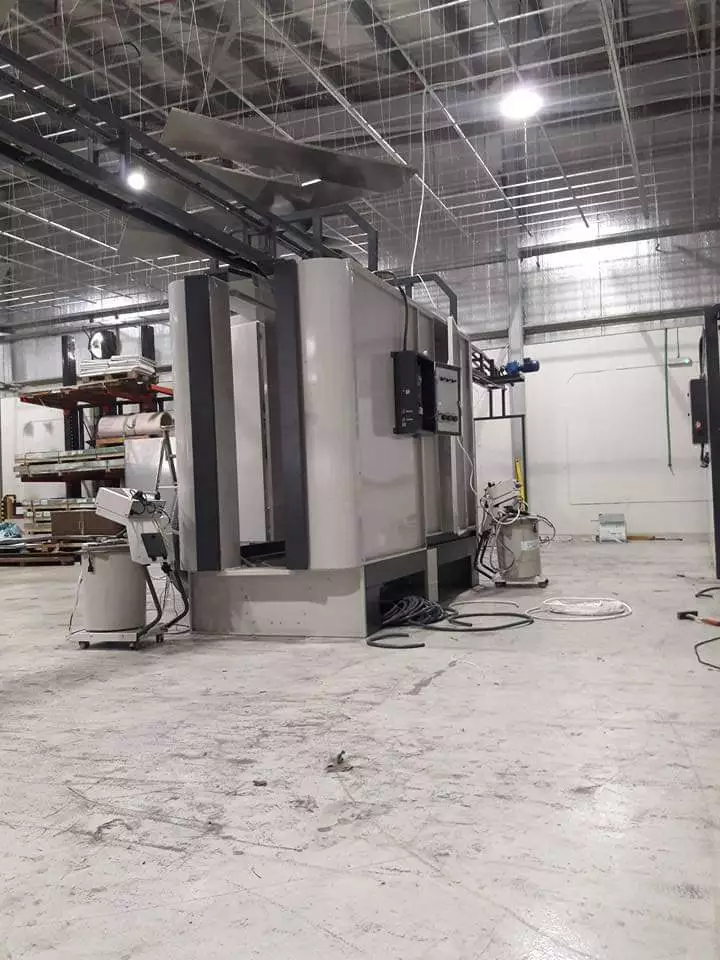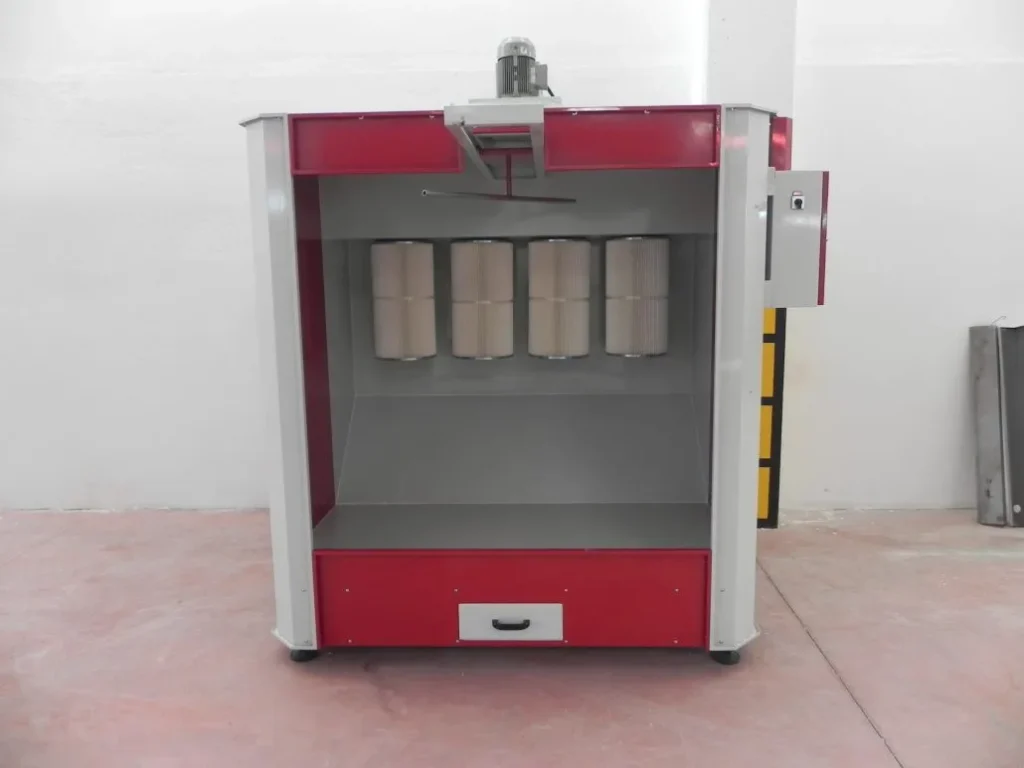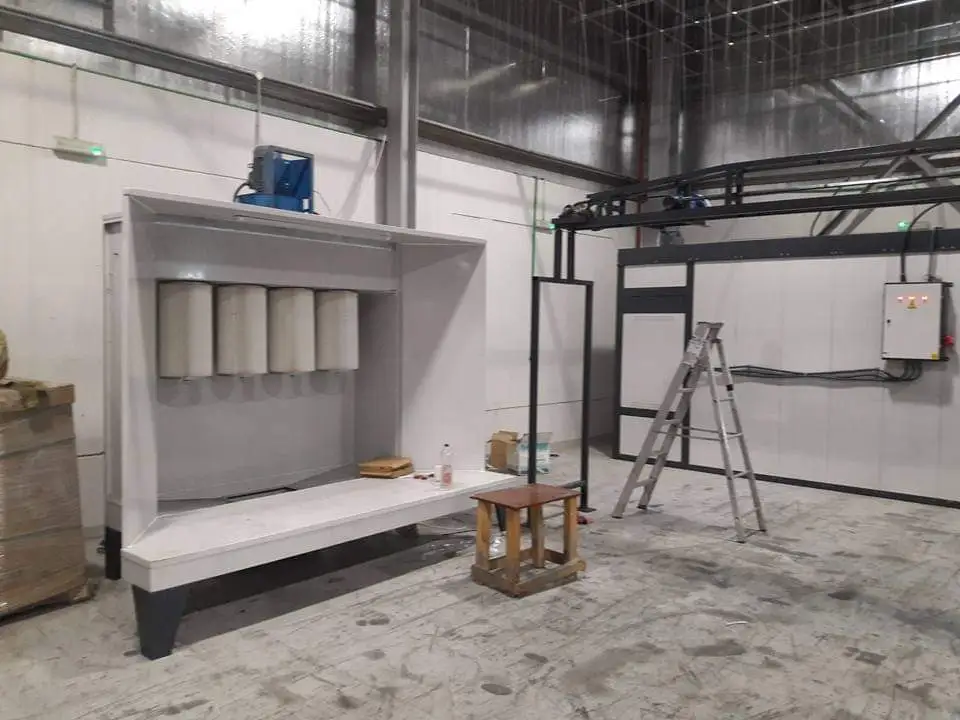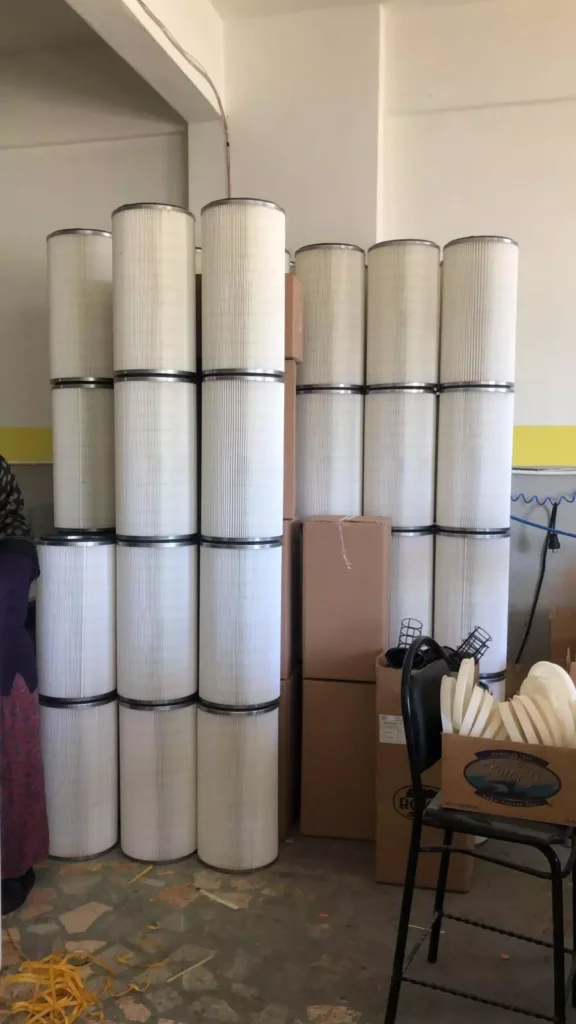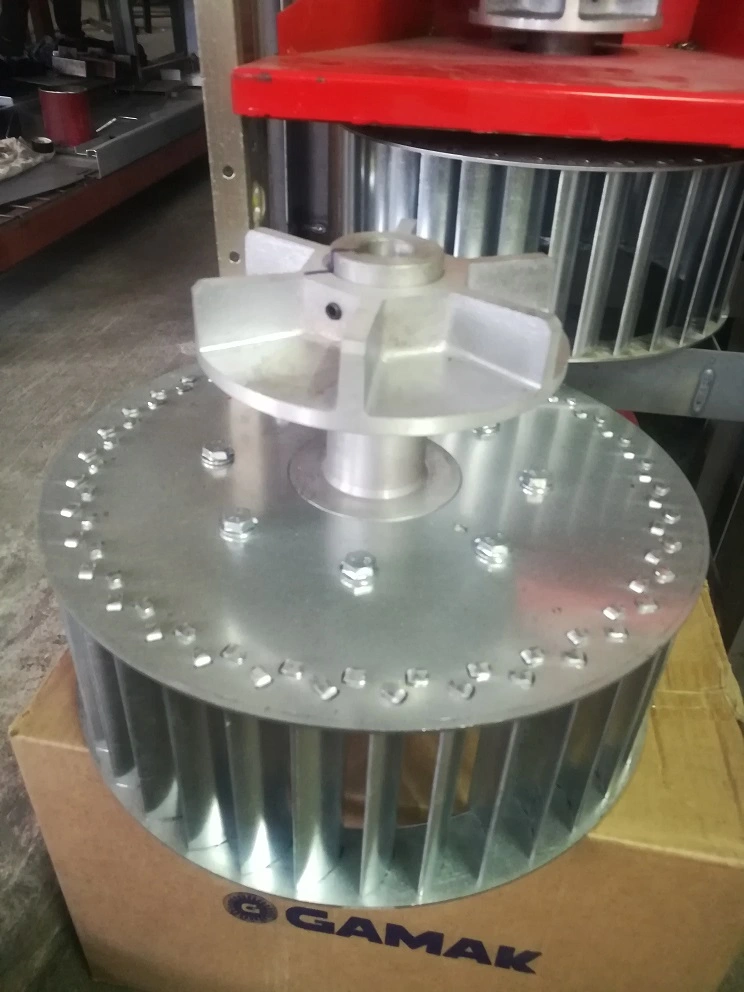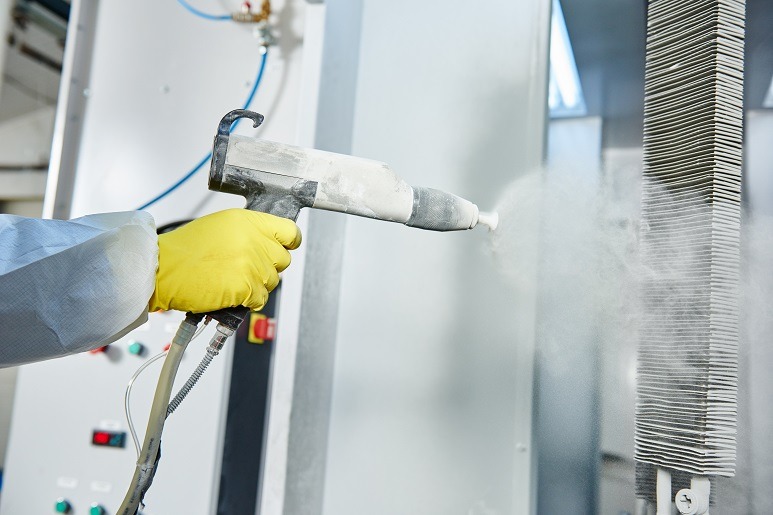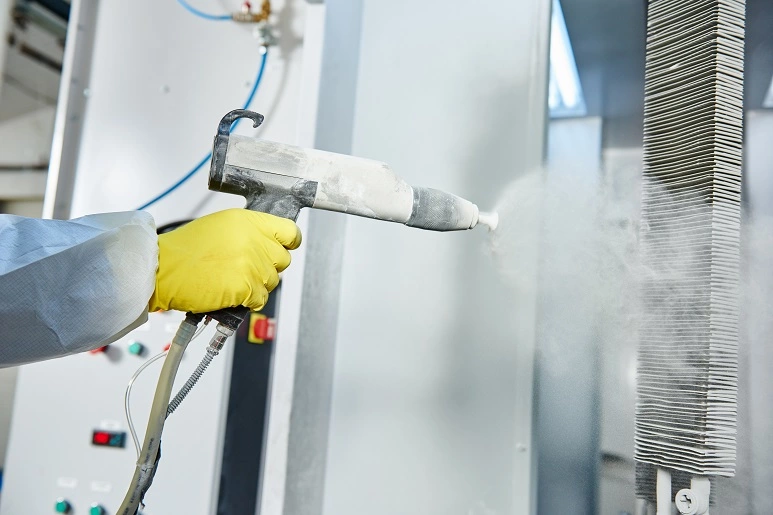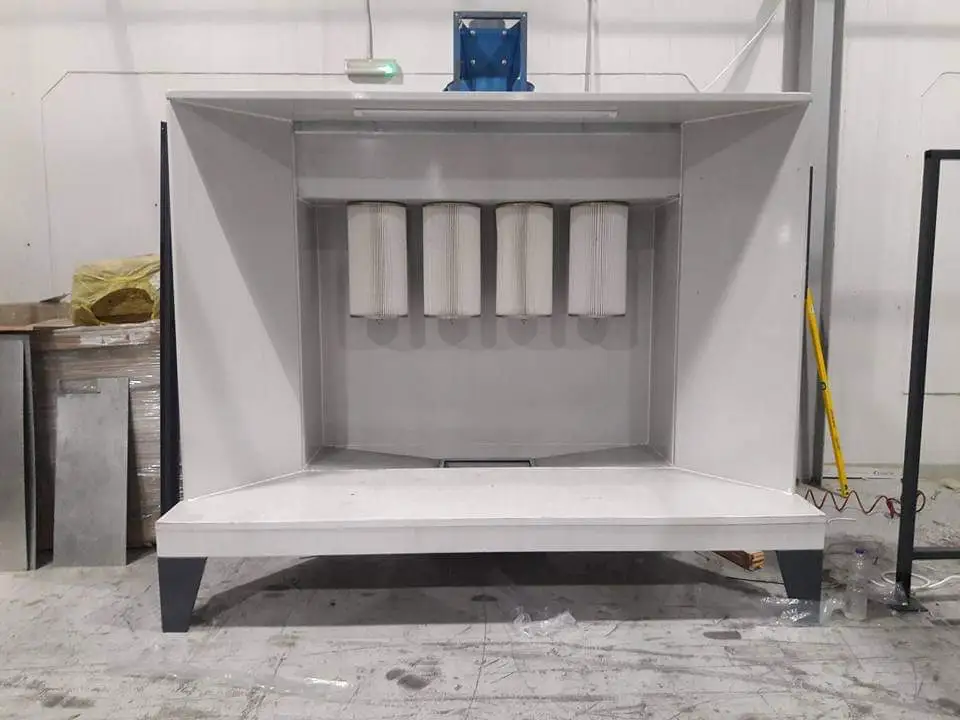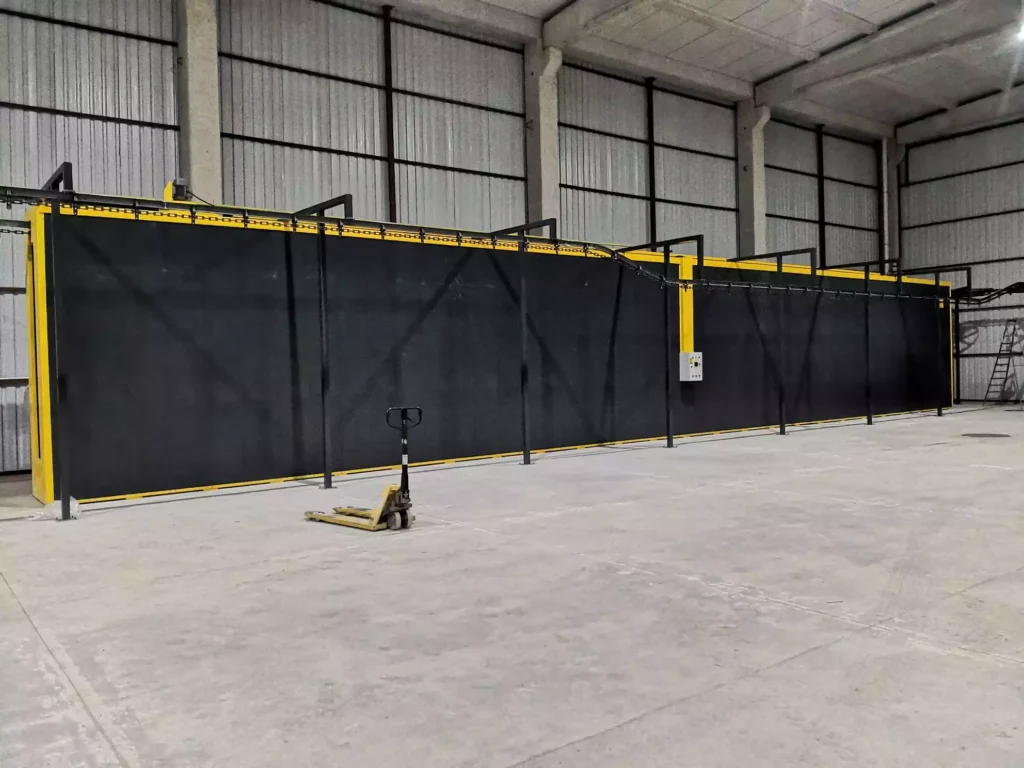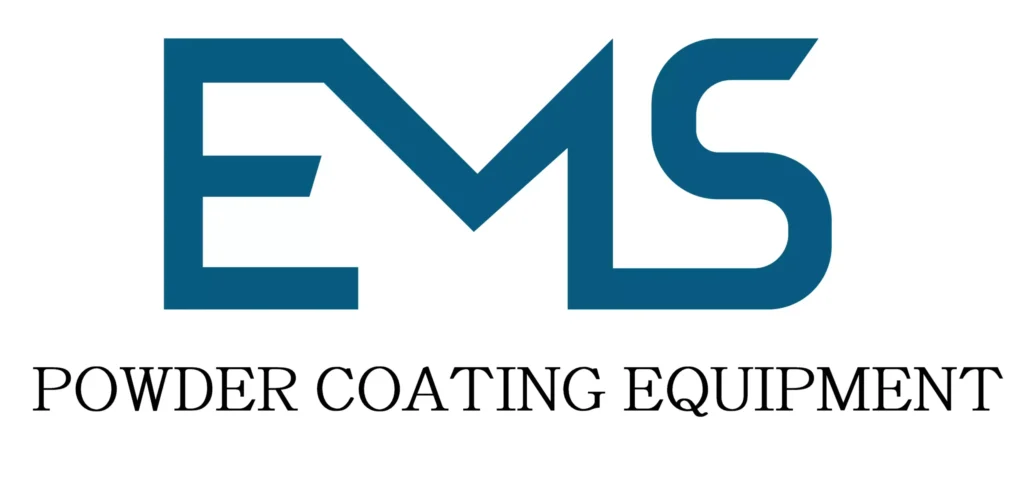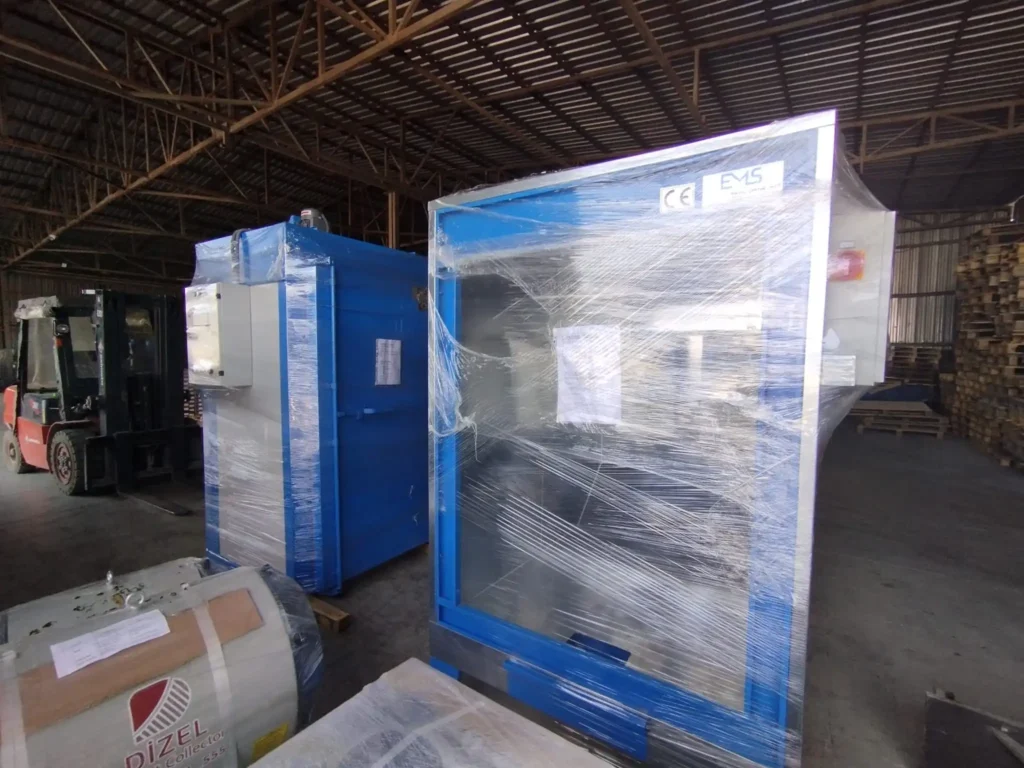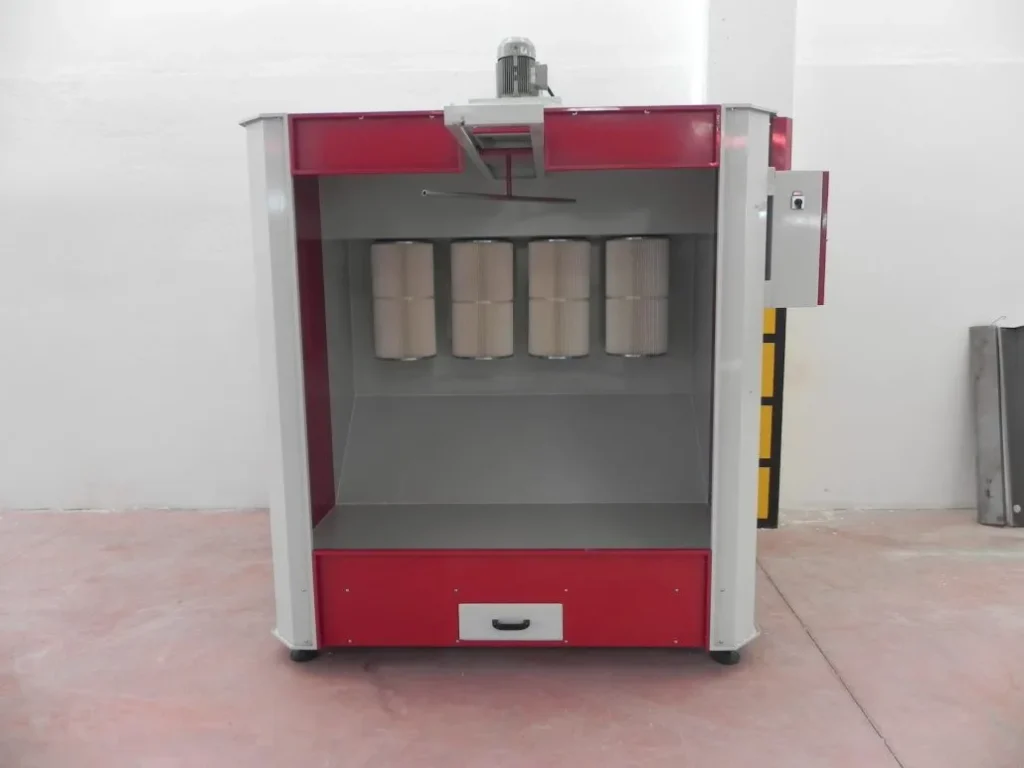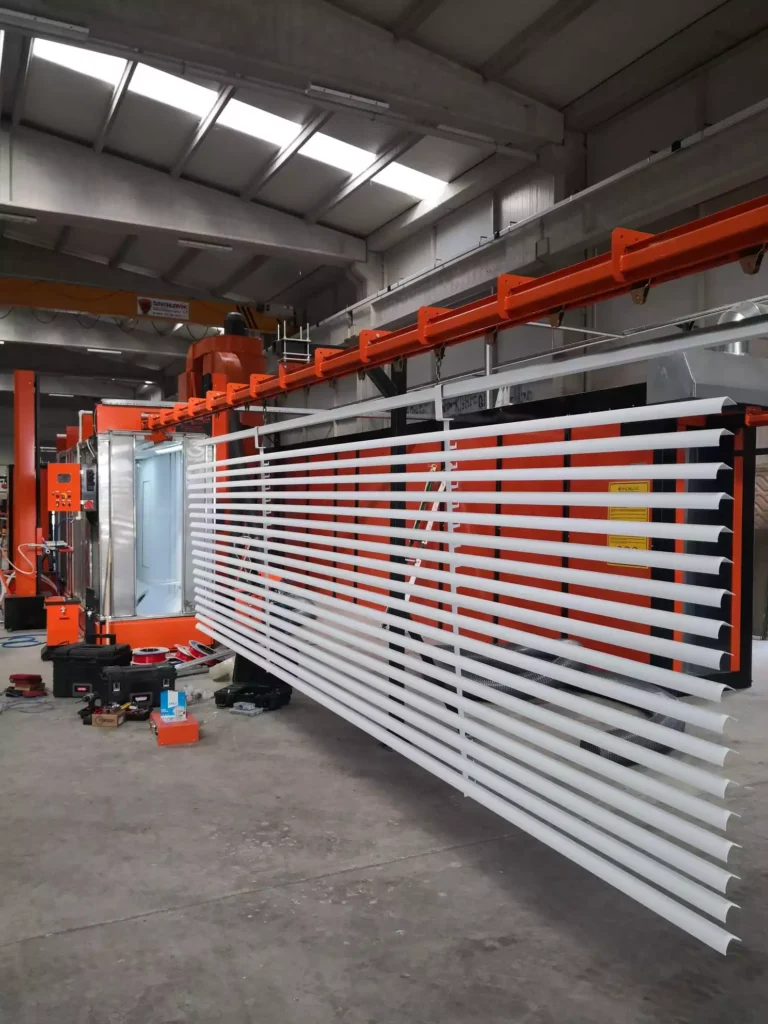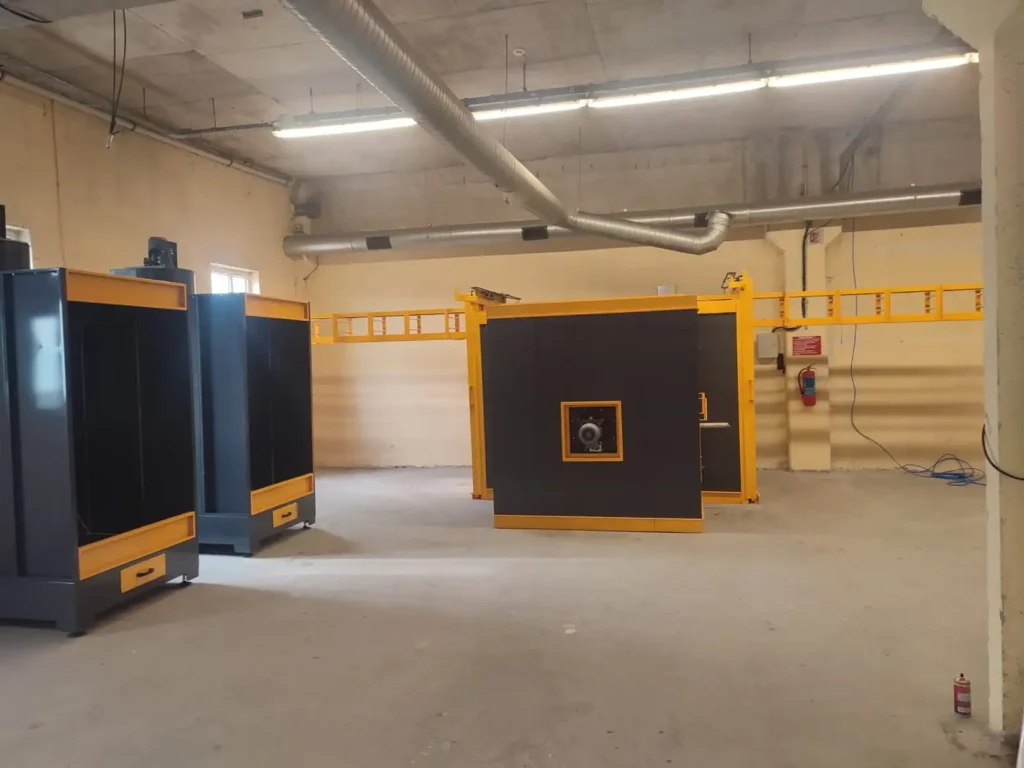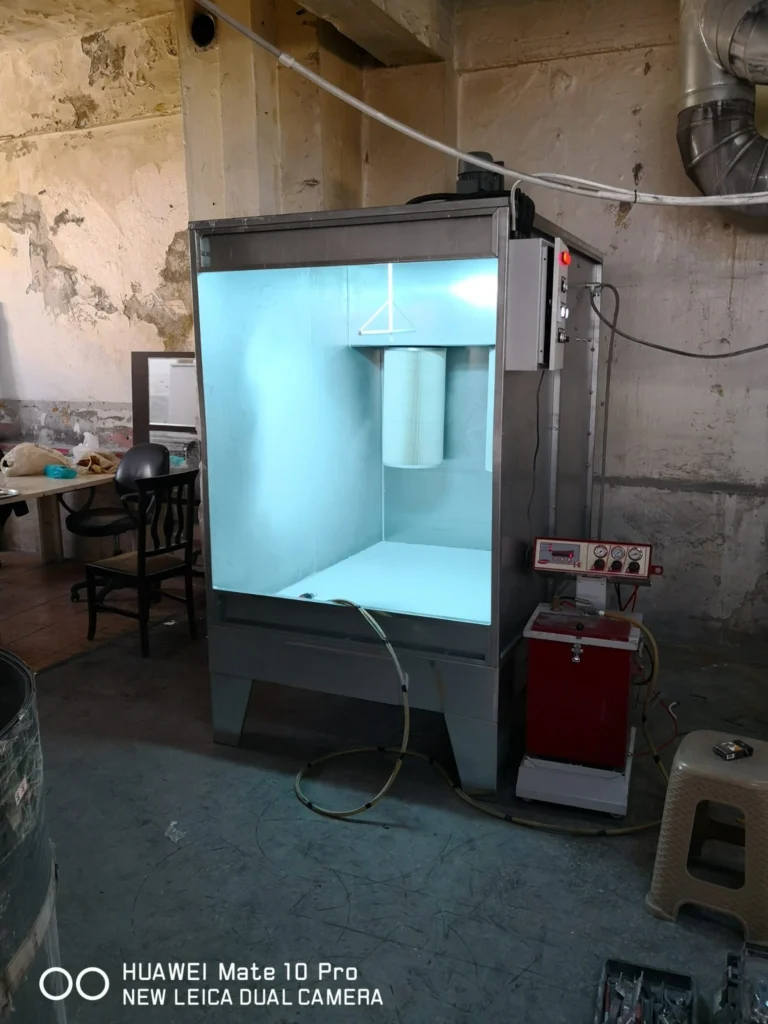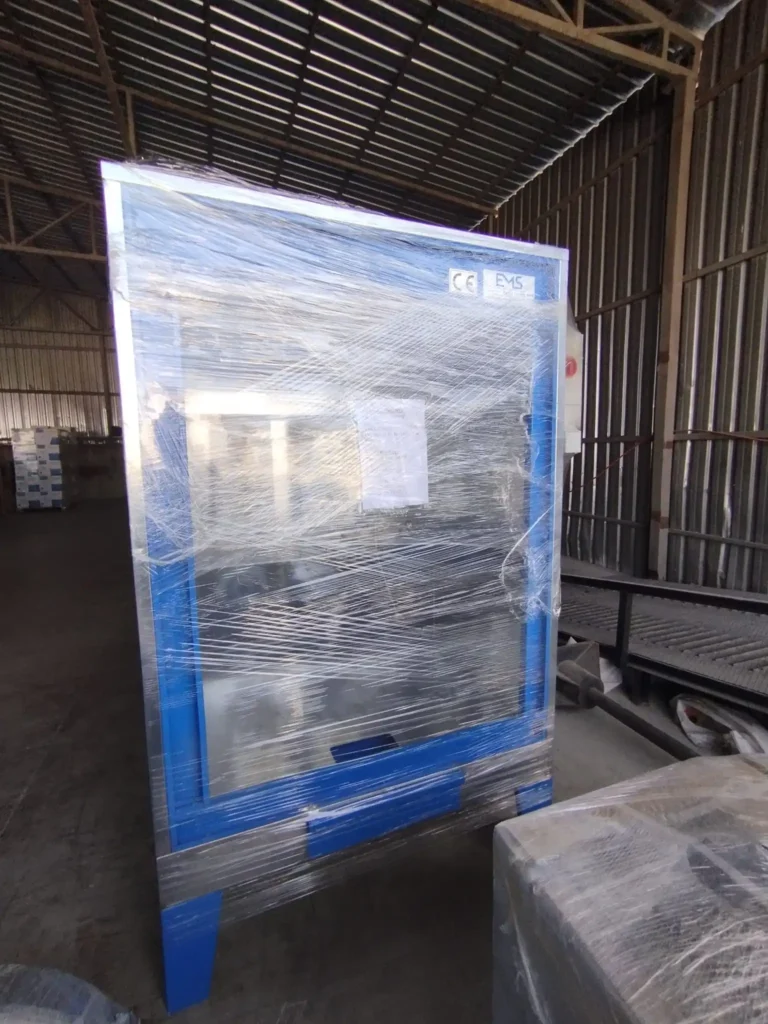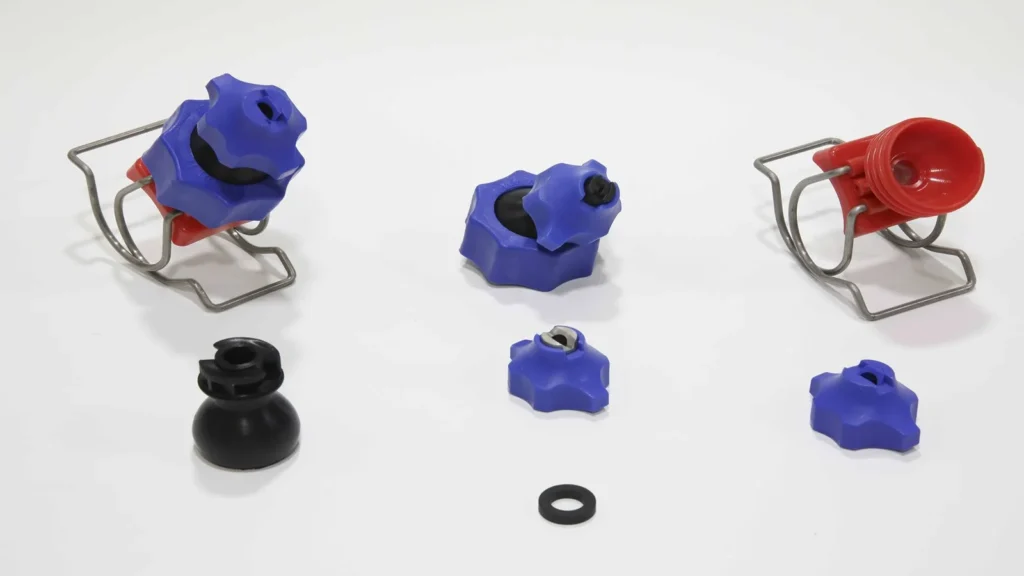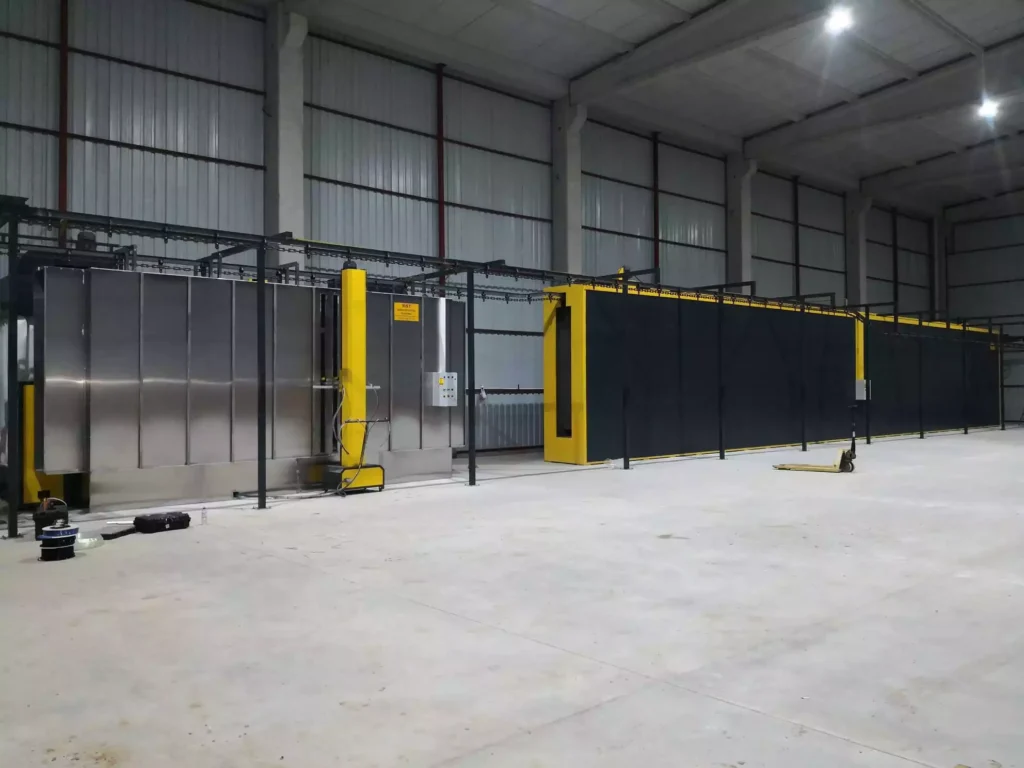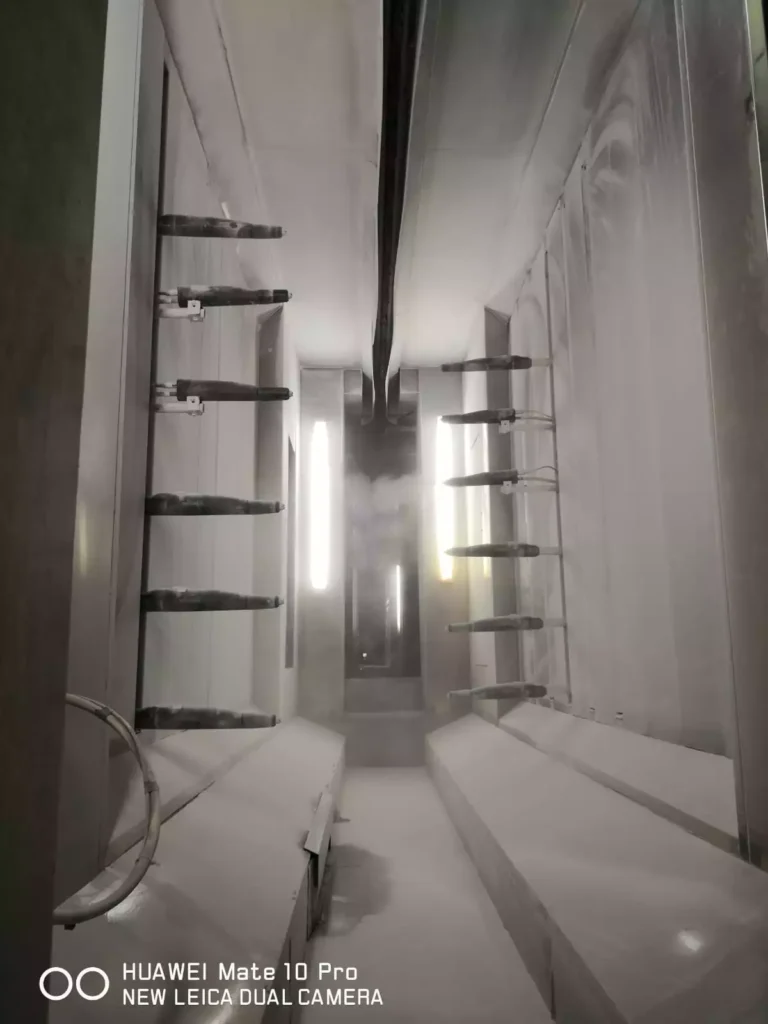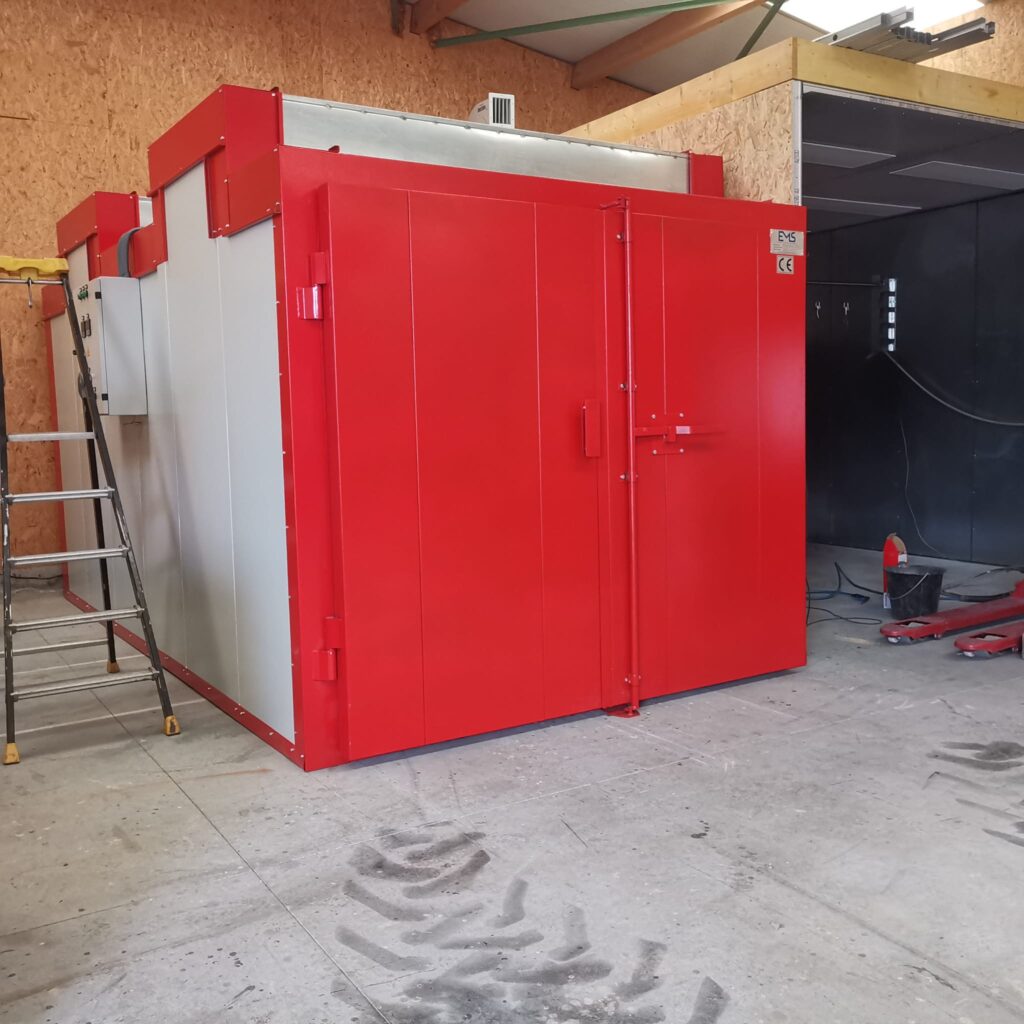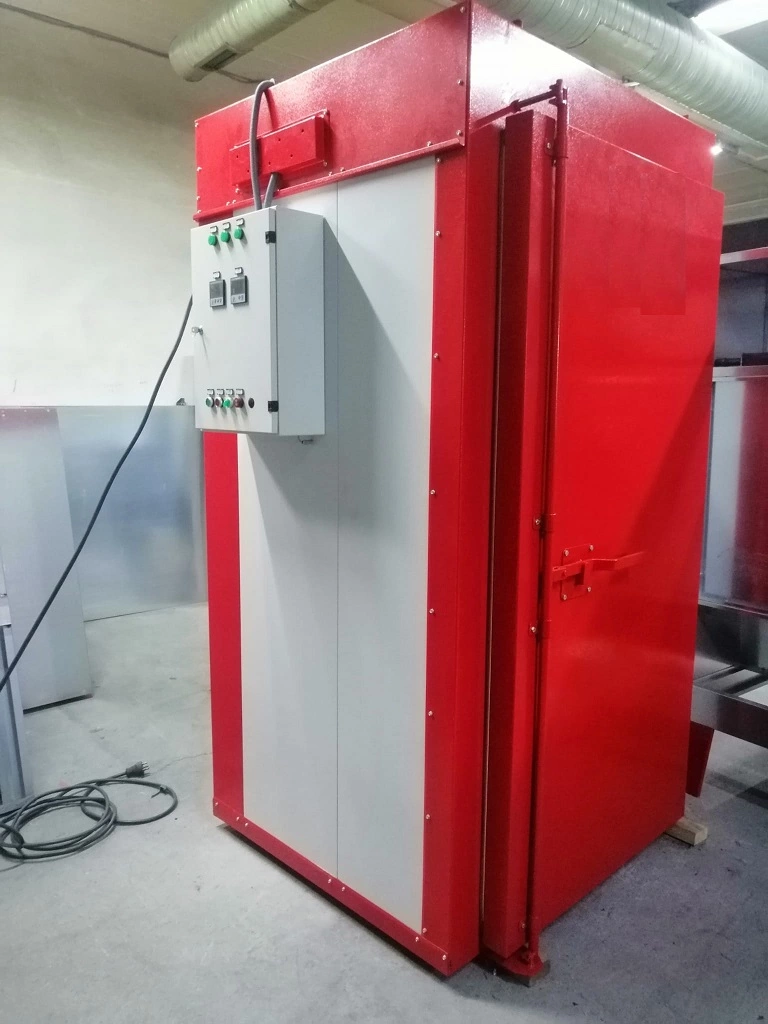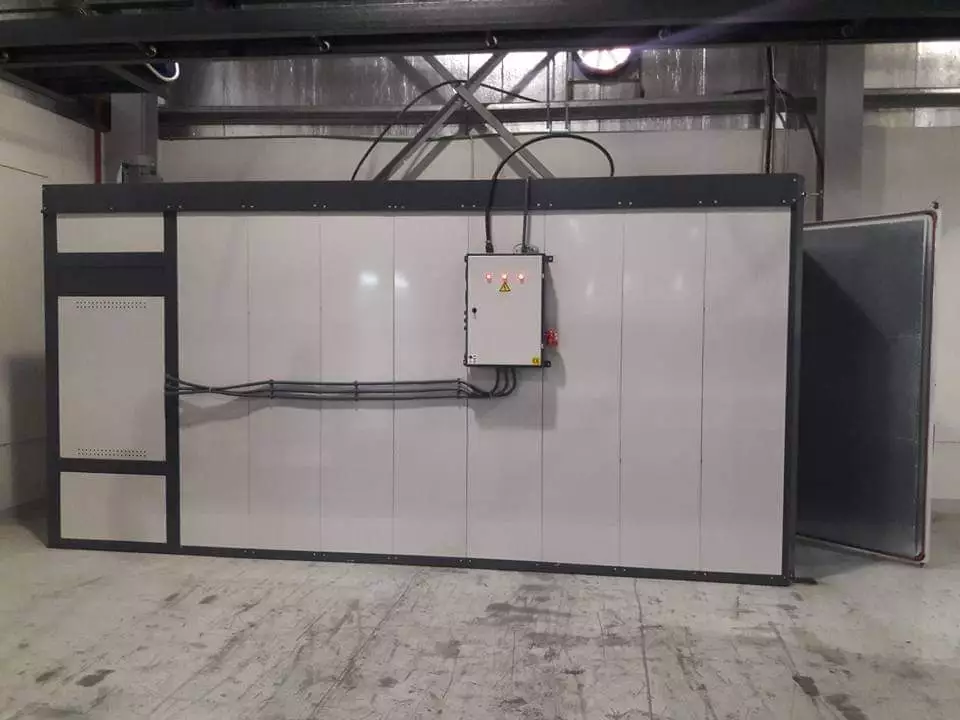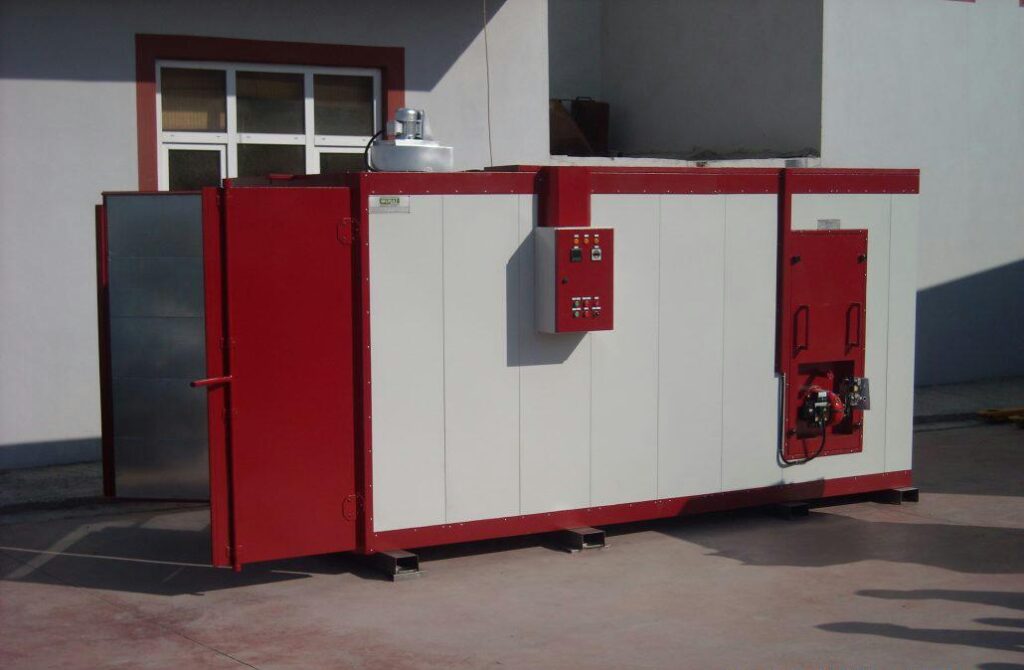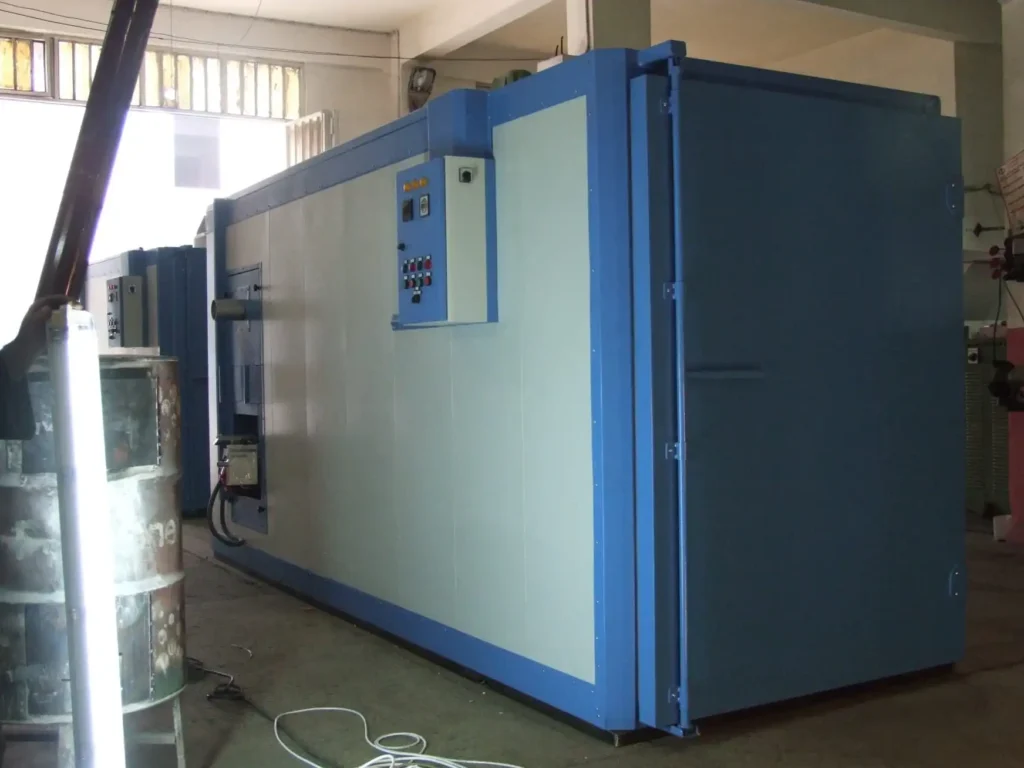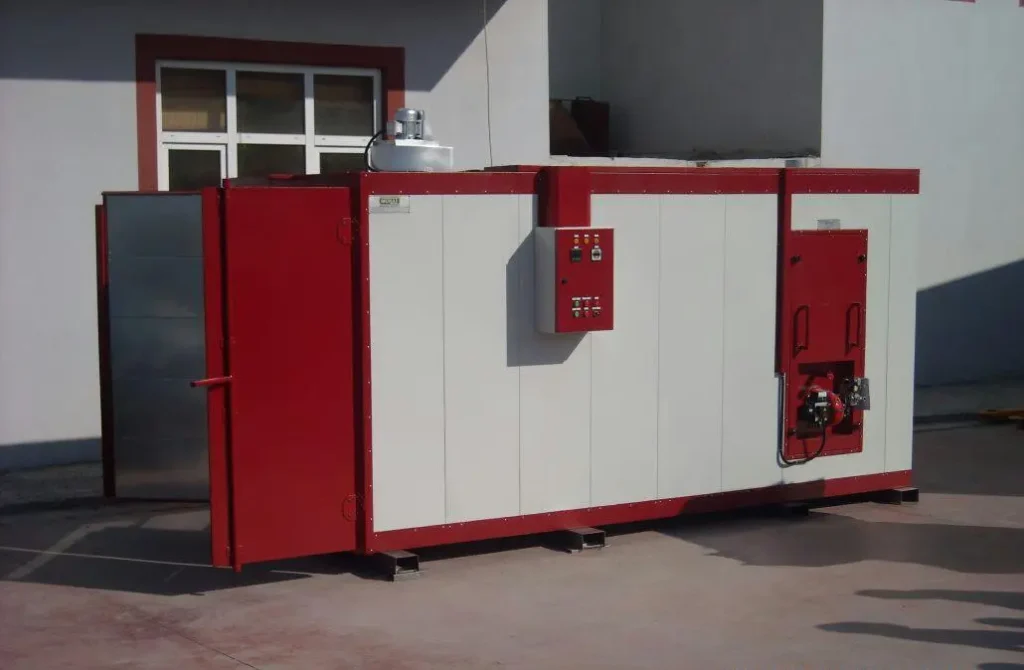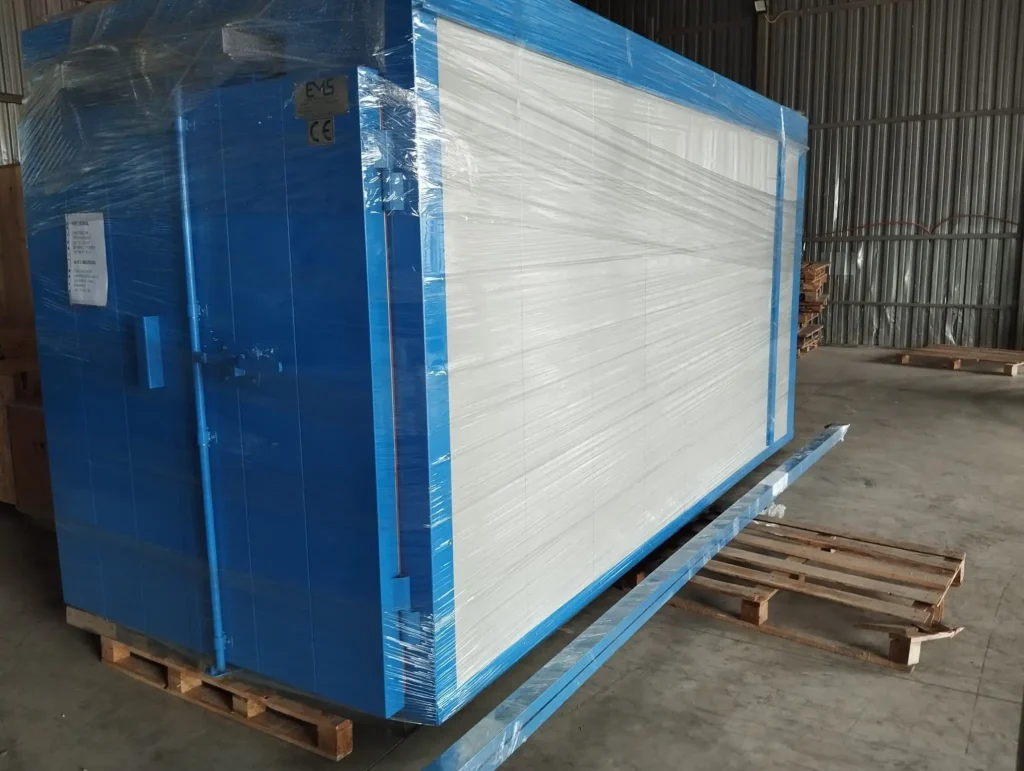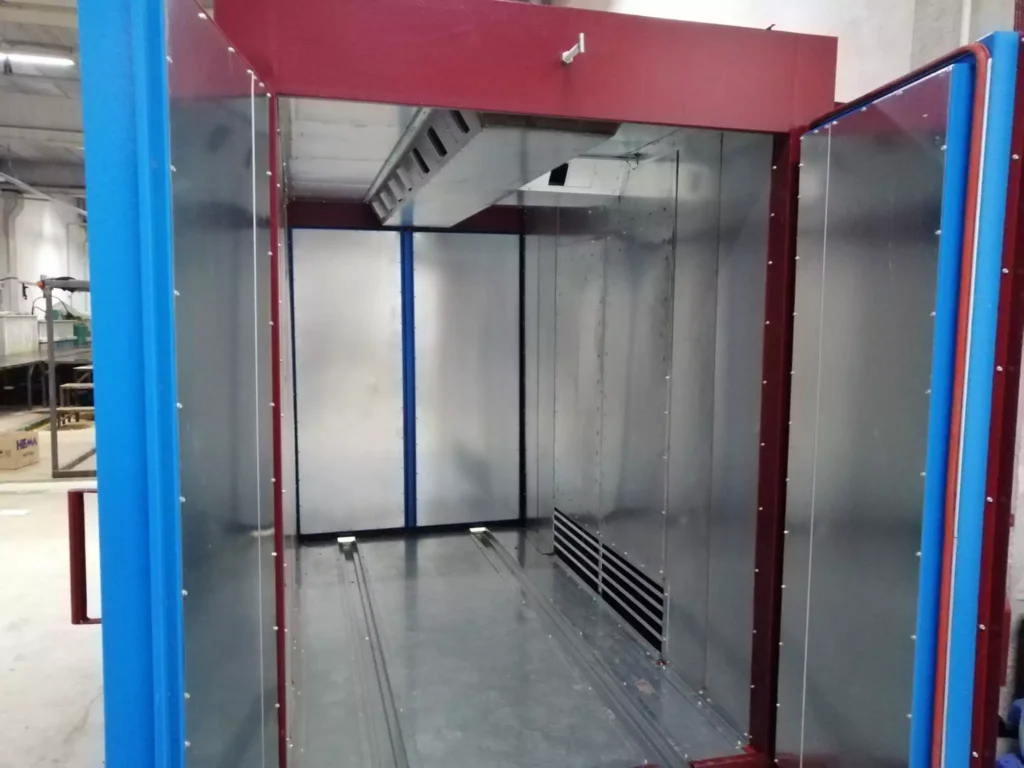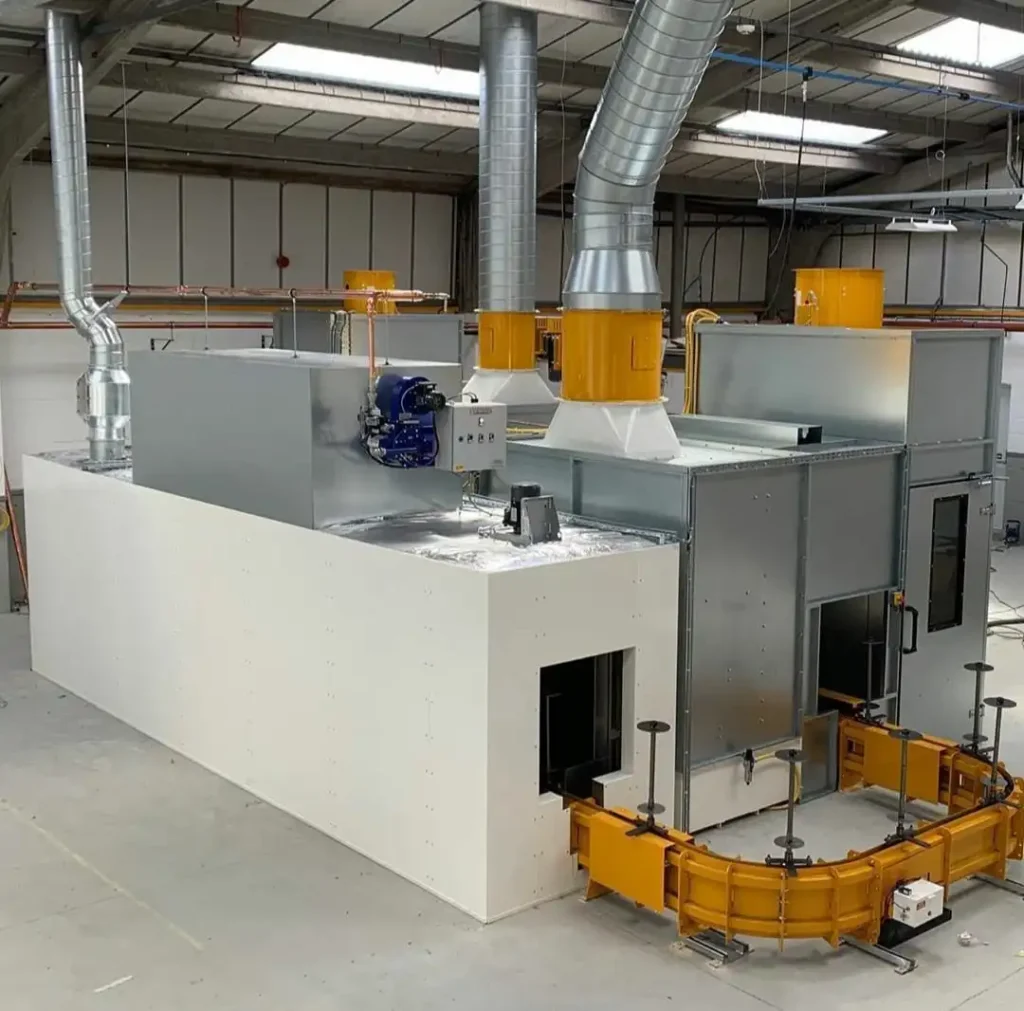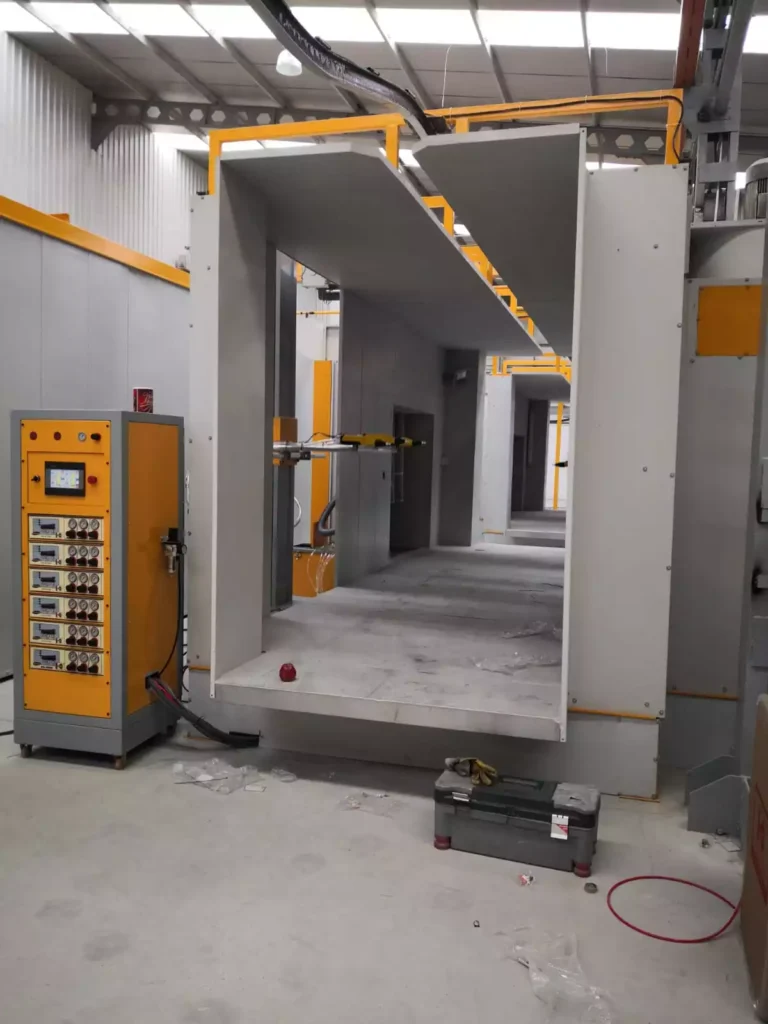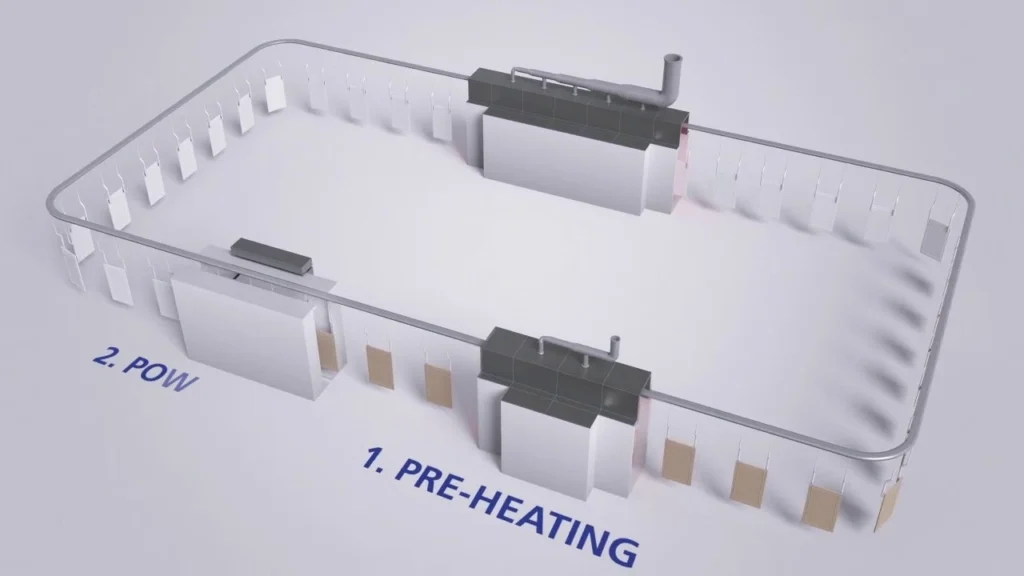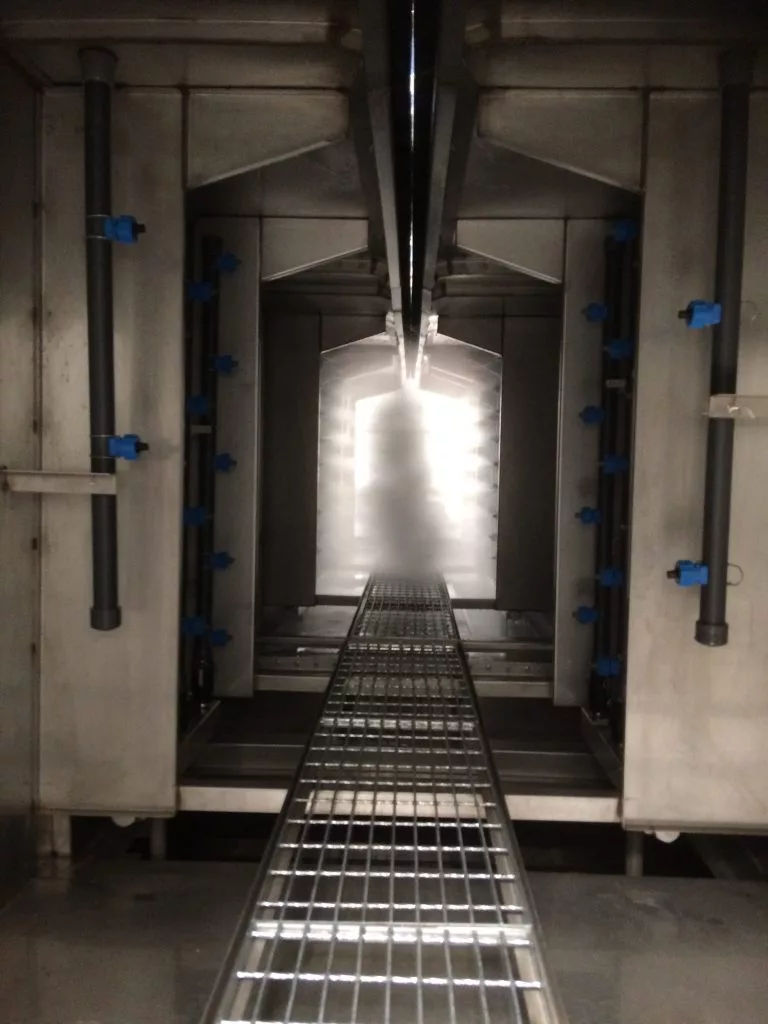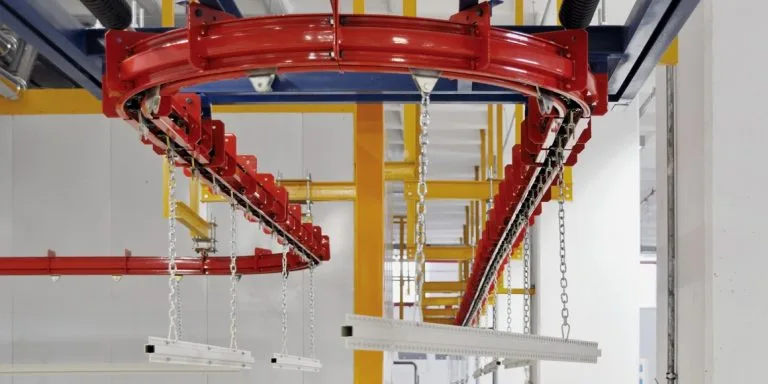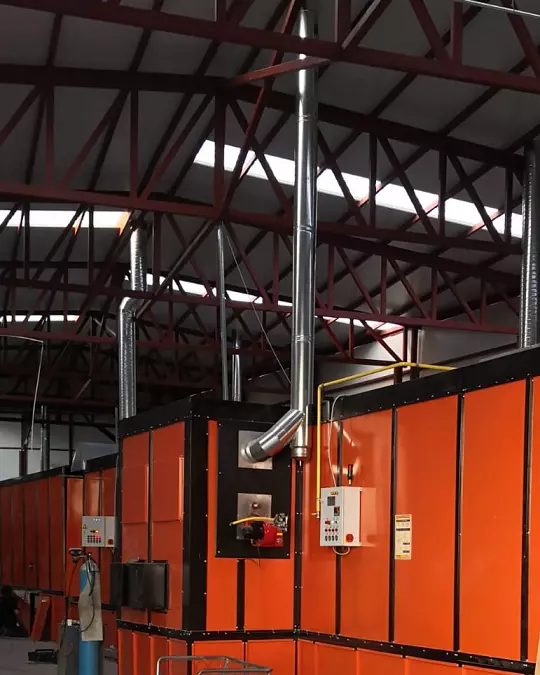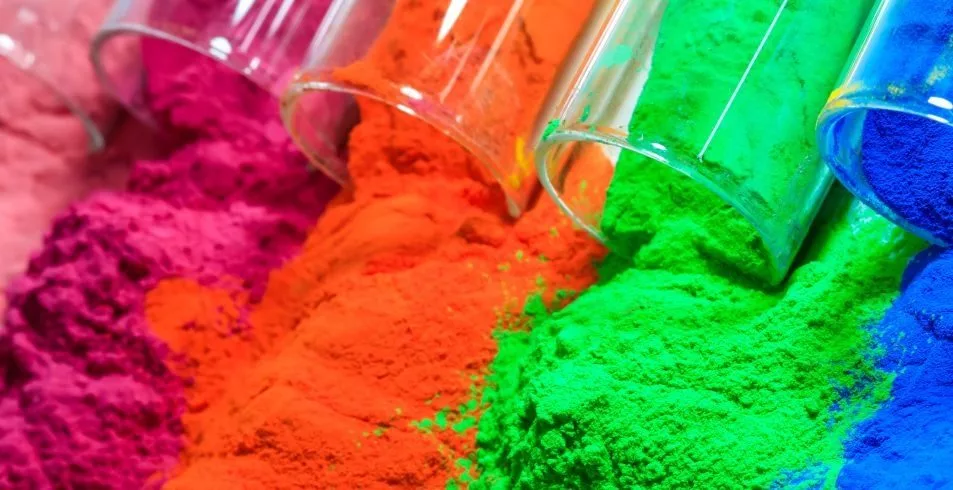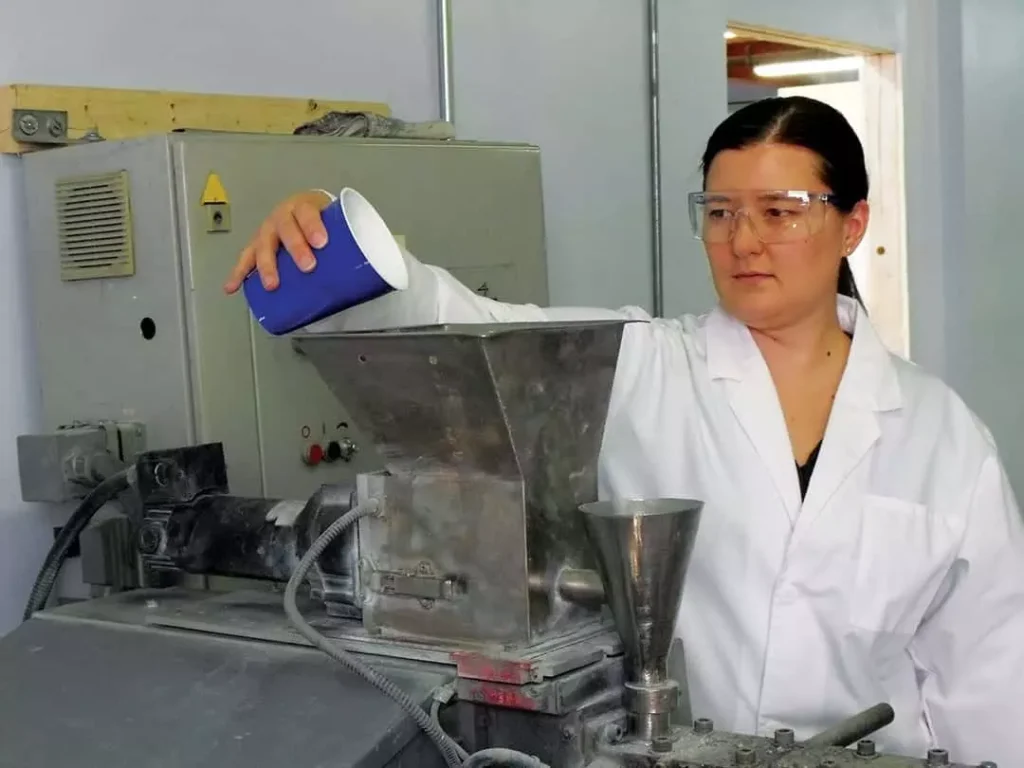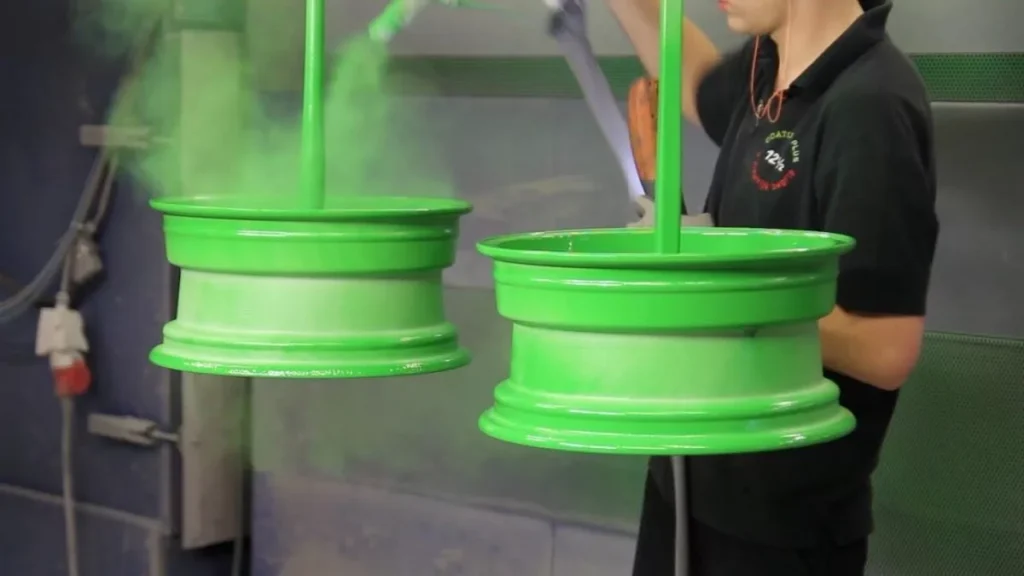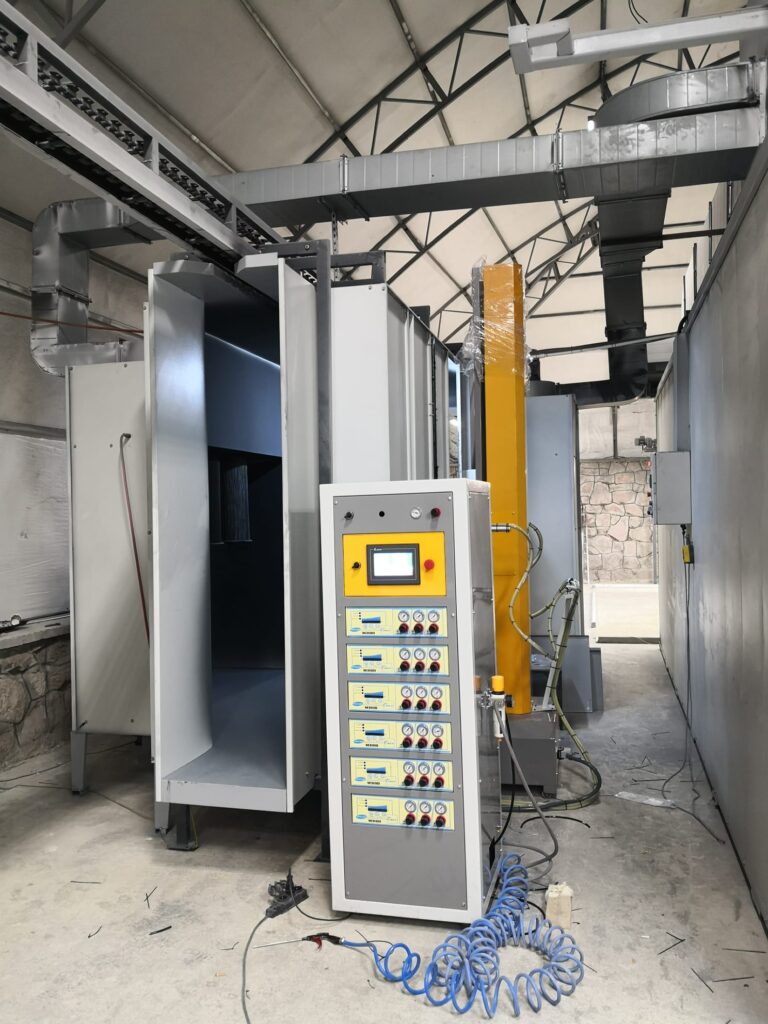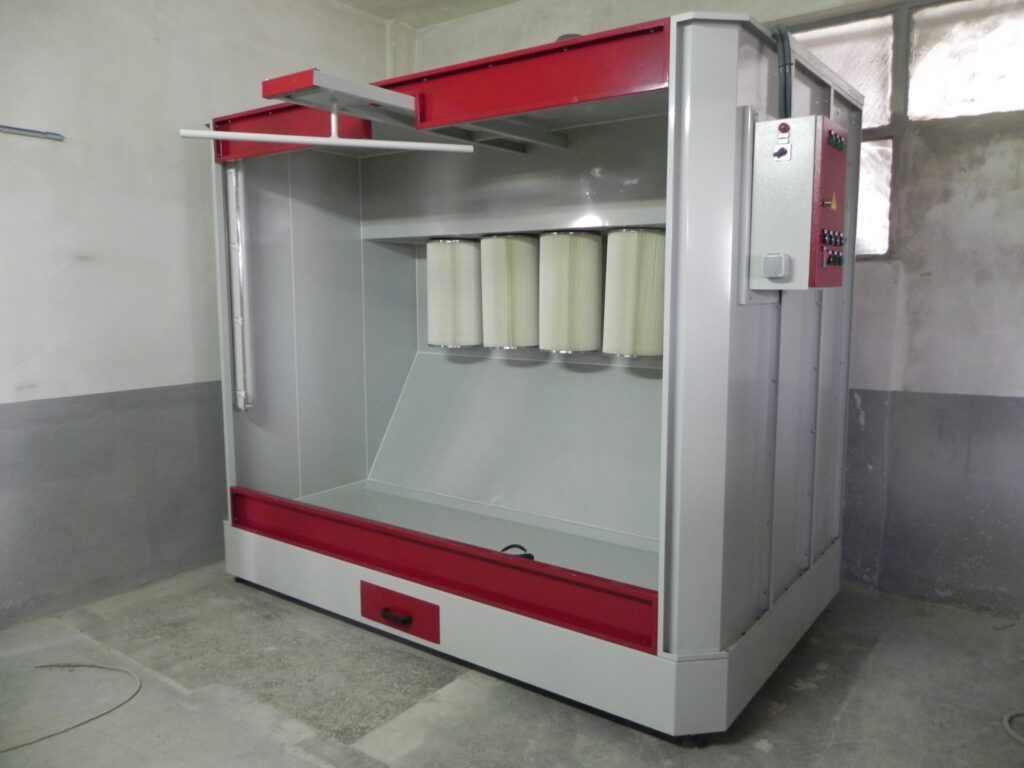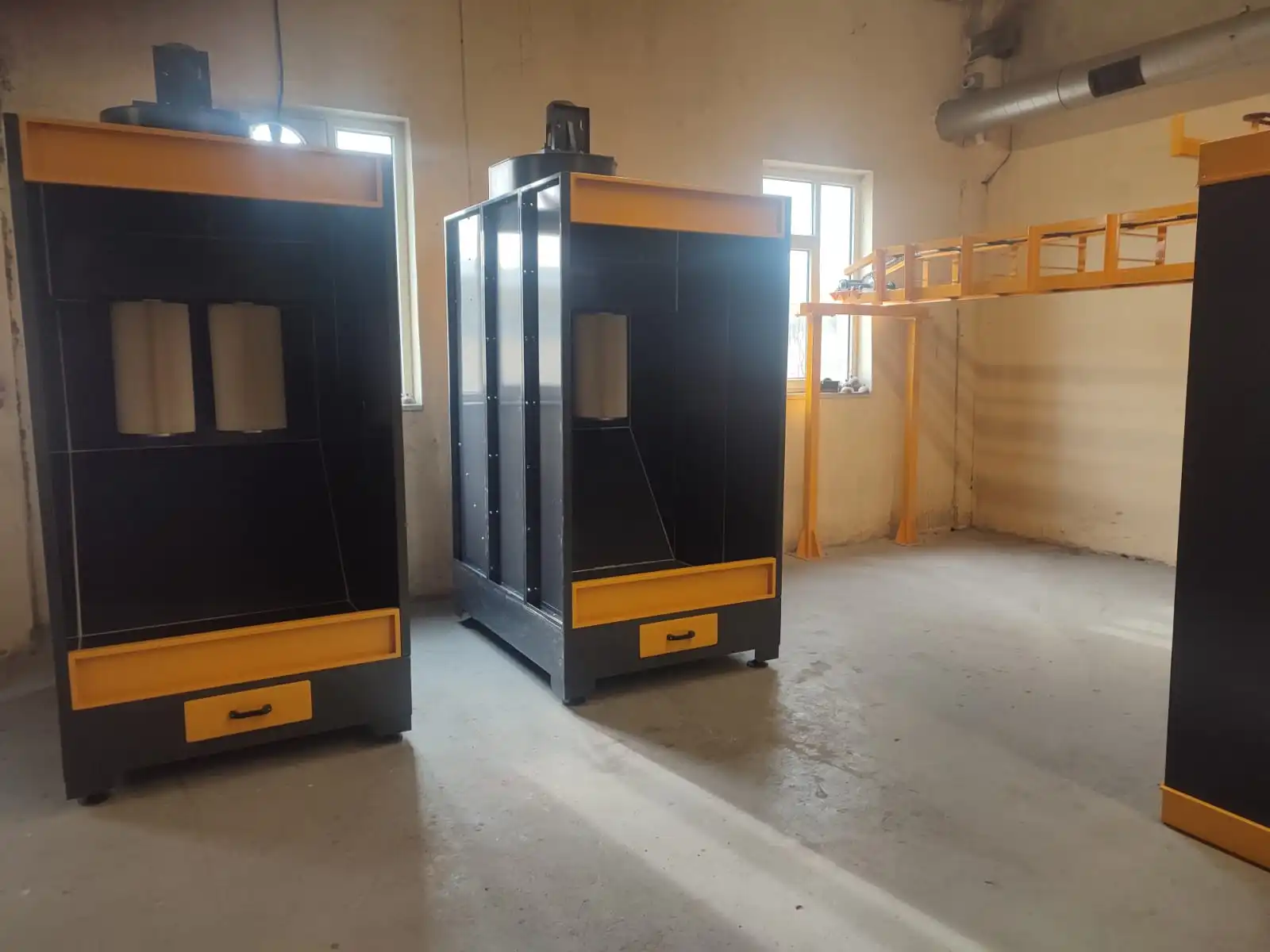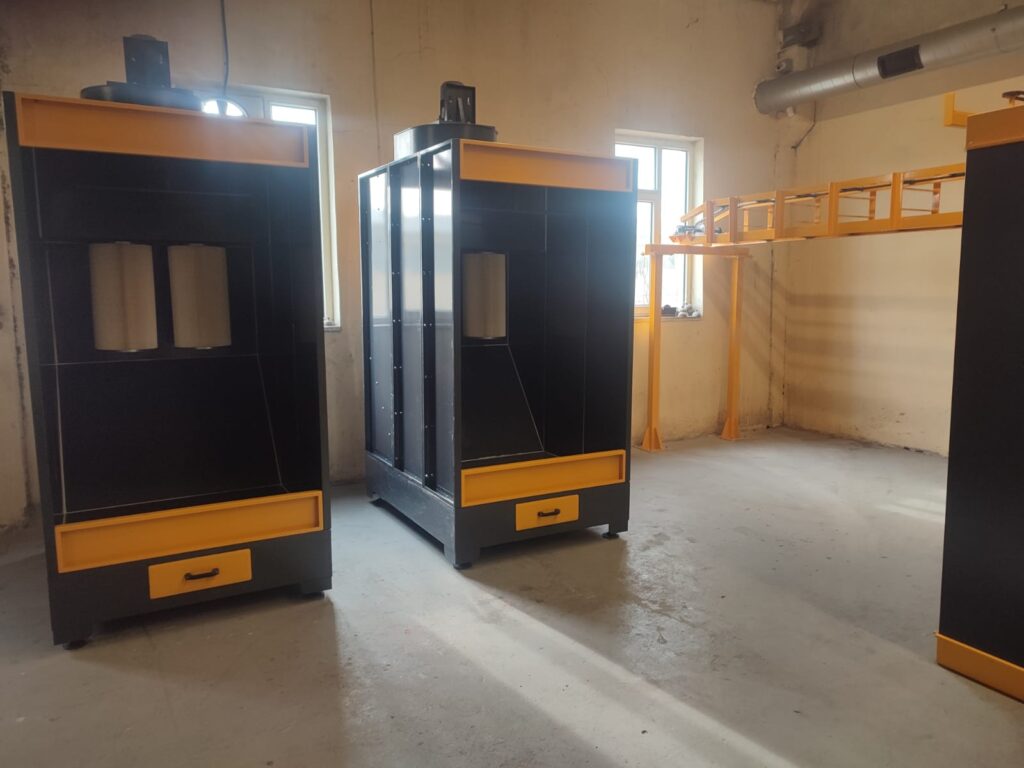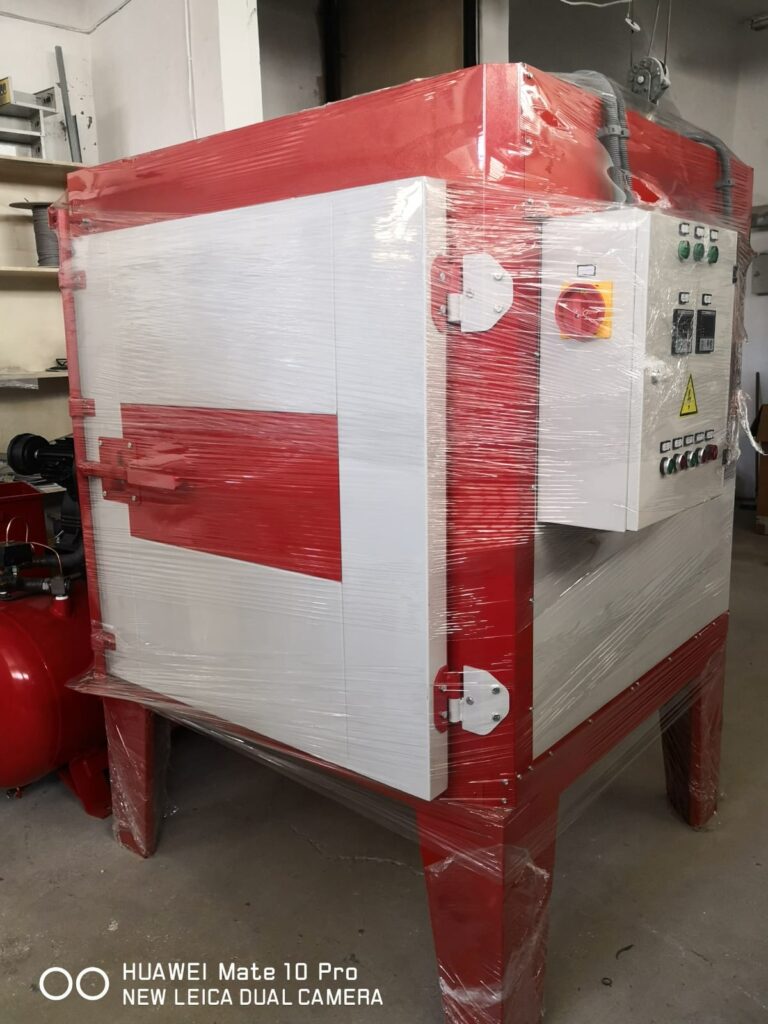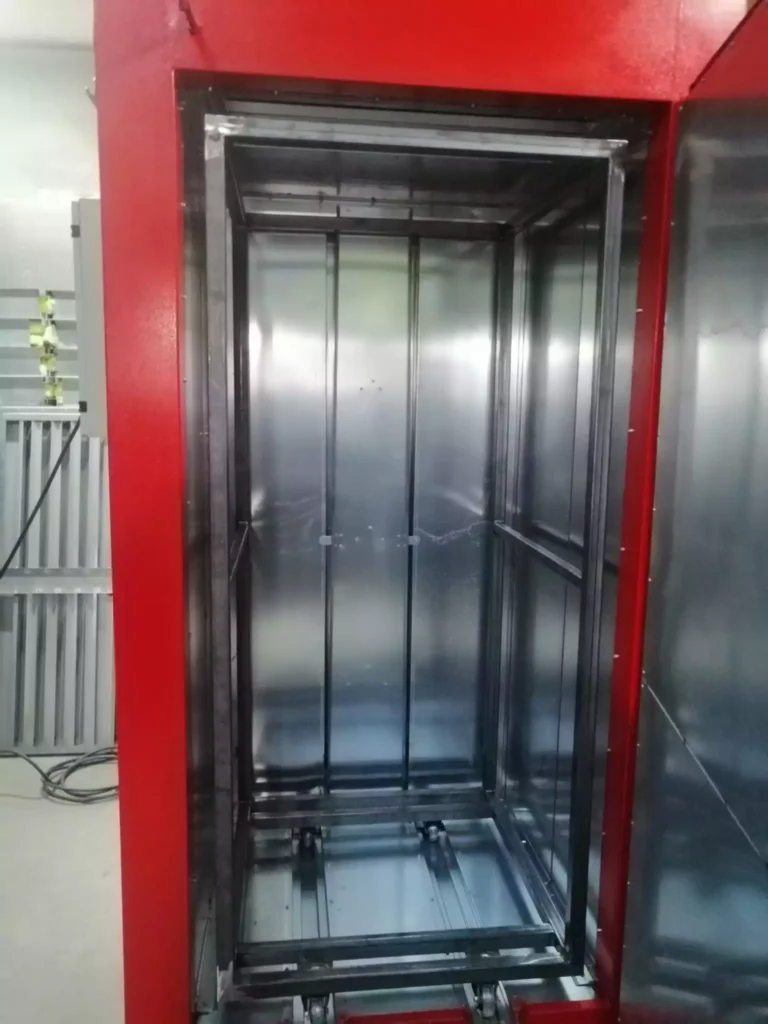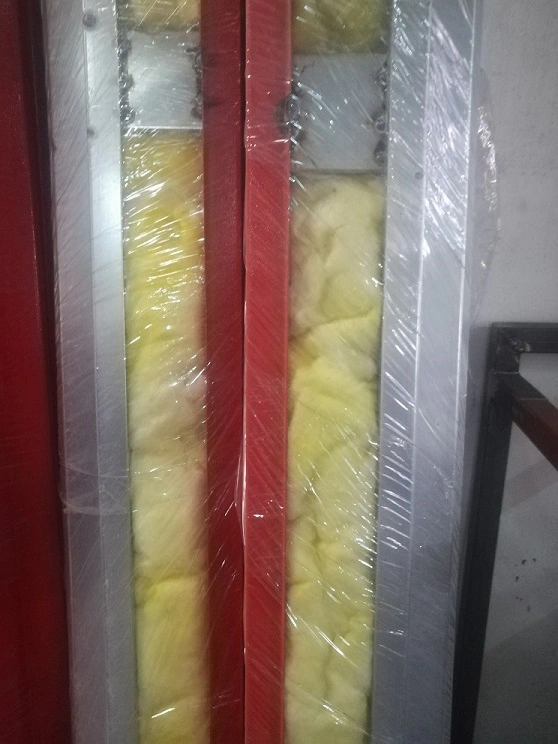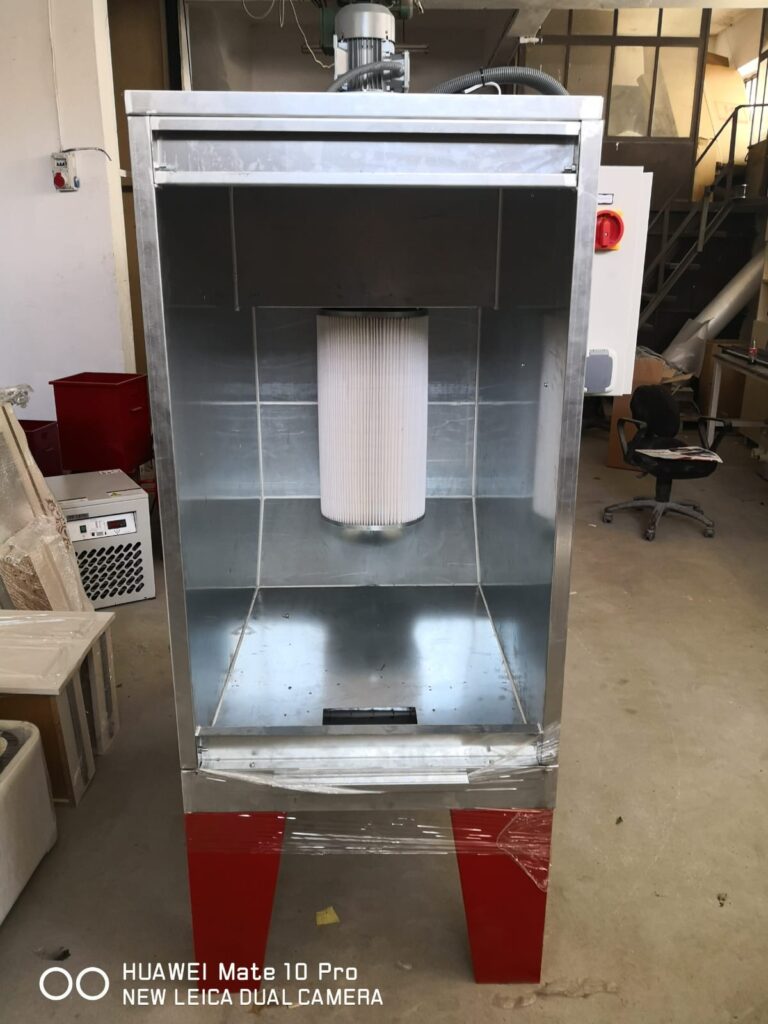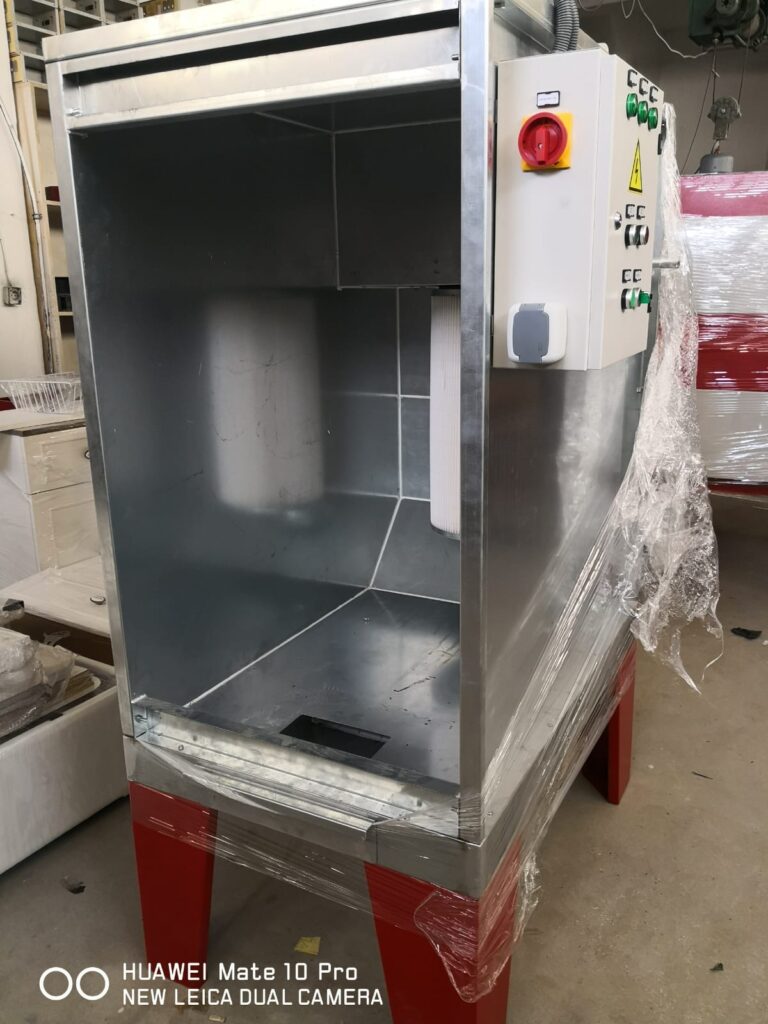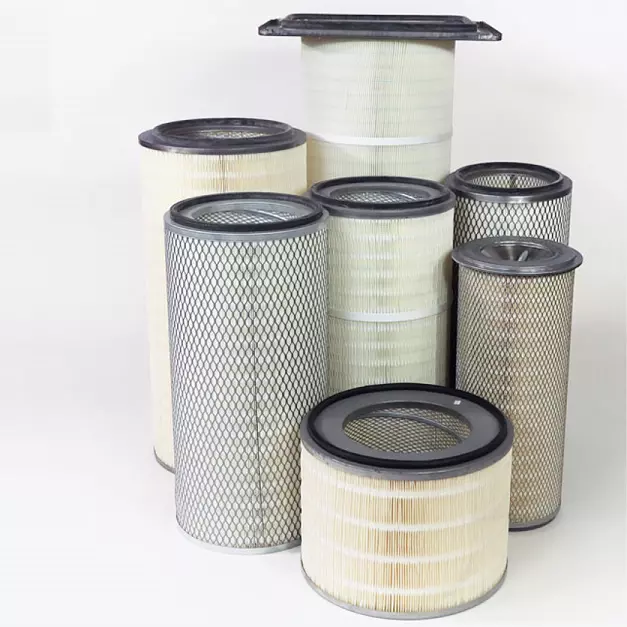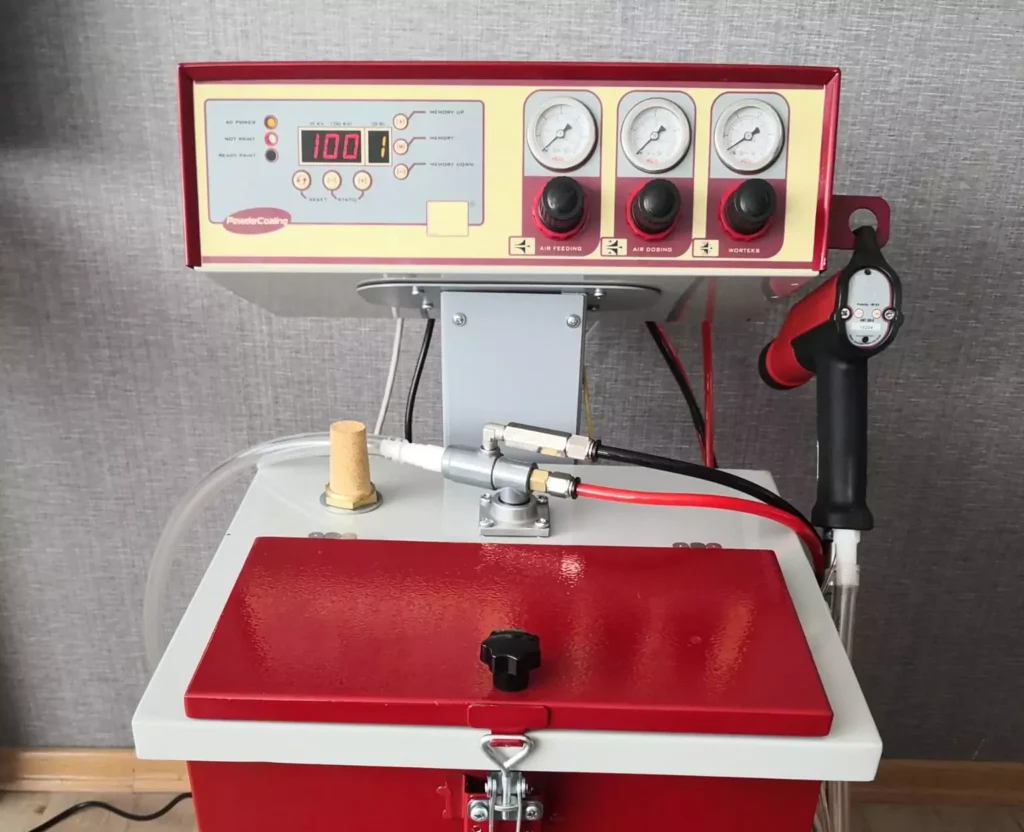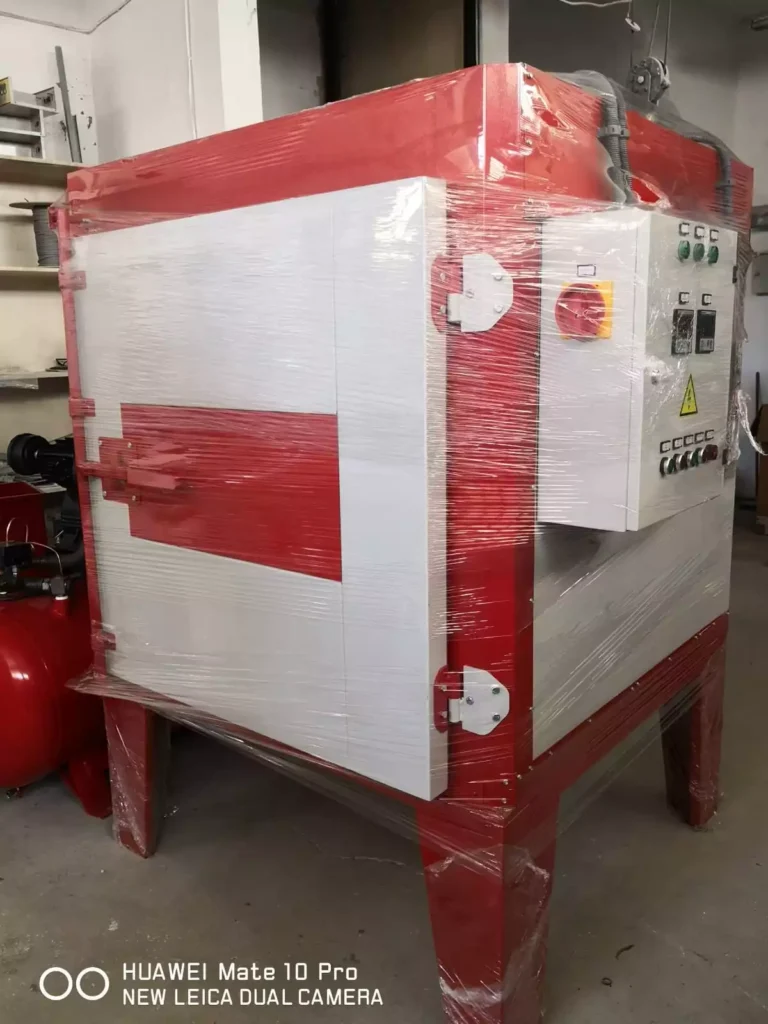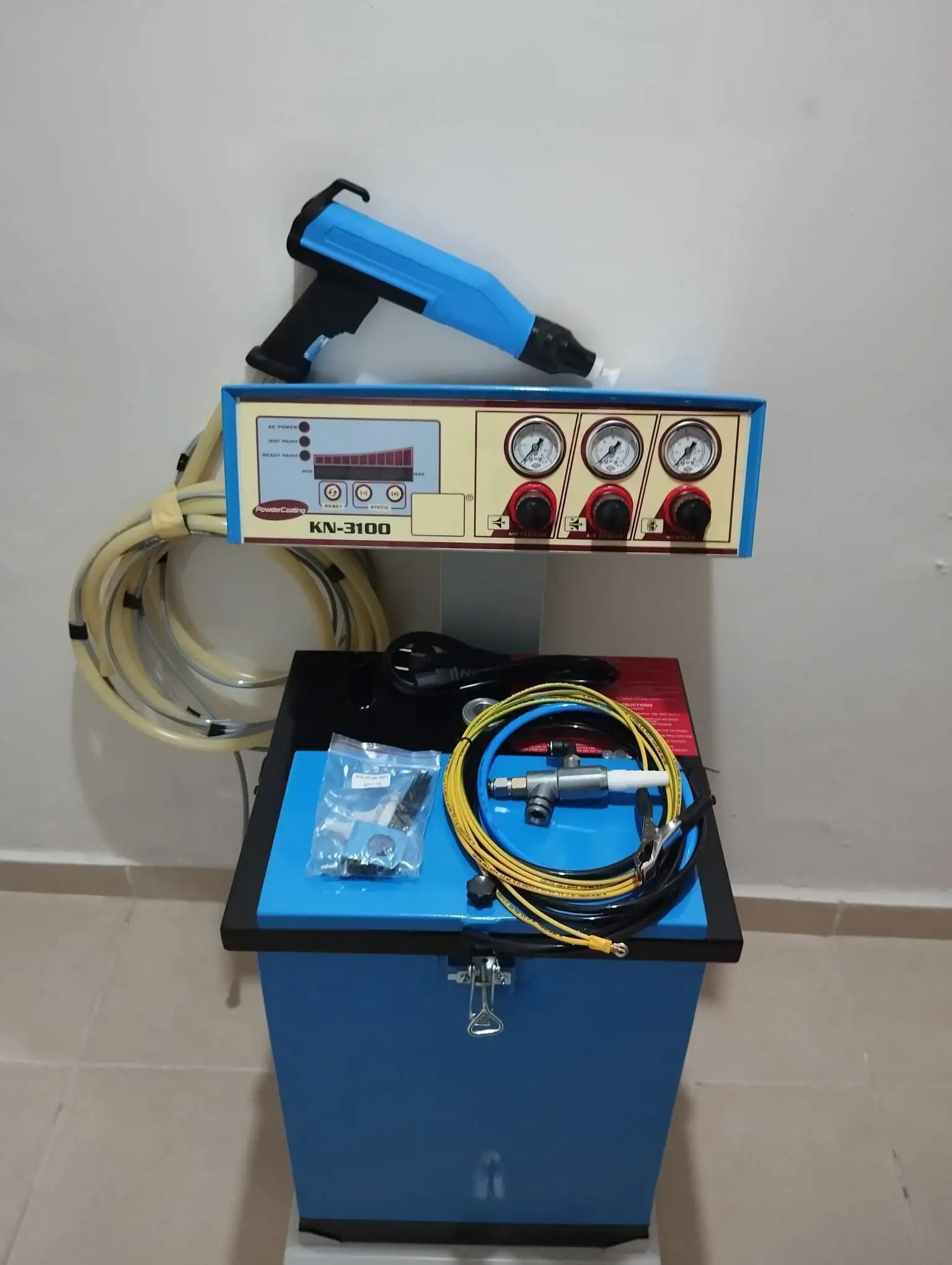
A powder coating machine or a powder coating spray gun is a device that coats a metallic surface with electrostatically charged powder coating powder.
Any powder coating company that uses coating systems needs to have an electrostatic powder coating machine or a Tribo powder coating machine.
A powder coating machine is a device used to apply powder coating to a substrate. It consists of a powder coating gun, a powder coating hopper, and a power supply. The powder coating gun is used to electrostatically charge the powder particles and then spray them onto the substrate. The powder coating hopper is used to store the powder coating powder. The power supply is used to provide the high voltage needed to charge the powder particles.
Powder coating machines are used in a variety of industries, including automotive, appliance, furniture, electronics, and industrial. They are also used by hobbyists and DIYers.
Types of powder coating machines:
There are two main types of powder coating machines: electrostatic and tribostatic.
- Electrostatic powder coating machines: Electrostatic powder coating machines use a high voltage corona discharge to charge the powder particles. This creates a static charge on the powder particles, which causes them to adhere to the substrate. Electrostatic powder coating machines are typically used for high-volume applications.
- Tribostatic powder coating machines: Tribostatic powder coating machines use friction to charge the powder particles. This is done by passing the powder particles through a tribostatic head, which creates a static charge on the powder particles. Tribostatic powder coating machines are typically used for low-volume applications and for coating complex shapes.
Benefits of using a powder coating machine:
There are many benefits to using a powder coating machine, including:
- Durability: Powder coating is a very durable finish that can resist chipping, scratching, and fading. This makes it ideal for a variety of applications, including automotive parts, appliances, and furniture.
- Corrosion resistance: Powder coating is also highly resistant to corrosion. This makes it ideal for applications where the substrate is exposed to the elements, such as outdoor furniture and marine equipment.
- Environmental friendliness: Powder coating is an environmentally friendly process. It does not produce any volatile organic compounds (VOCs), which are harmful to the environment.
Tips for using a powder coating machine safely and effectively:
Here are some tips for using a powder coating machine safely and effectively:
- Always wear appropriate personal protective equipment (PPE), such as gloves, safety glasses, and a respirator, when using a powder coating machine.
- Make sure the powder coating machine is properly grounded to prevent static electricity buildup.
- Clean the powder coating machine regularly to remove powder coating particles and debris.
- Inspect the powder coating machine regularly for signs of wear or damage.
- Follow the manufacturer’s instructions for operating the powder coating machine.
By following these tips, you can help to ensure that your powder coating machine is used safely and effectively to produce high-quality powder coated products.
Electrostatic powder coating machine
Electrostatic powder coating machines are the most common type of powder coating machine. They use a high voltage corona discharge to charge the powder particles. This creates a static charge on the powder particles, which causes them to adhere to the substrate.
Electrostatic powder coating machines are typically used for high-volume applications, such as in automotive manufacturing and appliance manufacturing. They are also used by smaller businesses and hobbyists.
Benefits of using an electrostatic powder coating machine:
- High efficiency: Electrostatic powder coating machines are very efficient at transferring powder coating to the substrate. This reduces waste and helps to produce a high-quality finish.
- Uniform coverage: Electrostatic powder coating machines provide uniform coverage of the substrate. This is important for applications where a consistent finish is required.
- Variable coating thickness: Electrostatic powder coating machines can be used to apply a variable coating thickness to the substrate. This is useful for applications where different levels of protection are required.
Tips for using an electrostatic powder coating machine safely and effectively:
- Always wear appropriate personal protective equipment (PPE), such as gloves, safety glasses, and a respirator, when using an electrostatic powder coating machine.
- Make sure the powder coating machine is properly grounded to prevent static electricity buildup.
- Clean the powder coating machine regularly to remove powder coating particles and debris.
- Inspect the powder coating machine regularly for signs of wear or damage.
- Follow the manufacturer’s instructions for operating the powder coating machine.
Here are some additional tips for using an electrostatic powder coating machine:
- Use the correct powder coating gun and settings for the job.
- Apply the powder coating in a thin, even coat.
- Make sure the substrate is properly grounded before powder coating.
- Cure the powder coating properly to ensure a durable finish.
By following these tips, you can help to ensure that your electrostatic powder coating machine is used safely and effectively to produce high-quality powder coated products.
Tribostatic powder coating machines
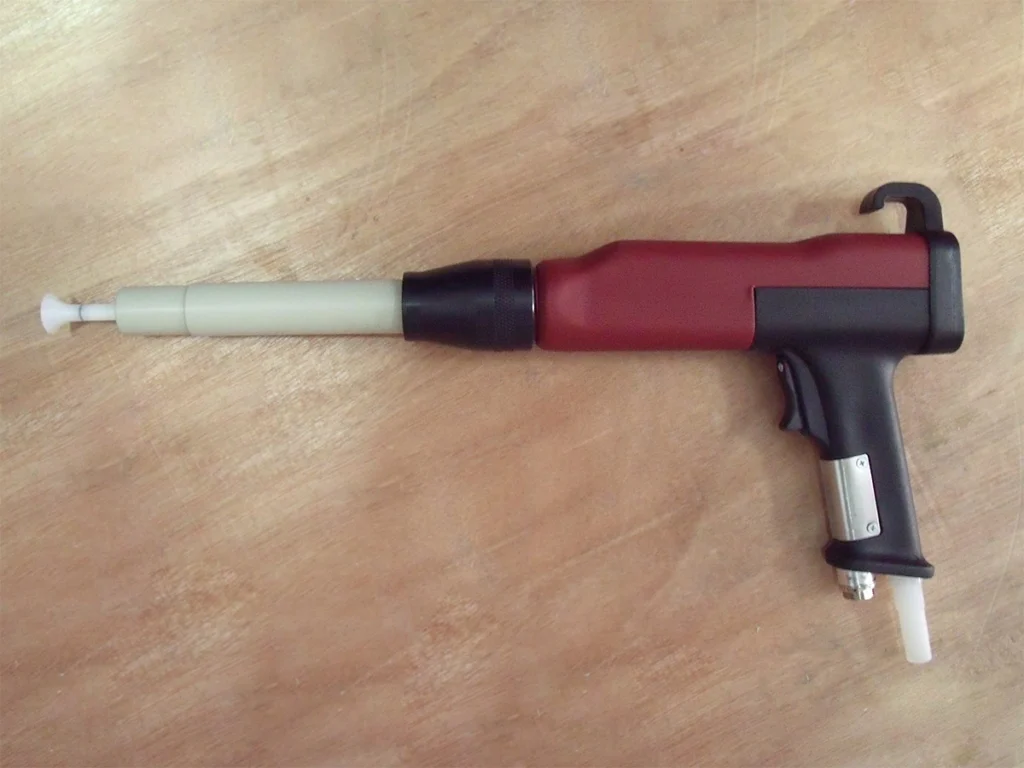
Tribostatic powder coating machines use friction to charge the powder particles. This is done by passing the powder particles through a tribostatic head, which creates a static charge on the powder particles.
Tribostatic powder coating machines are typically used for low-volume applications, such as in job shops and custom manufacturing. They are also used for coating complex shapes and hard-to-reach areas.
Benefits of using a tribostatic powder coating machine:
- Versatility: Tribostatic powder coating machines can be used to coat a wide variety of substrates, including metals, plastics, and wood. They can also be used to coat complex shapes and hard-to-reach areas.
- Portability: Tribostatic powder coating machines are typically more portable than electrostatic powder coating machines. This makes them ideal for use in small shops and on-site applications.
- Cost-effectiveness: Tribostatic powder coating machines are typically less expensive than electrostatic powder coating machines. This makes them a good option for low-volume applications and small businesses.
Tips for using a tribostatic powder coating machine safely and effectively:
- Always wear appropriate personal protective equipment (PPE), such as gloves, safety glasses, and a respirator, when using a tribostatic powder coating machine.
- Make sure the tribostatic head is properly grounded to prevent static electricity buildup.
- Clean the tribostatic head regularly to remove powder coating particles and debris.
- Inspect the tribostatic head regularly for signs of wear or damage.
- Follow the manufacturer’s instructions for operating the tribostatic powder coating machine.
Here are some additional tips for using a tribostatic powder coating machine:
- Use the correct powder coating gun and settings for the job.
- Apply the powder coating in a thin, even coat.
- Make sure the substrate is properly grounded before powder coating.
- Cure the powder coating properly to ensure a durable finish.
By following these tips, you can help to ensure that your tribostatic powder coating machine is used safely and effectively to produce high-quality powder coated products.
Additional benefits of tribostatic powder coating machines:
- Reduced Faraday cage effect: Tribostatic powder coating machines are less susceptible to the Faraday cage effect than electrostatic powder coating machines. This means that they can be used to coat complex shapes and hard-to-reach areas more effectively.
- Improved finish quality: Tribostatic powder coating machines can produce a smoother finish with less orange peel than electrostatic powder coating machines. This is because the tribostatic charging process creates a more uniform charge on the powder particles.
Overall, tribostatic powder coating machines are a versatile and cost-effective option for a variety of powder coating applications.
Powder Coating Machine Manufacturer
Our powder coating machine or powder coating paint machine is our own production, manufactured in our facility in Turkey. The powder paint machine is made in 2 different versions, depending on their usage
- Tribo powder coating gun
- Corona powder coating gun
Tribo Powder Coating Equipment
Tribo powder coating equipment doesn’t have electrical charging parts in them (also called as cascades) and they charge the powder coating powder by friction of the powder to the inside pipes of the gun. This friction charges the particle because of this, the barrels of the tribo guns are longer in comparison to the corona guns.

In the tribo equipment, the operator can’t change the charging values such as voltage and current but can only change the air volume. As Tribo guns have less electronic parts, they are more resistant to breakdowns and have longer service lives.
Corona Powder Coating Equipment
Corona is the type of powder coating equipment where the charging is carried out by the cascade in the powder spray gun. The cascade is a voltage-increasing electronic component that applies high voltage and low current onto the passing powder particles to let them stick on the parts they are flying to.
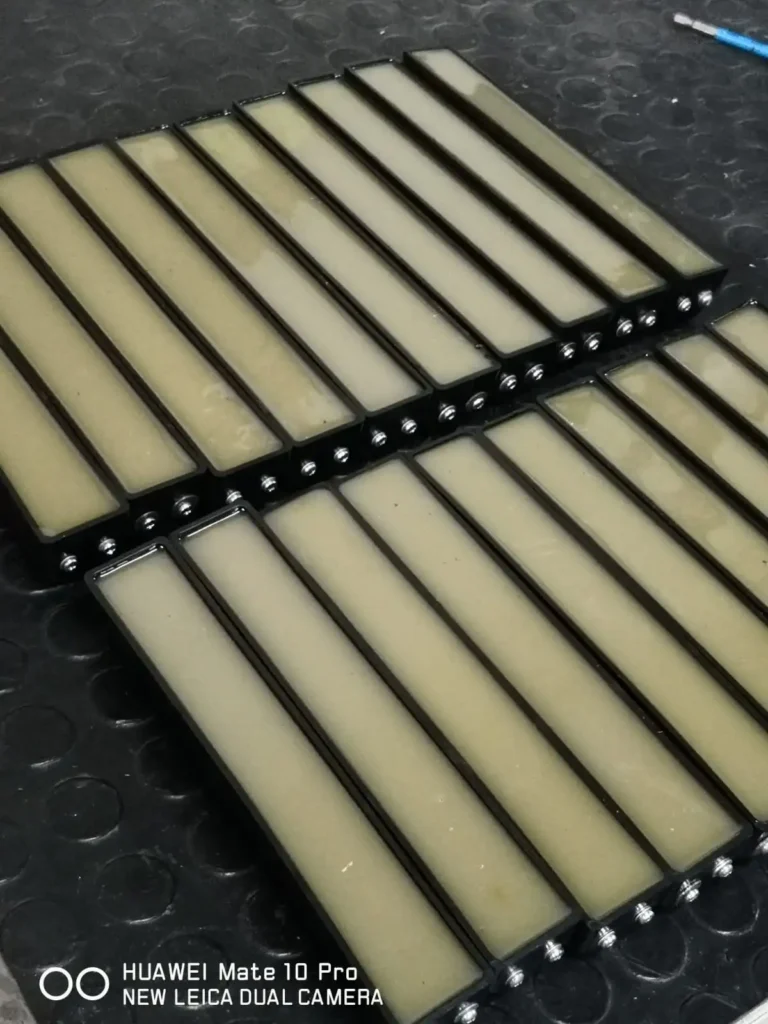
The cascades are voltage-increasing parts of a powder coating gun and is located on the plastic pipe where the powder coating particles are passing.

As the other parts of the powder coating machines, we also manufacture our own powder coating guns and cascades inside. Our guns have 2 years of guarantee.
How to use powder coating equipment?
To use powder coating equipment, you will need the following:
- A powder coating machine
- A powder coating gun
- Powder coating powder
- A curing oven
- Personal protective equipment (PPE), including gloves, safety glasses, and a respirator
Instructions:
- Prepare the substrate. Make sure the substrate is clean and free of any dirt, grease, or oil.
- Ground the substrate. This will prevent static electricity buildup.
- Apply the powder coating powder. Use the powder coating gun to apply a thin, even coat of powder coating powder to the substrate.
- Cure the powder coating. Place the substrate in the curing oven and cure the powder coating according to the manufacturer’s instructions.
- Inspect the finish. Once the powder coating has cured, inspect the finish for any defects. If necessary, you can reapply the powder coating powder and cure it again.
Here are some additional tips for using powder coating equipment:
- Use the correct powder coating powder for the job. There are different types of powder coating powder available, each with its own unique properties. Make sure to choose a powder coating powder that is compatible with the substrate and that will produce the desired finish.
- Use the correct powder coating gun settings. The powder coating gun settings will affect the thickness and uniformity of the powder coating finish. Make sure to adjust the powder coating gun settings according to the manufacturer’s instructions.
- Apply the powder coating powder in a thin, even coat. A thick coat of powder coating powder will be more likely to crack or peel.
- Cure the powder coating properly. The curing process is essential for producing a durable powder coating finish. Make sure to follow the manufacturer’s instructions for curing the powder coating.
Safety tips:
- Always wear appropriate PPE when using powder coating equipment. Powder coating powder can be harmful if inhaled, so it is important to wear a respirator.
- Make sure the powder coating machine is properly grounded to prevent static electricity buildup.
- Clean the powder coating machine and gun regularly to remove powder coating powder and debris.
- Inspect the powder coating machine and gun regularly for signs of wear or damage.
By following these instructions and safety tips, you can safely and effectively use powder coating equipment to produce high-quality powder coated products.
How does a powder coating machine operate?
A powder coating machine operates by using a high-voltage electrical charge to attract powder coating particles to a grounded substrate. The powder coating particles are then cured using heat or UV light to form a durable finish.
Here is a step-by-step overview of how a powder coating machine works:
- The powder coating powder is loaded into the powder coating machine’s hopper.
- The powder coating machine uses a compressed air source to fluidize the powder coating powder. This means that the powder coating powder is suspended in a cloud of air.
- The powder coating powder is then electrostatically charged using a high-voltage corona discharge. This gives the powder coating particles a positive electrical charge.
- The powder coating gun is used to spray the electrostatically charged powder coating particles onto the grounded substrate.
- The powder coating particles adhere to the grounded substrate because of the opposite electrical charges.
- The powder coating particles are then cured using heat or UV light to form a durable finish.
Here are some of the key components of a powder coating machine:
- Powder coating hopper: The powder coating hopper is used to store the powder coating powder.
- Fluidized bed: The fluidized bed is used to fluidize the powder coating powder.
- Corona discharge: The corona discharge is used to electrostatically charge the powder coating particles.
- Powder coating gun: The powder coating gun is used to spray the electrostatically charged powder coating particles onto the grounded substrate.
- Curing oven: The curing oven is used to cure the powder coating particles using heat or UV light.
Powder coating machines are available in a variety of sizes and configurations to meet the needs of different businesses. Small powder coating machines are typically used for low-volume applications, such as hobbyists and small businesses. Large powder coating machines are typically used for high-volume applications, such as automotive manufacturing and appliance manufacturing.
Benefits of using a powder coating machine:
Powder coating machines offer a number of benefits, including:
- Durability: Powder coating is a very durable finish that can resist chipping, scratching, and fading. This makes it ideal for a variety of applications, including automotive parts, appliances, and furniture.
- Corrosion resistance: Powder coating is also highly resistant to corrosion. This makes it ideal for applications where the substrate is exposed to the elements, such as outdoor furniture and marine equipment.
- Environmental friendliness: Powder coating is an environmentally friendly process. It does not produce any volatile organic compounds (VOCs), which are harmful to the environment.
Overall, powder coating machines are a versatile and cost-effective way to apply a durable and environmentally friendly finish to a variety of substrates.
Control Panel:
The control panel of a powder coating machine serves as the nerve center, orchestrating the various functions and parameters of the entire system. It’s a sophisticated interface that allows operators to monitor, adjust, and control every aspect of the powder coating process. Here’s a detailed breakdown of its functions:
- Operation Control: The control panel enables operators to start, stop, and pause the powder coating process with precision. This functionality ensures that the system operates only when necessary, optimizing energy usage and minimizing downtime.
- Parameter Adjustment: Operators can fine-tune critical parameters such as powder flow rate, voltage settings, air pressure, and curing temperature directly from the control panel. This flexibility allows for precise adjustments tailored to the specific requirements of each job, ensuring consistent coating quality and performance.
- System Monitoring: The control panel provides real-time monitoring of key system metrics, including powder usage, voltage levels, airflow rates, and oven temperature. This monitoring capability enables operators to detect and address any deviations or abnormalities in the process promptly, preventing potential defects or failures.
- Alarm and Alert System: In the event of system malfunctions, errors, or out-of-spec conditions, the control panel triggers audible and visual alarms to alert operators. These alerts prompt immediate intervention, minimizing production disruptions and ensuring product quality and safety.
- Data Logging and Reporting: Modern control panels often feature data logging and reporting capabilities, allowing operators to record process parameters, production metrics, and quality control data over time. This historical data can be analyzed to identify trends, optimize process performance, and comply with quality management standards and regulations.
- User Interface: The control panel boasts an intuitive user interface with touchscreen displays, buttons, and menus that simplify operation and navigation. Clear visual indicators, status lights, and error messages help operators quickly understand the system’s status and take appropriate actions.
- Safety Interlocks: To ensure operator safety, the control panel may incorporate safety interlocks that prevent unauthorized access or operation of the equipment. These interlocks may include password protection, key switches, or physical barriers to safeguard against accidental injury or misuse.
- Remote Monitoring and Control: Advanced control panels may offer remote monitoring and control capabilities, allowing operators to access and manage the system from remote locations via network connectivity. This feature enhances operational flexibility, enabling remote troubleshooting, diagnostics, and adjustments for increased uptime and efficiency.
Overall, the control panel is a critical component of the powder coating machine, providing operators with centralized control, monitoring, and management of the entire coating process. Its advanced features and functionalities empower operators to achieve optimal results, maximize productivity, and maintain stringent quality standards across diverse powder coating applications.
Powder Coating Gun:
The powder coating gun is a fundamental component of the powder coating process, responsible for applying the powder coating material onto the surface of the workpiece. It plays a crucial role in determining the quality, efficiency, and consistency of the coating application. Here’s an in-depth look at the various aspects and functionalities of the powder coating gun:
- Material Handling: The powder coating gun is designed to handle and deliver the powder coating material from the powder supply to the workpiece surface. It ensures precise control over the flow and distribution of the powder, allowing for uniform coverage and thickness.
- Electrostatic Charging: One of the key features of the powder coating gun is its ability to impart electrostatic charge to the powder particles as they exit the gun. This electrostatic charging creates a strong attraction between the powder particles and the grounded workpiece, resulting in efficient and uniform coating deposition.
- Nozzle Design: The nozzle of the powder coating gun plays a critical role in shaping and directing the flow of powder onto the workpiece surface. Different nozzle designs, such as round, fan, or deflector nozzles, offer varying spray patterns and coverage options to suit different part geometries and coating requirements.
- Adjustable Settings: Powder coating guns typically feature adjustable settings that allow operators to fine-tune various parameters such as powder flow rate, spray pattern, and electrostatic charge intensity. These adjustments enable precise control over the coating process, ensuring optimal results for different applications.
- Trigger Mechanism: The trigger mechanism on the powder coating gun controls the release of powder material and initiates the coating process. Operators can activate the trigger to start and stop the powder flow as needed, providing flexibility and control during the coating operation.
- Gun Body and Handle: The ergonomic design of the powder coating gun body and handle ensures comfortable and fatigue-free operation for the operator. It allows for extended use without causing strain or discomfort, enhancing productivity and efficiency in powder coating operations.
- Compatibility with Coating Materials: Powder coating guns are designed to be compatible with a wide range of powder coating materials, including epoxy, polyester, polyurethane, and hybrid powders. They can accommodate different powder particle sizes, densities, and formulations, making them versatile tools for various coating applications.
- Maintenance and Cleaning: Proper maintenance and cleaning of the powder coating gun are essential to ensure consistent performance and prolong its lifespan. Routine maintenance tasks may include disassembly, cleaning of components, inspection for wear or damage, and lubrication of moving parts.
- Safety Features: Powder coating guns may incorporate safety features such as trigger locks, safety switches, and grounding provisions to prevent accidents, injuries, or electrostatic discharge hazards during operation. These safety mechanisms ensure operator safety and protect the integrity of the coating process.
Overall, the powder coating gun is a critical component of the powder coating system, offering precise control, versatility, and efficiency in the application of powder coatings onto various substrates. Its advanced features and functionalities make it an indispensable tool for achieving high-quality, durable, and visually appealing finishes in powder coating applications across diverse industries.
High Voltage Generator:
The high voltage generator is a vital component of a powder coating system, responsible for generating the high voltage required to charge the powder particles as they are applied to the workpiece surface. This charged powder is then attracted to the grounded workpiece, resulting in efficient and uniform coating deposition. Here’s a detailed explanation of the functions and operation of the high voltage generator:
- Voltage Generation: The primary function of the high voltage generator is to produce the high electrical voltage necessary for electrostatic powder coating. Typically, voltages ranging from 50 kV to 100 kV or higher are generated to create a strong electrostatic field between the powder particles and the grounded workpiece.
- Electrical Circuit: The high voltage generator utilizes sophisticated electrical circuits and components to step up the input voltage from the power supply to the desired output voltage level. This voltage amplification process may involve transformers, capacitors, diodes, and other electronic components to achieve the required voltage boost.
- Voltage Regulation: To ensure stable and consistent voltage output, the high voltage generator may incorporate voltage regulation circuits or feedback control mechanisms. These systems monitor the output voltage and adjust the generator’s operation to maintain it within a narrow range, even under varying load conditions.
- Safety Features: High voltage generators are equipped with safety features to protect operators and equipment from electrical hazards. These may include insulation barriers, protective enclosures, overcurrent protection, and grounding provisions to prevent accidental shocks, short circuits, or equipment damage.
- Integration with Powder Coating Gun: The high voltage generator is typically integrated with the powder coating gun, supplying the necessary voltage to charge the powder particles as they pass through the gun. This integration ensures seamless coordination between voltage generation and powder application, optimizing coating efficiency and quality.
- Adjustable Settings: Some high voltage generators offer adjustable voltage settings, allowing operators to fine-tune the electrostatic charging process based on the specific requirements of the coating application. This flexibility enables customization of the coating process to achieve optimal results for different substrates, powder formulations, and coating conditions.
- Monitoring and Diagnostics: Advanced high voltage generators may feature monitoring and diagnostic capabilities to track voltage levels, detect faults or malfunctions, and provide real-time feedback to operators. This proactive monitoring helps identify and address issues promptly, minimizing downtime and ensuring uninterrupted operation of the powder coating system.
- Compatibility with Different Guns: High voltage generators are designed to be compatible with various types and models of powder coating guns, accommodating different voltage requirements, output levels, and control interfaces. This compatibility ensures versatility and interoperability across different powder coating applications and equipment configurations.
In summary, the high voltage generator is a critical component of the powder coating system, providing the electrical power necessary for electrostatic powder coating. Its reliable operation, safety features, and adjustable settings contribute to efficient and uniform coating deposition, enabling high-quality finishes in diverse industrial applications.
Powder Hopper:
The powder hopper is a key component of a powder coating system, serving as a storage vessel for the powder coating material before it is fed into the powder coating gun for application onto the workpiece surface. Here’s an in-depth look at the functions and features of the powder hopper:
- Powder Storage: The primary function of the powder hopper is to store the powder coating material in bulk quantities. It provides a reservoir where the powder can be kept ready for use during the coating process, ensuring continuous operation without the need for frequent refills.
- Capacity: Powder hoppers come in various sizes and capacities to accommodate different volumes of powder material. Larger hoppers can hold more powder, allowing for extended coating runs and minimizing the need for frequent replenishment, while smaller hoppers may be suitable for applications with lower powder consumption rates.
- Material Handling: Powder hoppers are typically constructed from durable materials such as stainless steel or aluminum to withstand the abrasive nature of powder coatings and ensure long-term reliability. They may feature smooth interior surfaces and sloped bottoms to facilitate powder flow and prevent material buildup or clogging.
- Fluidization: Many powder hoppers incorporate a fluidizing membrane or system to maintain the powder in a fluidized state, ensuring consistent flow and dispensing of the material to the powder coating gun. Fluidization involves the introduction of compressed air into the hopper, creating a fluid-like state that improves powder flowability and handling.
- Powder Transfer: The powder hopper is equipped with mechanisms for transferring the powder coating material from the hopper to the powder coating gun. This may include powder pumps, venturi systems, or gravity-fed mechanisms that convey the powder through hoses or tubing to the application point.
- Level Monitoring: Some powder hoppers feature level monitoring devices or sensors that indicate the amount of powder remaining in the hopper. This allows operators to monitor powder usage, anticipate refills, and ensure uninterrupted operation of the powder coating system.
- Accessibility: Powder hoppers are designed to be easily accessible for loading, cleaning, and maintenance purposes. They may feature hinged lids, quick-release clamps, or removable panels that provide convenient access to the interior of the hopper for inspection or servicing.
- Powder Handling Safety: Due to the potential hazards associated with handling powder coating materials, powder hoppers may incorporate safety features such as grounding provisions, explosion relief vents, or dust collection systems to mitigate risks and ensure operator safety.
- Integration with Powder Coating Gun: The powder hopper is seamlessly integrated with the powder coating gun and associated powder delivery system, ensuring smooth and reliable transfer of the powder material during the coating process. Proper alignment and coordination between the hopper and gun are essential to optimize coating performance and efficiency.
Overall, the powder hopper plays a crucial role in the powder coating process, providing a reliable and efficient storage solution for powder coating materials while facilitating their controlled transfer to the powder coating gun for application onto the workpiece surface. Its design, capacity, and features are tailored to meet the specific requirements of powder coating applications across diverse industries.
Powder Pump:
The powder pump is a critical component of a powder coating system, responsible for conveying the powder coating material from the powder hopper to the powder coating gun for application onto the workpiece surface. Here’s an in-depth explanation of the functions and operation of the powder pump:
- Powder Transfer: The primary function of the powder pump is to transfer the powder coating material from the powder hopper to the powder coating gun with precision and consistency. It ensures a steady flow of powder to the gun, enabling continuous and uninterrupted coating operations.
- Positive Displacement: Powder pumps typically utilize positive displacement principles to move the powder material through the system. This involves trapping a fixed volume of powder in a chamber and then displacing it along a predetermined path to the desired destination, such as the powder coating gun.
- Pneumatic or Mechanical Operation: Powder pumps may be powered by pneumatic or mechanical means, depending on the specific design and application requirements. Pneumatic powder pumps use compressed air to create suction or pressure for powder transfer, while mechanical pumps may employ gears, pistons, or screws for mechanical motion.
- Adjustable Flow Rate: Many powder pumps feature adjustable flow rate settings that allow operators to control the amount of powder delivered to the powder coating gun. This adjustment capability enables fine-tuning of the coating process to match the specific requirements of each job, ensuring optimal coating thickness and coverage.
- Powder Conditioning: Some powder pumps incorporate features for conditioning the powder material as it is transferred through the system. This may include mechanisms for breaking up agglomerates, deaerating the powder, or ensuring consistent flow characteristics to prevent clogging or blockages in the powder delivery lines.
- Sealing and Containment: Powder pumps are designed with seals and containment measures to prevent leakage or contamination of the powder material during transfer. Tight seals and barriers minimize the risk of powder spillage, dust emissions, or cross-contamination between different powder formulations.
- Material Compatibility: Powder pumps are constructed from materials that are compatible with powder coating materials, such as stainless steel, aluminum, or specialized polymers. These materials are chosen for their durability, corrosion resistance, and ability to withstand the abrasive nature of powder coatings.
- Maintenance and Cleaning: Proper maintenance and cleaning of the powder pump are essential to ensure smooth operation and prevent downtime or performance issues. Routine maintenance tasks may include inspection, lubrication, seal replacement, and cleaning of powder residues or contaminants from internal components.
- Safety Features: Powder pumps may incorporate safety features such as pressure relief valves, overpressure protection, or fail-safe mechanisms to prevent system overloads, blockages, or malfunctions that could lead to equipment damage or operator injury.
- Integration with Powder Coating Gun: The powder pump is seamlessly integrated with the powder coating gun and associated powder delivery system to ensure synchronized operation and efficient powder transfer. Proper coordination between the pump and gun is essential for achieving consistent coating quality and performance.
Overall, the powder pump plays a crucial role in the powder coating process, facilitating the reliable and efficient transfer of powder coating materials from the hopper to the gun for application onto the workpiece surface. Its design, features, and performance characteristics are optimized to meet the demanding requirements of powder coating applications across various industries.
Fluidizing Membrane:
The fluidizing membrane is an essential component of a powder coating system, particularly within the powder hopper, responsible for maintaining the powder coating material in a fluidized state. This process enhances the flowability and consistency of the powder, ensuring smooth and efficient delivery to the powder coating gun for application onto the workpiece surface. Here’s an in-depth explanation of the functions and operation of the fluidizing membrane:
- Fluidization Principle: The fluidizing membrane operates on the principle of fluidization, which involves passing air through a porous membrane or plate at the bottom of the powder hopper. This airflow creates an upward pressure gradient within the hopper, causing the powder particles to behave like a fluid rather than a solid, similar to how bubbles rise in a liquid.
- Powder Suspension: As air passes through the fluidizing membrane, it forms small air pockets or bubbles within the powder bed, suspending the powder particles in mid-air. This fluid-like state allows the powder to flow freely and evenly, preventing clumping, settling, or bridging that could impede the flow of powder through the hopper.
- Improved Flow Characteristics: By maintaining the powder in a fluidized state, the fluidizing membrane enhances its flow characteristics, ensuring consistent and uniform delivery to the powder coating gun. This promotes smooth and uninterrupted operation of the powder coating system, minimizing downtime and maximizing productivity.
- Prevention of Powder Agglomeration: The fluidizing membrane helps prevent the formation of powder agglomerates or clusters by keeping the powder particles in constant motion. This prevents particles from adhering to each other or the walls of the hopper, reducing the risk of blockages, uneven flow, or powder coating defects.
- Adjustable Airflow: Many powder coating systems allow operators to adjust the airflow through the fluidizing membrane to optimize powder fluidization for different types of powder materials, particle sizes, and coating applications. This flexibility enables fine-tuning of the powder handling process to achieve optimal results under varying operating conditions.
- Uniform Powder Distribution: Proper fluidization of the powder ensures uniform distribution and metering of the powder material as it is conveyed from the hopper to the powder coating gun. This uniformity minimizes variations in coating thickness and coverage, resulting in high-quality finishes with consistent appearance and performance.
- Energy Efficiency: The fluidizing membrane promotes efficient powder handling by reducing friction and resistance within the hopper, which in turn reduces the amount of energy required to convey the powder material through the system. This energy savings contribute to lower operating costs and improved sustainability of the powder coating process.
- Maintenance and Cleaning: Routine maintenance of the fluidizing membrane is essential to ensure optimal performance and reliability of the powder coating system. This may include periodic inspection, cleaning, and replacement of the membrane or related components to prevent clogging, contamination, or degradation over time.
In summary, the fluidizing membrane is a critical component of the powder coating system, ensuring smooth, consistent, and efficient handling of powder coating materials within the hopper. Its ability to maintain the powder in a fluidized state enhances powder flowability, prevents agglomeration, and promotes uniform powder distribution, ultimately contributing to high-quality and reliable powder coating finishes.
Powder Sieve:
The powder sieve, also known as a powder sieve machine or powder screening device, is a crucial component in powder coating systems. It plays a vital role in ensuring the quality and consistency of the powder coating material by removing impurities, agglomerates, and oversized particles that could negatively impact the coating process. Here’s a detailed explanation of the functions and operation of the powder sieve:
- Particle Separation: The primary function of the powder sieve is to separate and classify powder particles based on their size and shape. The sieve utilizes a mesh screen or series of screens with precise openings to allow smaller particles to pass through while retaining larger particles and contaminants.
- Particle Size Distribution: Powder sieves are designed to achieve a specific particle size distribution within the powder coating material. By removing oversized particles and agglomerates, the sieve ensures that the powder remains within the desired particle size range, which is critical for achieving uniform coating thickness and appearance on the workpiece surface.
- Impurity Removal: In addition to controlling particle size, the powder sieve removes impurities such as dust, debris, or foreign particles that may be present in the powder coating material. This helps maintain the cleanliness and purity of the powder, reducing the risk of defects or imperfections in the final coating.
- Agglomerate Breakdown: Agglomeration, or the formation of clusters or clumps of powder particles, can occur during storage, handling, or transportation of the powder coating material. The powder sieve breaks down these agglomerates by exerting mechanical force and friction as the powder passes through the sieve mesh, ensuring a homogeneous and free-flowing powder.
- Screening Efficiency: The efficiency of the powder sieve depends on factors such as the mesh size, screen material, vibration frequency, and amplitude. These parameters are carefully selected to achieve the desired screening efficiency, ensuring effective separation of particles while minimizing wastage of the powder material.
- Adjustable Settings: Many powder sieves offer adjustable settings that allow operators to customize the screening process based on the specific requirements of the powder coating application. This may include adjusting the vibration intensity, screen inclination, or feed rate to optimize screening performance and throughput.
- Continuous Operation: Powder sieves are designed for continuous operation to meet the demands of high-volume powder coating operations. They feature robust construction, reliable drive mechanisms, and durable mesh screens that can withstand the rigors of prolonged use without compromising performance or reliability.
- Integration with Powder Handling System: Powder sieves are typically integrated into the powder handling system, positioned between the powder hopper and the powder coating gun. This integration ensures seamless flow of the powder material through the system, with the sieve acting as a critical checkpoint to ensure powder quality before application.
- Maintenance and Cleaning: Regular maintenance and cleaning of the powder sieve are essential to prevent buildup of powder residues, blockages, or screen clogging that could impair screening performance. This may involve periodic inspection, screen replacement, and cleaning of the sieve components to maintain optimal operation.
Overall, the powder sieve plays a crucial role in maintaining the quality, consistency, and performance of powder coating materials by effectively removing impurities, agglomerates, and oversized particles. Its precision screening capabilities ensure that only properly sized and clean powder particles are delivered to the powder coating gun, resulting in high-quality finishes and enhanced productivity in powder coating operations.
Powder Recovery System:
The powder recovery system is an essential component of a powder coating setup, designed to efficiently collect and reclaim oversprayed powder particles that are not deposited onto the workpiece during the coating process. Here’s an in-depth explanation of the functions and operation of the powder recovery system:
- Overspray Collection: The primary function of the powder recovery system is to collect oversprayed powder particles that do not adhere to the workpiece surface during the coating process. These particles are typically discharged as overspray and must be captured to prevent waste and ensure efficient use of the powder material.
- Reclamation of Powder: Once collected, the oversprayed powder is reclaimed and recycled back into the powder coating system for reuse. The powder recovery system separates the collected powder from any contaminants or impurities and returns it to the powder hopper or circulation loop, minimizing material waste and reducing operating costs.
- Capture Efficiency: Powder recovery systems are designed to achieve high capture efficiency, ensuring that the majority of oversprayed powder particles are effectively captured and reclaimed. This efficiency is critical for maximizing powder utilization and minimizing material losses, particularly in high-volume powder coating operations.
- Collection Methods: Powder recovery systems employ various methods to capture oversprayed powder particles, including cyclone separators, cartridge filters, electrostatic precipitators, and fluidized bed collectors. Each method offers unique advantages in terms of efficiency, effectiveness, and ease of maintenance, depending on the specific requirements of the application.
- Separation and Filtration: Once captured, the oversprayed powder undergoes separation and filtration to remove any contaminants or foreign particles that may have been picked up during the coating process. This ensures that only clean and reusable powder is returned to the system, maintaining coating quality and consistency.
- Powder Recycling: Reclaimed powder is recycled back into the powder coating system through a closed-loop process, where it is reintroduced into the powder hopper or circulation loop for subsequent coating cycles. This recycling capability maximizes the utilization of the powder material, reduces material costs, and minimizes environmental impact by reducing waste generation.
- System Integration: Powder recovery systems are integrated into the powder coating setup, typically positioned downstream of the powder coating booth or application area. They are seamlessly connected to the powder collection equipment, such as booths, conveyor systems, or recovery booths, to capture oversprayed powder efficiently.
- Monitoring and Control: Advanced powder recovery systems may incorporate monitoring and control features to optimize performance and efficiency. This may include airflow control, pressure differential monitoring, filter condition monitoring, and automated cleaning cycles to ensure optimal operation and prevent system downtime.
- Maintenance and Cleaning: Regular maintenance and cleaning of the powder recovery system are essential to maintain optimal performance and prolong equipment lifespan. This may involve periodic inspection, filter replacement, cleaning of collection chambers, and maintenance of fan motors and ductwork to prevent clogging or buildup of powder residues.
In summary, the powder recovery system is a critical component of powder coating operations, enabling efficient collection, reclamation, and recycling of oversprayed powder particles. Its ability to capture and reuse powder material minimizes waste, reduces operating costs, and promotes sustainable powder coating practices in diverse industrial applications.
Powder Coating Booth:
The powder coating booth is a specialized enclosure designed to provide a controlled environment for the application of powder coating onto workpieces. It plays a crucial role in ensuring optimal coating quality, efficiency, and safety during the powder coating process. Here’s an in-depth explanation of the functions and features of the powder coating booth:
- Containment and Enclosure: The primary function of the powder coating booth is to contain the powder coating process within a designated area, minimizing the spread of overspray, dust, and contaminants to surrounding areas. The booth is typically enclosed on all sides, with a front opening for the entry and exit of workpieces.
- Ventilation and Airflow: Powder coating booths are equipped with ventilation systems to control airflow and maintain a clean and safe working environment. Airflow within the booth is carefully controlled to capture overspray and contaminants, prevent accumulation of airborne particles, and ensure proper dispersion of powder coating material.
- Powder Containment and Recovery: The booth features internal surfaces coated with non-stick materials or equipped with collection mechanisms to capture oversprayed powder particles and prevent them from escaping into the surrounding environment. Overspray is collected and recovered through a powder recovery system for reuse or disposal.
- Lighting and Visibility: Adequate lighting is essential for proper visibility and inspection during the powder coating process. Powder coating booths are equipped with bright, evenly distributed lighting fixtures to illuminate the workpiece and ensure thorough coverage and inspection of the coated surface.
- Grounding and Electrostatic Control: To prevent electrostatic discharge hazards and ensure safe operation, powder coating booths are grounded to dissipate static electricity buildup. Conductive flooring, walls, and equipment components help maintain electrostatic balance and minimize the risk of ignition or fire in the presence of flammable powder particles.
- Environmental Controls: Powder coating booths may incorporate environmental controls such as temperature regulation, humidity control, and filtration systems to maintain optimal conditions for coating application and curing. These controls help minimize variations in coating quality due to changes in ambient conditions and ensure consistent results across different production runs.
- Operator Safety: Safety features such as ergonomic design, access controls, and protective barriers are integrated into powder coating booths to ensure operator safety during operation. Safety interlocks, emergency stop buttons, and personal protective equipment (PPE) help mitigate risks of exposure to powder particles, chemicals, and hazardous conditions.
- Versatility and Customization: Powder coating booths are available in various sizes, configurations, and designs to accommodate different part sizes, shapes, and production requirements. They may be modular in construction, allowing for easy reconfiguration or expansion to meet evolving needs and production demands.
- Compliance with Regulations: Powder coating booths are designed and manufactured to comply with relevant industry standards, regulations, and codes of practice for safety, environmental protection, and quality assurance. Compliance with standards such as NFPA 33, OSHA regulations, and local building codes ensures safe and legal operation of the powder coating facility.
In summary, the powder coating booth is a critical infrastructure component of powder coating operations, providing a controlled environment for the application of powder coatings onto workpieces. Its design, features, and functionality are optimized to ensure efficient, safe, and high-quality coating processes in diverse industrial applications.
Exhaust System:
The exhaust system is an integral part of a powder coating setup, responsible for removing overspray, fumes, and airborne contaminants generated during the powder coating process from the workspace. It plays a crucial role in maintaining a clean, safe, and healthy working environment while ensuring compliance with environmental regulations. Here’s an in-depth explanation of the functions and features of the exhaust system:
- Overspray Capture: The primary function of the exhaust system is to capture overspray generated during the powder coating process and prevent it from escaping into the surrounding environment. Overspray consists of fine powder particles that are not deposited onto the workpiece and must be contained to minimize waste and contamination.
- Fume Extraction: In addition to overspray, the exhaust system extracts fumes and vapors generated by the curing process of the powder coating material. These fumes may contain volatile organic compounds (VOCs), solvents, or other hazardous substances that pose health and safety risks to workers if not properly controlled and removed from the workspace.
- Air Filtration: The exhaust system typically incorporates filtration devices such as high-efficiency particulate air (HEPA) filters, activated carbon filters, or electrostatic precipitators to remove particulate matter, fumes, and odors from the air stream before it is discharged into the atmosphere. These filters trap contaminants and pollutants, ensuring clean and compliant air emissions.
- Negative Pressure: The exhaust system operates under negative pressure relative to the surrounding environment, creating suction that draws air and contaminants into the ventilation ducts and filters. This negative pressure prevents overspray and fumes from escaping into adjacent areas, maintaining containment and minimizing exposure risks.
- Ductwork and Ventilation Design: The exhaust system comprises a network of ductwork, hoods, and ventilation devices strategically positioned throughout the powder coating facility to capture and remove airborne contaminants effectively. The design and layout of the ventilation system are optimized to ensure uniform airflow distribution and efficient contaminant capture across the workspace.
- Variable Speed Control: Many modern exhaust systems feature variable speed control mechanisms that allow operators to adjust the airflow rate and suction intensity based on the specific requirements of the powder coating process. This flexibility enables fine-tuning of ventilation performance to optimize capture efficiency while minimizing energy consumption.
- Noise Reduction: Noise levels generated by the exhaust system are often a consideration in powder coating facilities, particularly in noise-sensitive environments or where worker comfort is a priority. Exhaust systems may incorporate noise-reducing features such as soundproofing materials, baffles, or silencers to minimize noise emissions and create a quieter working environment.
- Safety Monitoring and Alarms: To ensure safe and reliable operation, exhaust systems may be equipped with monitoring sensors and alarms that alert operators to any abnormalities, such as filter clogging, airflow restrictions, or system malfunctions. These safety features help prevent equipment damage, maintain air quality, and protect worker health.
- Compliance with Regulations: Exhaust systems must comply with relevant regulatory requirements and standards governing air quality, emissions, and workplace safety. Compliance with regulations such as the National Fire Protection Association (NFPA) standards, Occupational Safety and Health Administration (OSHA) regulations, and local environmental regulations is essential to ensure legal and responsible operation of the powder coating facility.
In summary, the exhaust system is a critical component of powder coating operations, providing essential ventilation and air quality control to ensure a safe, clean, and compliant working environment. Its design, features, and performance characteristics are tailored to meet the specific requirements of powder coating facilities while addressing regulatory and safety considerations.
Pre-Treatment System:
The pre-treatment system is an essential component of a powder coating setup, responsible for preparing the surface of workpieces before the powder coating application. It ensures proper adhesion, corrosion resistance, and surface cleanliness, ultimately enhancing the quality and durability of the powder coating finish. Here’s an in-depth explanation of the functions and features of the pre-treatment system:
- Surface Cleaning: The primary function of the pre-treatment system is to clean the surface of workpieces to remove contaminants such as grease, oil, dirt, rust, and oxidation. Surface cleaning is typically achieved through methods such as degreasing, alkaline cleaning, or solvent cleaning, depending on the nature of the contaminants and the material of the workpiece.
- Surface Activation: After cleaning, the pre-treatment system may activate the surface of the workpiece to promote adhesion of the powder coating material. Surface activation methods include chemical treatments such as etching, phosphating, or chromating, which create a microscopically roughened surface with increased surface energy for better coating adhesion.
- Corrosion Protection: In addition to cleaning and activation, the pre-treatment system may apply corrosion-resistant coatings or conversion coatings to the workpiece surface to enhance its durability and resistance to corrosion. These coatings provide a protective barrier against moisture, chemicals, and environmental factors, extending the service life of the coated workpiece.
- Rinsing and Drying: After surface treatment, the workpieces are rinsed with clean water to remove any residual cleaning agents or treatment chemicals. The pre-treatment system may include provisions for rinsing with deionized water or demineralized water to prevent mineral deposits or streaking on the workpiece surface. Subsequently, the workpieces are dried thoroughly to remove moisture and prepare them for powder coating.
- Process Control: The pre-treatment system features advanced process control mechanisms to ensure consistent and repeatable treatment results. Parameters such as chemical concentration, temperature, immersion time, and agitation speed are closely monitored and controlled to optimize treatment performance and minimize variability in coating quality.
- Environmental Considerations: Pre-treatment systems are designed with environmental considerations in mind to minimize the impact of treatment processes on air and water quality. Effluent treatment systems may be integrated to treat and recycle wastewater generated during the pre-treatment process, reducing water consumption and pollution discharge.
- Compatibility with Substrates: The pre-treatment system is compatible with a wide range of substrates commonly used in industrial applications, including metals (such as steel, aluminum, and zinc), plastics, composites, and other materials. It is versatile enough to accommodate different substrate sizes, shapes, and compositions while delivering consistent treatment results.
- Integration with Powder Coating Process: The pre-treatment system is seamlessly integrated into the powder coating process, positioned upstream of the powder coating booth or application area. Proper integration ensures smooth workflow continuity, with treated workpieces transitioning directly to the coating stage without delays or interruptions.
- Quality Assurance: Quality control measures are implemented throughout the pre-treatment process to ensure that treated workpieces meet specified cleanliness, adhesion, and corrosion resistance standards. Inspection and testing protocols may include visual inspection, adhesion testing, salt spray testing, and other methods to validate treatment effectiveness and coating performance.
In summary, the pre-treatment system is a critical component of powder coating operations, providing essential surface preparation to ensure optimal adhesion, durability, and corrosion resistance of powder-coated workpieces. Its comprehensive treatment capabilities, environmental considerations, and integration with powder coating processes contribute to the overall quality and performance of powder coating finishes in diverse industrial applications.
Curing Oven:
The curing oven is a vital component of the powder coating process, responsible for curing or crosslinking the powder coating material applied to workpieces, transforming it into a durable, protective finish. Here’s a detailed explanation of the functions and features of the curing oven:
- Heat Transfer: The primary function of the curing oven is to provide controlled heat transfer to the powder-coated workpieces, allowing the powder coating material to melt, flow, and chemically crosslink into a continuous, durable finish. The oven ensures uniform heating of the workpieces to achieve consistent curing results.
- Temperature Control: Curing ovens feature precise temperature control systems that regulate the oven’s internal temperature according to the curing requirements of the powder coating material. Temperatures typically range from 150°C to 250°C (300°F to 480°F), depending on the formulation of the powder coating and the desired curing profile.
- Time-Temperature Profile: Curing ovens may employ various time-temperature profiles tailored to the specific characteristics of the powder coating material and the requirements of the workpieces being coated. These profiles dictate the heating and cooling cycles to achieve optimal curing results while minimizing the risk of defects such as blistering or discoloration.
- Air Circulation: Curing ovens are equipped with high-performance air circulation systems that ensure uniform heat distribution throughout the oven chamber. Forced convection helps maintain consistent temperatures across all areas of the workpieces, preventing hot spots and ensuring thorough curing of the powder coating material.
- Insulation: Curing ovens feature insulated walls, doors, and panels to minimize heat loss and maximize energy efficiency during the curing process. High-quality insulation materials such as ceramic fiber, mineral wool, or fiberglass help maintain stable internal temperatures and reduce heating times, contributing to overall productivity and cost-effectiveness.
- Safety Features: Safety is paramount in curing oven design, with features such as temperature alarms, overheat protection, and emergency shut-off systems to prevent overheating, fires, or other hazards. Compliance with relevant safety standards and regulations ensures that curing ovens operate safely and reliably in industrial environments.
- Conveyor Systems: In automated powder coating lines, curing ovens are often integrated with conveyor systems that transport workpieces through the oven chamber at a controlled speed. This ensures consistent exposure to heat and facilitates continuous production flow, maximizing throughput and efficiency.
- Cooling Zone: Some curing ovens include a dedicated cooling zone or chamber at the exit end of the oven, where workpieces are gradually cooled to room temperature after curing. This gradual cooling helps prevent thermal shock and minimizes the risk of coating defects such as cracking or peeling.
- Monitoring and Control: Advanced curing ovens feature sophisticated monitoring and control systems that enable operators to monitor temperature, humidity, airflow, and other parameters in real-time. Automated control algorithms adjust oven settings as needed to maintain precise curing conditions and optimize process efficiency.
In summary, the curing oven is a critical component of the powder coating process, providing the controlled heat necessary to cure and harden the powder coating material, resulting in a durable, high-quality finish. Its precise temperature control, uniform heat distribution, and safety features ensure consistent curing results while maximizing productivity and efficiency in powder coating operations.
Temperature Controller:
The temperature controller is a crucial component in powder coating equipment, responsible for regulating and maintaining the temperature of various elements within the system to ensure optimal performance and quality of the powder coating process. Here’s a comprehensive explanation of the functions and features of the temperature controller:
- Temperature Regulation: The primary function of the temperature controller is to regulate the temperature of critical components within the powder coating system, such as the curing oven, pre-heating chambers, powder hopper, and spray gun. Precise temperature control is essential for achieving consistent coating quality, ensuring proper curing, and preventing defects.
- Setpoint Adjustment: Temperature controllers allow operators to set desired temperature setpoints based on the specific requirements of the powder coating process and the characteristics of the powder coating material being used. Setpoint adjustment may be done manually via control knobs or digitally through user interfaces.
- PID Control: Many temperature controllers utilize proportional-integral-derivative (PID) control algorithms to maintain temperature stability and responsiveness. PID control continuously monitors the difference between the setpoint and the actual temperature, adjusting heating or cooling output to minimize deviations and achieve optimal temperature control.
- Multi-Zone Control: In systems with multiple heating or cooling zones, such as curing ovens or pre-heating chambers, temperature controllers may feature multi-zone control capabilities. Each zone is equipped with its temperature sensor and control mechanism, allowing independent temperature regulation for precise process control.
- Thermocouples and Sensors: Temperature controllers rely on thermocouples or other temperature sensors to measure the temperature of the components or zones being controlled. These sensors provide feedback to the controller, allowing it to continuously monitor and adjust temperature settings to maintain the desired setpoints.
- Safety Features: Temperature controllers incorporate safety features to prevent overheating, equipment damage, or thermal hazards during operation. These features may include over-temperature alarms, emergency shut-off switches, and thermal protection circuits that deactivate heating elements in case of malfunctions or abnormal conditions.
- Integration with PLCs and Automation: In automated powder coating systems, temperature controllers are often integrated with programmable logic controllers (PLCs) or other automation systems to enable seamless communication and coordination between different components of the system. This integration allows for centralized control, data logging, and process optimization.
- User Interface: Temperature controllers feature user-friendly interfaces that allow operators to monitor temperature readings, adjust setpoints, and configure control parameters easily. Interfaces may include digital displays, touchscreens, or computer-based software applications for remote monitoring and control.
- Calibration and Maintenance: Regular calibration and maintenance of temperature controllers are essential to ensure accuracy, reliability, and consistency in temperature control. Calibration procedures involve verifying temperature readings against known standards and making adjustments as necessary to maintain accuracy over time.
In summary, the temperature controller plays a critical role in powder coating equipment, enabling precise and reliable temperature control to optimize coating quality, efficiency, and safety. Its advanced features, including PID control, multi-zone capabilities, and integration with automation systems, contribute to the overall performance and effectiveness of powder coating processes in various industrial applications.
Powder Hopper:
The powder hopper is a fundamental component of powder coating equipment, serving as a reservoir for storing and supplying the powder coating material to the application system, such as the powder spray gun or powder feeder. Here’s an in-depth explanation of the functions and features of the powder hopper:
- Powder Storage: The primary function of the powder hopper is to store a supply of powder coating material for use in the coating process. The hopper is typically constructed from durable materials such as stainless steel or aluminum to withstand the weight and characteristics of the powder material.
- Powder Handling: The powder hopper is designed to handle various types of powder coating materials, including thermosetting and thermoplastic powders, as well as metallic and specialty powders. It accommodates different particle sizes, shapes, and flow characteristics to ensure smooth and consistent feeding to the application system.
- Powder Fluidization: Many powder hoppers incorporate fluidization systems to aerate and agitate the powder material, ensuring consistent flow and preventing clumping or clogging. Fluidization is achieved by introducing compressed air or gas into the bottom of the hopper, creating a fluidized bed that suspends the powder particles and facilitates smooth dispensing.
- Powder Level Monitoring: Powder hoppers may feature level sensors or indicators to monitor the quantity of powder material remaining in the hopper. This allows operators to track powder usage, anticipate replenishment needs, and avoid interruptions or downtime during the coating process.
- Powder Conditioning: In some cases, powder hoppers may include conditioning devices or accessories to optimize the performance of the powder coating material. These may include sieves, sifters, or agitators that help break up clumps, remove debris, or ensure consistent particle size distribution for optimal spraying results.
- Powder Transfer: The powder hopper supplies the powder coating material to the application system through a powder feed mechanism, such as a powder pump, venturi injector, or gravity feed tube. The transfer mechanism delivers a controlled flow of powder to the spray gun or feeder, ensuring precise application and minimal waste.
- Accessibility and Maintenance: Powder hoppers are designed for easy access and maintenance to facilitate cleaning, refilling, and servicing operations. Removable lids, access doors, and quick-release clamps allow operators to inspect and maintain the interior of the hopper efficiently, minimizing downtime and ensuring consistent performance.
- Compatibility with Application Systems: Powder hoppers are compatible with various types of powder coating application systems, including manual and automatic spray guns, fluidized beds, electrostatic spray systems, and rotary feeders. They are designed to integrate seamlessly with these systems to ensure reliable powder delivery and coating performance.
- Safety Features: Safety features may be incorporated into powder hoppers to prevent accidents or hazards during operation. These may include interlocks, guards, or safety switches that deactivate the hopper when access doors are open or when abnormal conditions are detected, ensuring operator safety and equipment protection.
In summary, the powder hopper is a critical component of powder coating equipment, providing storage, handling, and supply capabilities for the powder coating material used in the coating process. Its design, features, and functionality are optimized to ensure efficient powder management, reliable performance, and high-quality coating results in diverse industrial applications.
Powder Spray Gun:
The powder spray gun is a key component of powder coating equipment, responsible for accurately and uniformly applying the powder coating material onto the surface of workpieces. Here’s a detailed explanation of the functions and features of the powder spray gun:
- Material Delivery: The primary function of the powder spray gun is to deliver the powder coating material from the powder hopper to the workpiece surface in a controlled and consistent manner. The gun is equipped with mechanisms for feeding, fluidizing, and propelling the powder material, ensuring smooth and reliable operation.
- Atomization: Powder spray guns utilize various methods to atomize the powder coating material into fine particles suitable for spraying onto the workpiece surface. Common atomization techniques include triboelectric charging, corona charging, and electrostatic induction, which impart a negative charge to the powder particles to improve adhesion and coating uniformity.
- Pattern Control: Powder spray guns feature adjustable spray nozzles, electrode configurations, and airflow settings to control the size, shape, and distribution of the powder spray pattern. Operators can adjust these parameters to achieve the desired coating thickness, coverage, and finish quality on different types of workpieces.
- Electrostatic Charging: Many powder spray guns employ electrostatic charging principles to enhance powder adhesion and coating efficiency. The gun imparts an electrostatic charge to the powder particles as they are sprayed, creating an electrostatic field that attracts the charged particles to the grounded workpiece surface, resulting in improved transfer efficiency and coating uniformity.
- Trigger Controls: Powder spray guns are equipped with trigger controls or valves that allow operators to activate and regulate the powder spray flow manually. Trigger operation enables precise control over the application process, including start/stop functionality, powder flow rate adjustment, and on-the-fly changes to spray parameters.
- Grounding and Safety: To prevent electrostatic discharge hazards and ensure operator safety, powder spray guns are designed with grounding provisions to dissipate static electricity buildup. Conductive components, grounding straps, and safety interlocks help maintain electrostatic balance and minimize the risk of ignition or fire in the presence of flammable powder particles.
- Ease of Maintenance: Powder spray guns are designed for easy disassembly, cleaning, and maintenance to minimize downtime and ensure consistent performance. Quick-release connections, tool-free adjustments, and removable components facilitate routine maintenance tasks such as nozzle cleaning, electrode inspection, and powder hopper refilling.
- Compatibility with Coating Systems: Powder spray guns are compatible with various types of powder coating systems, including manual, automatic, and robotic systems. They are designed to integrate seamlessly with these systems, allowing for flexible configuration, programmable operation, and synchronized motion control to meet specific application requirements.
- Accessories and Options: Powder spray guns may be equipped with a range of accessories and options to enhance functionality and performance. These may include extension nozzles, swivel adapters, powder flow meters, and powder reclaim systems, among others, to address specific application challenges and optimize coating efficiency.
In summary, the powder spray gun is a versatile and indispensable tool in powder coating operations, providing precise control, efficient material delivery, and superior coating quality for a wide range of workpieces. Its advanced features, electrostatic capabilities, and compatibility with coating systems make it an essential component of powder coating equipment in diverse industrial applications.
Powder Recovery System:
The powder recovery system is a critical component of powder coating equipment, responsible for reclaiming and recycling oversprayed powder particles during the coating process. Here’s a comprehensive explanation of the functions and features of the powder recovery system:
- Overspray Collection: The primary function of the powder recovery system is to collect oversprayed powder particles that do not adhere to the workpiece surface during the coating process. These particles are typically released into the air as a fine mist during spraying and must be captured and contained to prevent waste and environmental contamination.
- Recovery Booth or Chamber: The powder recovery system includes a dedicated booth or chamber where oversprayed powder particles are collected and contained. The booth is designed with airflow patterns and filtration mechanisms to capture and retain powder particles while allowing clean air to be exhausted back into the environment.
- Powder Reclamation: Once collected, oversprayed powder particles are reclaimed from the recovery booth using various methods, such as manual or automatic scraping, vacuum suction, or air pulse cleaning. Reclaimed powder is transferred back to the powder hopper or recycling system for reuse in subsequent coating cycles, minimizing material waste and reducing costs.
- Filtration and Separation: Powder recovery systems incorporate filtration devices, such as cartridge filters, cyclone separators, or electrostatic precipitators, to capture oversprayed powder particles and separate them from the airflow. Filtration efficiency is crucial for ensuring high powder recovery rates and maintaining air quality in the coating facility.
- Powder Recycling: Reclaimed powder collected by the recovery system is typically recycled and reintroduced into the powder coating process to minimize material waste and maximize efficiency. Recycling methods may include sieving, screening, or blending reclaimed powder with fresh powder to maintain consistent coating quality and performance.
- Efficient Airflow Design: Powder recovery systems are designed with efficient airflow patterns and ventilation arrangements to maximize overspray capture and containment while minimizing energy consumption and operating costs. Proper airflow design ensures uniform distribution of airflow within the recovery booth and optimal filtration performance.
- Automatic Cleaning and Maintenance: Many powder recovery systems feature automatic cleaning and maintenance functions to streamline operation and minimize downtime. Self-cleaning filters, reverse pulse cleaning systems, and automated powder discharge mechanisms help keep the recovery system running smoothly and efficiently.
- Powder Loss Prevention: Powder recovery systems are engineered to minimize powder loss and maximize recovery rates through efficient capture, filtration, and recycling processes. Tight seals, gaskets, and containment barriers prevent powder leakage and ensure that reclaimed powder is returned to the coating process without loss or contamination.
- Compliance with Regulations: Powder recovery systems must comply with relevant environmental regulations and safety standards governing air quality, emissions, and workplace safety. Compliance ensures responsible operation of the powder coating facility and minimizes the risk of fines, penalties, or regulatory violations.
In summary, the powder recovery system is an essential component of powder coating equipment, providing efficient overspray collection, powder reclamation, and recycling capabilities to minimize material waste, reduce costs, and maintain environmental compliance in powder coating operations. Its advanced features, efficient design, and integration with coating processes contribute to the overall sustainability and effectiveness of powder coating systems in diverse industrial applications.
Electrostatic Control System:
The electrostatic control system is a crucial component of powder coating equipment, responsible for generating and controlling electrostatic charges to optimize powder deposition onto workpieces. Here’s an in-depth explanation of the functions and features of the electrostatic control system:
- Charge Generation: The primary function of the electrostatic control system is to generate electrostatic charges on powder particles as they are sprayed from the powder gun. This is typically achieved using high-voltage power supplies that create electrostatic fields around the powder particles, imparting a charge to them as they pass through the spray gun nozzle.
- Charge Polarity: Electrostatic control systems can generate either positive or negative charges on the powder particles, depending on the configuration of the system and the desired coating properties. Positive charging is commonly used for metallic powders, while negative charging is preferred for non-metallic powders and insulating substrates.
- Voltage Control: The electrostatic control system allows operators to adjust the voltage applied to the spray gun electrodes, controlling the intensity of the electrostatic field and the magnitude of the charge imparted to the powder particles. Voltage control enables fine-tuning of coating parameters to achieve optimal adhesion, coverage, and finish quality.
- Polarity Reversal: Some electrostatic control systems feature polarity reversal capabilities, allowing operators to switch between positive and negative charging modes to accommodate different powder types and substrate materials. Polarity reversal can enhance coating versatility and performance in diverse application scenarios.
- Corona Charging: Corona charging is a common method used in electrostatic powder coating systems to generate electrostatic charges on powder particles. The electrostatic control system emits corona discharge from the spray gun electrode tips, ionizing the surrounding air and creating charged ions that adhere to the powder particles, inducing a charge on them as they pass through the spray stream.
- Triboelectric Charging: Triboelectric charging is another method employed in electrostatic powder coating systems, where powder particles acquire a charge through contact and friction with the walls of the spray gun or other surfaces within the system. The electrostatic control system optimizes triboelectric charging by controlling airflow, powder velocity, and surface materials to maximize charge transfer efficiency.
- Charge Uniformity: Electrostatic control systems ensure uniform distribution of electrostatic charges across the sprayed powder particles, minimizing variations in coating thickness and appearance. Uniform charging promotes even coverage, reduces overspray, and enhances adhesion to complex-shaped workpieces with irregular surfaces.
- Grounding and Earthing: To prevent electrostatic discharge hazards and ensure operator safety, electrostatic control systems incorporate grounding and earthing provisions to dissipate static electricity buildup. Conductive components, grounding straps, and safety interlocks help maintain electrostatic balance and minimize the risk of ignition or fire in the presence of flammable powder particles.
- Process Monitoring and Optimization: Advanced electrostatic control systems feature monitoring and optimization capabilities that allow operators to track key parameters such as voltage, current, powder flow rate, and coating thickness in real-time. Process data logging, trend analysis, and feedback mechanisms enable continuous improvement and optimization of coating performance.
In summary, the electrostatic control system is a vital component of powder coating equipment, providing precise control over powder deposition and adhesion through the generation and manipulation of electrostatic charges. Its advanced features, including charge polarity control, voltage adjustment, and process monitoring, contribute to the overall efficiency, consistency, and quality of powder coating processes in various industrial applications.
Powder Sieving System:
The powder sieving system is an essential component of powder coating equipment, designed to ensure the uniformity and quality of the powder coating material before it is applied to workpieces. Here’s a comprehensive explanation of the functions and features of the powder sieving system:
- Particle Size Distribution: The primary function of the powder sieving system is to classify and separate powder particles based on their size distribution. This is critical for ensuring that the powder coating material meets specified particle size requirements, which directly impact coating quality, application performance, and finish appearance.
- Screening Mechanism: The powder sieving system employs a series of mesh screens or sieves with varying aperture sizes to filter and separate powder particles according to their size. Each screen is carefully selected to capture oversize particles while allowing smaller particles to pass through, ensuring consistent particle size distribution in the final powder mix.
- Mesh Selection: Mesh screens used in the powder sieving system are chosen based on the desired particle size range and the characteristics of the powder coating material being processed. Finer mesh screens are used to remove smaller particles and impurities, while coarser screens are employed to retain larger particles and aggregates.
- Vibration or Agitation: Powder sieving systems may incorporate vibration or agitation mechanisms to facilitate the movement of powder particles through the mesh screens and prevent clogging or blinding. Vibratory motors, pneumatic pistons, or mechanical shakers generate controlled vibrations or oscillations that help disperse and separate powder particles, enhancing screening efficiency.
- Multiple Sieving Stages: Complex powder sieving systems may feature multiple sieving stages or decks arranged in sequence to achieve finer particle separation and classification. Each stage utilizes screens with progressively smaller mesh sizes to refine the particle size distribution and remove impurities more effectively, resulting in higher-quality powder coatings.
- Sieve Cleaning and Maintenance: To maintain optimal performance and prolong the lifespan of the sieving system, regular cleaning and maintenance procedures are essential. Removable screens, access doors, and inspection ports allow operators to access and clean sieves easily, removing accumulated powder residue, debris, or contaminants that may affect screening accuracy.
- Integrated Dust Collection: Powder sieving systems may incorporate integrated dust collection systems to capture and contain airborne particles generated during the sieving process. Cyclone separators, bag filters, or HEPA filters remove dust and fines from the air, preventing contamination of the surrounding environment and ensuring operator safety.
- Automation and Control: Advanced powder sieving systems feature automation and control capabilities that enable precise adjustment of screening parameters, such as vibration intensity, screen inclination, and feed rate. Programmable logic controllers (PLCs) or digital control panels allow operators to monitor and optimize sieving performance for consistent results.
- Quality Assurance: Powder sieving systems play a critical role in quality assurance for powder coating operations, ensuring that only properly sized and classified powder particles are used in the coating process. By screening out oversized particles, agglomerates, or contaminants, the sieving system helps maintain coating consistency, adhesion, and finish quality.
In summary, the powder sieving system is a vital component of powder coating equipment, providing essential particle size classification and quality control functions to ensure the uniformity and performance of the powder coating material. Its advanced features, including multiple sieving stages, vibration control, and integrated dust collection, contribute to the overall efficiency and reliability of powder coating processes in various industrial applications.
Fluidized Bed Coating System:
The fluidized bed coating system is a specialized type of powder coating equipment that utilizes fluidization principles to apply a uniform and durable coating to workpieces. Here’s a comprehensive explanation of the functions and features of the fluidized bed coating system:
- Fluidization Chamber: The fluidized bed coating system consists of a fluidization chamber or tank filled with fine powder coating material. Compressed air or gas is introduced from the bottom of the chamber, creating a fluidized bed of powder particles that behaves like a fluid with low viscosity.
- Preheating Zone: Prior to immersion in the fluidized bed, workpieces are preheated to an optimal temperature to promote adhesion and flow of the powder coating material. The preheating zone may consist of infrared heaters, convection ovens, or radiant heating elements to achieve the desired temperature profile.
- Immersion and Coating: Workpieces are immersed into the fluidized bed of powder coating material using automated handling systems or manual dipping processes. As the workpieces are submerged, the fluidized powder particles adhere to their surfaces, forming a uniform and continuous coating layer through electrostatic attraction and gravity.
- Powder Recovery: Excess powder coating material that does not adhere to the workpieces is collected and recycled within the fluidized bed coating system. Powder recovery mechanisms, such as sieves, cyclone separators, or dust collectors, capture oversprayed powder particles for reuse, minimizing material waste and ensuring efficient powder utilization.
- Controlled Atmosphere: The fluidized bed coating system may operate within a controlled atmosphere to optimize coating performance and quality. By regulating factors such as humidity, temperature, and airflow velocity, operators can achieve precise control over coating thickness, adhesion strength, and finish appearance.
- Coating Thickness Control: The thickness of the powder coating applied in a fluidized bed system can be controlled by adjusting immersion time, withdrawal speed, and powder particle size distribution. Operators can achieve desired coating thicknesses ranging from thin, decorative finishes to thick, protective coatings for industrial applications.
- Uniform Coating Distribution: Fluidized bed coating systems provide excellent control over coating distribution and coverage, resulting in uniform and consistent finishes across all surfaces of the workpieces. The fluidized bed ensures that powder particles adhere evenly to complex shapes, corners, and recesses, eliminating the need for multiple coating passes or touch-up procedures.
- Curing and Post-Treatment: After coating application, workpieces are typically subjected to a curing process to fuse and cross-link the powder coating material, forming a durable and resilient finish. Curing may occur in a separate oven or chamber with controlled temperature and dwell time, followed by optional post-treatment steps such as cooling, sanding, or inspection.
- Versatility and Adaptability: Fluidized bed coating systems offer versatility and adaptability to accommodate a wide range of workpiece sizes, shapes, and materials. They are suitable for coating both metallic and non-metallic substrates, including ferrous and non-ferrous metals, plastics, ceramics, and composites, making them ideal for diverse industrial applications.
In summary, the fluidized bed coating system is a highly efficient and versatile solution for applying powder coatings to workpieces, offering superior coating uniformity, adhesion, and durability. Its advanced features, including controlled atmosphere operation, precise coating thickness control, and excellent coverage distribution, make it an indispensable tool in powder coating operations across various industries.
Powder Coating Conveyor System:
The powder coating conveyor system is a vital component of powder coating equipment, facilitating the transportation of workpieces through various stages of the coating process. Here’s an in-depth explanation of the functions and features of the powder coating conveyor system:
- Workpiece Transport: The primary function of the powder coating conveyor system is to transport workpieces from the loading station through the coating booth, curing oven, and cooling zone in a continuous and controlled manner. The conveyor system ensures smooth and efficient movement of workpieces, minimizing handling and maximizing production throughput.
- Conveyor Types: Powder coating conveyor systems come in various configurations to accommodate different types of workpieces, production layouts, and process requirements. Common conveyor types include overhead conveyors, floor-mounted conveyors, chain conveyors, belt conveyors, and roller conveyors, each offering specific advantages in terms of load capacity, speed, flexibility, and space utilization.
- Customization Options: Conveyor systems can be customized to meet specific application needs, with options for adjustable speed, variable width, height adjustment, and reversible operation. Customized conveyor configurations allow operators to optimize workflow, accommodate different workpiece sizes and shapes, and integrate with existing production lines seamlessly.
- Loading and Unloading Stations: Powder coating conveyor systems typically feature loading and unloading stations at the entry and exit points of the coating line. Loading stations may include fixtures, racks, or trays for securing workpieces in position before entering the coating booth, while unloading stations provide a designated area for removing coated workpieces and transferring them to subsequent processing stages or packaging.
- Continuous Operation: Powder coating conveyor systems enable continuous and uninterrupted operation of the coating process, minimizing downtime and maximizing productivity. Workpieces move along the conveyor line at a controlled pace, ensuring consistent coating application, curing, and cooling times for optimal finish quality and throughput efficiency.
- Workpiece Fixturing: Conveyor systems may incorporate fixtures, hooks, or carriers to securely hold and position workpieces during transport through the coating line. Fixturing options are designed to accommodate various workpiece shapes, sizes, and orientations, preventing movement or distortion during coating application and ensuring uniform coverage and adhesion.
- Integration with Coating Equipment: Powder coating conveyor systems are designed to integrate seamlessly with other coating equipment, such as spray booths, curing ovens, and cooling tunnels. Conveyor speed, direction, and synchronization are coordinated with the operation of adjacent equipment to maintain process efficiency and consistency throughout the coating line.
- Safety Features: Conveyor systems are equipped with safety features to protect operators and prevent accidents during operation. These may include emergency stop buttons, safety interlocks, guards, and sensors that detect obstructions or abnormalities and halt conveyor movement to prevent injury or damage to equipment and workpieces.
- Maintenance and Serviceability: Powder coating conveyor systems require regular maintenance and service to ensure reliable operation and longevity. Maintenance tasks may include lubrication, cleaning, inspection of conveyor components, and replacement of worn or damaged parts to prevent downtime and maintain system performance.
In summary, the powder coating conveyor system is an essential component of powder coating operations, providing efficient and reliable transportation of workpieces through the coating line. Its versatile design, customization options, and integration capabilities contribute to the overall efficiency, productivity, and quality of powder coating processes in diverse industrial applications.
Powder Coating Booth:
The powder coating booth is a critical component of powder coating equipment, providing a controlled environment for applying powder coatings to workpieces. Here’s a comprehensive explanation of the functions and features of the powder coating booth:
- Enclosed Environment: The primary function of the powder coating booth is to create an enclosed and controlled environment where powder coating application can take place. The booth prevents contamination from external factors such as dust, debris, and airborne particles, ensuring the quality and integrity of the coating process.
- Containment of Overspray: Powder coating booths are designed to contain oversprayed powder particles generated during the coating process. The booth is equipped with walls, panels, or curtains that capture and contain overspray, preventing it from escaping into the surrounding workspace and minimizing material waste.
- Airflow Management: Powder coating booths feature airflow management systems that control the movement of air within the booth to optimize coating efficiency and safety. Positive pressure systems ensure that clean air is introduced into the booth, while exhaust fans or filters remove overspray and contaminants, maintaining air quality and operator comfort.
- Filtration Systems: To capture overspray and airborne particles, powder coating booths are equipped with filtration systems such as cartridge filters, HEPA filters, or polyester filters. These filters trap powder particles while allowing clean air to be recirculated or exhausted safely, ensuring compliance with environmental regulations and workplace safety standards.
- Lighting and Visibility: Adequate lighting is essential for proper visibility during the coating process. Powder coating booths are equipped with lighting fixtures, typically located above or around the booth interior, to provide uniform illumination and enhance visibility of workpieces, coating application, and inspection tasks.
- Grounding and Electrostatic Safety: Electrostatic grounding provisions are incorporated into powder coating booths to prevent electrostatic discharge hazards and ensure operator safety. Conductive panels, floors, and components help dissipate static electricity buildup, reducing the risk of ignition or fire in the presence of flammable powder particles.
- Accessibility and Ergonomics: Powder coating booths are designed for ease of access and operator ergonomics to facilitate efficient coating application and maintenance tasks. Access doors, hatches, or panels provide convenient entry and exit points for operators and allow for easy cleaning, inspection, and maintenance of booth components.
- Versatility and Adaptability: Powder coating booths are available in various sizes, configurations, and configurations to accommodate different workpiece sizes, shapes, and production requirements. Modular designs, adjustable features, and customizable options allow for versatile and adaptable booth layouts to meet specific application needs.
- Compliance and Safety Standards: Powder coating booths must comply with relevant safety standards, codes, and regulations governing environmental protection, fire safety, and occupational health. Compliance ensures responsible operation of the powder coating facility and minimizes the risk of fines, penalties, or regulatory violations.
In summary, the powder coating booth is a crucial component of powder coating operations, providing a controlled environment for efficient and safe application of powder coatings to workpieces. Its advanced features, including containment of overspray, airflow management, filtration systems, and ergonomic design, contribute to the overall efficiency, quality, and compliance of powder coating processes in diverse industrial applications.
Powder Coating Gun:
The powder coating gun is a fundamental component of powder coating equipment, responsible for precisely applying powder coatings onto workpieces. Here’s an in-depth explanation of the functions and features of the powder coating gun:
- Powder Dispensing: The primary function of the powder coating gun is to dispense powder coating material onto the surface of workpieces in a controlled and uniform manner. The gun utilizes compressed air to propel powder particles from the powder hopper through the gun nozzle, creating a fine spray or mist for coating application.
- Nozzle Design: Powder coating guns feature a variety of nozzle designs to accommodate different coating requirements, workpiece geometries, and application techniques. Nozzle configurations may include round, flat, or conical shapes with varying sizes and spray patterns to achieve desired coating coverage and finish quality.
- Adjustable Powder Flow: Powder coating guns allow operators to adjust the flow rate of powder material to control coating thickness and deposition rates. Flow control mechanisms, such as adjustable valves or dials, regulate the amount of powder dispensed from the gun, enabling precise coating application and optimization of material usage.
- Electrostatic Charging: Many powder coating guns incorporate electrostatic charging mechanisms to impart a positive or negative charge to powder particles as they are sprayed from the gun nozzle. Electrostatic charging enhances powder adhesion to workpiece surfaces, improves coating coverage, and minimizes overspray for efficient material utilization.
- Corona Charging: Corona charging is a common method used in powder coating guns to generate electrostatic charges on powder particles. The gun emits corona discharge from electrode tips, ionizing the surrounding air and creating charged ions that adhere to the powder particles, inducing a charge on them as they pass through the spray stream.
- Triboelectric Charging: Some powder coating guns utilize triboelectric charging principles, where powder particles acquire a charge through contact and friction with surfaces within the gun, such as the barrel or tubing. Triboelectric charging ensures efficient powder transfer and adhesion without the need for external electrostatic fields.
- Spray Gun Controls: Powder coating guns are equipped with various controls and adjustments to tailor coating application to specific requirements. These may include air pressure regulators, powder flow knobs, voltage settings for electrostatic charging, and trigger mechanisms for initiating powder discharge, providing operators with flexibility and precision in coating application.
- Quick Color Change Systems: Advanced powder coating guns may feature quick color change systems that allow for rapid switching between different powder colors or formulations without extensive downtime or manual cleaning. Quick-release mechanisms, color change modules, and powder recovery systems facilitate efficient color changeovers, improving productivity and workflow efficiency.
- Maintenance and Cleaning: Proper maintenance and cleaning of powder coating guns are essential for ensuring consistent performance and prolonging equipment lifespan. Routine maintenance tasks may include purging powder lines, flushing the gun nozzle with cleaning solvent, inspecting seals and gaskets for wear, and lubricating moving parts to prevent friction and wear.
In summary, the powder coating gun is a versatile and essential tool for applying powder coatings to workpieces, offering precise control over powder dispensing, electrostatic charging, and coating application parameters. Its advanced features, customizable settings, and compatibility with various powder formulations contribute to the efficiency, quality, and versatility of powder coating processes in diverse industrial applications.
Powder Hopper:
The powder hopper is a key component of powder coating equipment, serving as a reservoir for storing and dispensing powder coating material to the powder coating gun. Here’s a detailed explanation of the functions and features of the powder hopper:
- Material Storage: The primary function of the powder hopper is to store the powder coating material before it is dispensed for application onto workpieces. The hopper provides a reservoir where powder coating material can be stored in bulk quantities, ensuring continuous operation of the powder coating system without frequent refills.
- Capacity: Powder hoppers are available in various capacities to accommodate different production requirements and powder usage rates. Hopper sizes may range from small containers for laboratory or test applications to large-capacity vessels for high-volume industrial coating operations, allowing operators to choose the appropriate hopper size based on their specific needs.
- Material Handling: Powder hoppers feature openings or ports for loading powder coating material into the hopper. Materials can be manually poured or transferred from bulk containers using scoops, funnels, or pneumatic conveyance systems, depending on the size and configuration of the hopper and the handling capabilities of the powder coating facility.
- Powder Fluidization: To ensure consistent and reliable powder flow, many powder hoppers incorporate fluidization systems that agitate and aerate the powder coating material within the hopper. Compressed air is introduced into the hopper through porous membranes or diffusers, creating a fluidized bed of powder particles that behaves like a fluid with low viscosity, facilitating smooth and controlled powder dispensing.
- Fluidization Control: Powder hopper fluidization systems typically include controls or adjustments to regulate the flow of compressed air and the intensity of fluidization. Operators can adjust fluidization settings to optimize powder flow characteristics, prevent bridging or clumping of powder material, and maintain consistent dispensing performance throughout the coating process.
- Material Conditioning: In addition to fluidization, powder hoppers may incorporate features for conditioning powder coating material to improve handling and application properties. These may include vibratory agitators, rotary stirrers, or mechanical paddles that break up agglomerates, redistribute powder particles, and promote uniform flow within the hopper.
- Powder Level Monitoring: To prevent run-out or depletion of powder coating material during operation, powder hoppers may be equipped with level sensors or indicators that monitor the amount of powder remaining in the hopper. Visual or electronic indicators provide real-time feedback to operators, alerting them when the hopper needs to be refilled to avoid production interruptions or coating defects.
- Powder Transfer: Powder hoppers are designed to facilitate the transfer of powder coating material from the hopper to the powder coating gun for application onto workpieces. Transfer mechanisms such as feed tubes, hoses, or pneumatic conduits connect the hopper outlet to the inlet of the powder gun, allowing for smooth and controlled powder dispensing during the coating process.
- Cleaning and Maintenance: Proper maintenance and cleaning of powder hoppers are essential for ensuring reliable performance and preventing contamination of powder coating material. Hoppers should be cleaned regularly to remove accumulated powder residue, debris, or contaminants that may affect powder flow or coating quality. Removable components, access panels, and quick-release fittings facilitate easy maintenance and cleaning procedures.
In summary, the powder hopper is a critical component of powder coating equipment, providing storage, fluidization, and dispensing functions essential for efficient and consistent powder coating application. Its advanced features, including fluidization control, powder level monitoring, and material conditioning, contribute to the overall reliability, performance, and productivity of powder coating processes in various industrial applications.
Powder Recovery System:
The powder recovery system is an integral part of powder coating equipment, responsible for reclaiming oversprayed powder particles for reuse, thereby minimizing material waste and optimizing powder utilization. Here’s a comprehensive explanation of the functions and features of the powder recovery system:
- Overspray Collection: The primary function of the powder recovery system is to collect oversprayed powder particles that do not adhere to the workpiece surfaces during the coating process. Overspray is captured and contained within the recovery system, preventing it from escaping into the surrounding environment and minimizing material loss.
- Cyclone Separators: Powder recovery systems often utilize cyclone separators to capture and separate oversprayed powder particles from the airflow. Cyclone separators rely on centrifugal force to separate heavier powder particles from the air stream, directing them into collection bins or hoppers for recycling, while allowing clean air to be exhausted or recirculated.
- Cartridge Filters: Many powder recovery systems incorporate cartridge filters to further capture fine powder particles and airborne contaminants that may pass through cyclone separators. Cartridge filters consist of pleated filter media that trap powder particles while allowing clean air to pass through, ensuring high filtration efficiency and minimizing emissions.
- Reverse Pulse Cleaning: To maintain optimal filtration performance, cartridge filters in powder recovery systems are cleaned periodically using reverse pulse cleaning techniques. Compressed air pulses are directed through the filters in the opposite direction of airflow, dislodging accumulated powder particles and debris from the filter media and discharging them into collection bins for disposal or recycling.
- Filter Regeneration: Some powder recovery systems feature filter regeneration capabilities to extend the lifespan of cartridge filters and improve system efficiency. Regeneration processes may involve automated cleaning cycles, filter conditioning treatments, or replacement of worn filter elements to restore filtration performance and maintain consistent powder recovery rates.
- Powder Sieving and Grading: Recovered powder particles undergo sieving and grading processes to remove agglomerates, oversize particles, and contaminants and ensure uniform particle size distribution. Sieves or screens with controlled mesh sizes separate powder particles based on their size, allowing fine, reusable powder to be collected for subsequent coating applications.
- Material Handling: Powder recovery systems include material handling components such as conveyors, augers, or pneumatic transport systems to transfer recovered powder from collection bins to storage containers or back to the powder hopper for recycling. Material handling equipment ensures efficient handling and transfer of reclaimed powder material while minimizing dust emissions and spillage.
- Powder Recycling: Recovered powder material is recycled and reused in the powder coating process to minimize material waste and reduce production costs. Recycled powder is mixed with fresh powder in the powder hopper to maintain consistent coating quality and optimize powder utilization, contributing to sustainability and environmental stewardship in powder coating operations.
- System Integration: Powder recovery systems are designed to integrate seamlessly with other powder coating equipment, such as spray booths, powder guns, and curing ovens, to create a complete and efficient powder coating line. Integrated control systems, sensors, and monitoring devices ensure synchronized operation and optimal performance of the entire powder coating system.
In summary, the powder recovery system is a critical component of powder coating equipment, providing essential overspray collection, filtration, and recycling functions to minimize material waste and optimize powder utilization. Its advanced features, including cyclone separators, cartridge filters, reverse pulse cleaning, and powder recycling capabilities, contribute to the efficiency, reliability, and sustainability of powder coating processes in various industrial applications.
Powder Coating Oven:
The powder coating oven is an essential component of powder coating equipment, playing a crucial role in curing and curing the powder coating applied to workpieces. Here’s a comprehensive explanation of the functions and features of the powder coating oven:
- Curing Process: The primary function of the powder coating oven is to cure the powder coating applied to workpieces, transforming it from a dry powder into a durable and resilient finish. During the curing process, the powder coating material undergoes chemical cross-linking and polymerization reactions, forming a tough and protective coating layer with excellent adhesion and resistance properties.
- Temperature Control: Powder coating ovens are equipped with temperature control systems to maintain precise and uniform temperatures throughout the curing cycle. Temperature sensors, thermostats, and PID controllers regulate heating elements or burners to achieve and maintain the desired curing temperature, ensuring consistent coating performance and finish quality.
- Heating Elements: Powder coating ovens utilize various types of heating elements to generate the heat required for curing the powder coating material. Common heating elements include electric resistance elements, gas-fired burners, infrared heaters, and convection heating systems, each offering specific advantages in terms of heating efficiency, temperature control, and energy consumption.
- Air Circulation: Proper air circulation within the powder coating oven is essential for uniform heat distribution and curing of the powder coating material. Ovens may feature fans, blowers, or recirculation systems that circulate hot air evenly throughout the oven chamber, ensuring consistent curing temperatures and finish quality across all surfaces of the workpieces.
- Oven Design: Powder coating ovens come in various designs and configurations to accommodate different workpiece sizes, shapes, and production requirements. Common oven designs include batch ovens, conveyor ovens, walk-in ovens, and tunnel ovens, each offering specific advantages in terms of loading capacity, footprint, and throughput efficiency.
- Insulation: To optimize energy efficiency and minimize heat loss, powder coating ovens are insulated with high-temperature materials such as ceramic fibers, mineral wool, or refractory bricks. Insulation helps maintain stable curing temperatures, reduces energy consumption, and ensures operator safety by minimizing external surface temperatures.
- Exhaust Systems: Powder coating ovens are equipped with exhaust systems to remove volatile organic compounds (VOCs), gases, and fumes generated during the curing process. Exhaust fans, ductwork, and filters capture and expel emissions safely to the outside environment, ensuring compliance with environmental regulations and maintaining air quality in the workplace.
- Cooling Zone: After the curing cycle is complete, workpieces may pass through a cooling zone within the powder coating oven to reduce their temperature gradually. Cooling fans or ambient air circulation help dissipate heat from the workpieces, preventing thermal stress and distortion and allowing them to be handled safely after curing.
- Safety Features: Powder coating ovens are equipped with safety features to protect operators and prevent accidents during operation. These may include temperature alarms, overheat protection, interlocks, and emergency stop buttons that ensure safe operation and prevent overheating or equipment malfunction.
In summary, the powder coating oven is a critical component of powder coating operations, providing the necessary heat and controlled environment for curing powder coatings to achieve durable and high-quality finishes. Its advanced features, including temperature control, air circulation, insulation, and safety systems, contribute to the efficiency, reliability, and safety of powder coating processes in diverse industrial applications.
Conveyor Chain:
The conveyor chain is a vital component of conveyor systems used in powder coating equipment, facilitating the movement of workpieces through various stages of the coating process. Here’s an in-depth explanation of the functions and features of the conveyor chain:
- Workpiece Transport: The primary function of the conveyor chain is to transport workpieces along the conveyor line, facilitating their movement through loading stations, coating booths, curing ovens, and cooling zones. The conveyor chain ensures smooth and continuous workpiece transport, minimizing handling and maximizing production throughput.
- Chain Types: Conveyor chains come in various types and configurations to suit different application requirements, workpiece sizes, and production layouts. Common types of conveyor chains include roller chains, flat top chains, silent chains, and overhead chains, each offering specific advantages in terms of load capacity, speed, durability, and flexibility.
- Material Selection: Conveyor chains are typically constructed from materials such as stainless steel, carbon steel, plastic, or aluminum, chosen for their strength, corrosion resistance, and suitability for the operating environment. Material selection depends on factors such as workpiece weight, temperature, chemical exposure, and cleanliness requirements.
- Chain Design: Conveyor chains feature a variety of designs and configurations to accommodate different conveyor layouts and workpiece handling requirements. Chain designs may include straight-running or curved sections, single or multiple strands, and attachments or accessories for securing and conveying workpieces of various shapes and sizes.
- Chain Pitch and Width: Conveyor chains are specified by their pitch, which refers to the distance between consecutive chain links, and their width, which determines the width of the conveyor surface. Chain pitch and width are selected based on workpiece dimensions, conveyor speed, and load capacity requirements to ensure smooth and efficient workpiece transport.
- Chain Tensioning: Proper chain tensioning is essential for reliable operation and longevity of conveyor systems. Tensioning devices such as tensioners, idlers, or adjustable sprockets maintain optimal chain tension, preventing slack or excessive tension that can cause chain wear, misalignment, or binding during operation.
- Chain Lubrication: Conveyor chains require lubrication to reduce friction, wear, and corrosion, ensuring smooth operation and extending chain life. Lubrication methods may include manual or automatic lubrication systems that deliver lubricant to chain joints, pins, and rollers, minimizing maintenance requirements and downtime associated with chain wear.
- Chain Maintenance: Regular maintenance is necessary to ensure optimal performance and longevity of conveyor chains. Maintenance tasks may include cleaning, inspection, lubrication, and replacement of worn or damaged chain components such as links, pins, rollers, and sprockets to prevent chain failure and maintain system reliability.
- Chain Alignment and Tracking: Proper alignment and tracking of conveyor chains are essential for smooth and reliable operation of conveyor systems. Alignment guides, sprocket alignment tools, and tracking devices help maintain chain alignment and prevent issues such as chain derailment, skewing, or jamming during operation.
In summary, the conveyor chain is a critical component of conveyor systems in powder coating equipment, providing essential workpiece transport capabilities for efficient and reliable coating processes. Its advanced features, including material selection, chain design, tensioning, lubrication, and maintenance, contribute to the overall efficiency, reliability, and longevity of powder coating operations in various industrial applications.
Drive Motor:
The drive motor is a fundamental component of powder coating equipment, providing the mechanical power necessary to operate conveyor systems, agitators, pumps, and other moving parts essential for the powder coating process. Here’s an in-depth explanation of the functions and features of the drive motor:
- Power Generation: The primary function of the drive motor is to generate mechanical power from electrical, hydraulic, or pneumatic energy sources, converting input energy into rotational motion. The motor’s output shaft transfers mechanical power to drive shafts, belts, gears, or chains that transmit motion to various components of powder coating equipment.
- Motor Types: Drive motors come in various types and configurations to suit different application requirements, power ratings, and operating conditions. Common types of drive motors include electric motors (AC or DC), hydraulic motors, pneumatic motors, and servo motors, each offering specific advantages in terms of power output, speed control, efficiency, and responsiveness.
- Power Rating: Drive motors are specified by their power rating, which indicates the amount of mechanical power they can deliver under specific operating conditions. Power ratings are expressed in terms of horsepower (HP), kilowatts (kW), or torque, and are selected based on the load requirements, operating speed, and duty cycle of the equipment they drive.
- Speed Control: Many drive motors feature speed control capabilities to adjust the rotational speed of driven equipment according to process requirements. Speed control methods may include variable frequency drives (VFDs), adjustable pulleys or sheaves, gearboxes, or electronic speed controllers, allowing operators to optimize equipment performance and energy efficiency.
- Acceleration and Deceleration: Drive motors provide smooth acceleration and deceleration of driven equipment, ensuring gradual changes in speed to prevent sudden shocks, vibrations, or mechanical stress on components. Soft start and stop features, ramp-up and ramp-down profiles, and programmable acceleration/deceleration curves enhance equipment performance and reliability.
- Directional Control: Drive motors enable reversible motion of driven equipment, allowing for bi-directional operation or precise positioning of workpieces during the powder coating process. Directional control may be achieved through motor polarity reversal, electronic switching devices, or mechanical gear arrangements, providing versatility and flexibility in equipment operation.
- Energy Efficiency: Efficient use of energy is essential for minimizing operating costs and environmental impact in powder coating operations. High-efficiency drive motors, regenerative braking systems, energy recovery devices, and power management strategies help optimize energy usage, reduce waste heat generation, and improve overall equipment efficiency.
- Maintenance and Reliability: Proper maintenance is crucial for ensuring the reliability and longevity of drive motors in powder coating equipment. Maintenance tasks may include periodic inspection, lubrication, alignment, and replacement of worn or damaged motor components such as bearings, brushes, seals, and windings to prevent downtime and maintain equipment performance.
- Safety Features: Drive motors incorporate safety features to protect operators and equipment from hazards associated with motor operation. These may include overload protection, thermal overload relays, motor enclosures, emergency stop buttons, and interlocks that ensure safe operation and prevent motor damage or injury in case of malfunction or overload conditions.
In summary, the drive motor is a vital component of powder coating equipment, providing the mechanical power necessary to drive conveyor systems, agitators, pumps, and other moving parts essential for the powder coating process. Its advanced features, including power generation, speed control, energy efficiency, and safety features, contribute to the overall performance, reliability, and efficiency of powder coating operations in various industrial applications.
Sprockets and Chains:
Sprockets and chains are essential components of conveyor systems used in powder coating equipment, facilitating the transmission of motion and power from drive motors to conveyor chains for workpiece transport. Here’s a detailed explanation of the functions and features of sprockets and chains:
- Power Transmission: The primary function of sprockets and chains is to transmit mechanical power from drive motors to conveyor chains, enabling the movement of workpieces along the conveyor line during the powder coating process. Sprockets mesh with the links of the conveyor chain, transferring rotational motion and torque to drive the conveyor system.
- Sprocket Design: Sprockets are toothed wheels or gears with grooves or teeth that engage with the links of the conveyor chain. Sprocket design may vary depending on factors such as chain pitch, width, and type, as well as the load capacity, speed, and configuration of the conveyor system. Common sprocket configurations include single, double, or triple sprockets mounted on shafts or hubs, with teeth profiles matched to the pitch of the conveyor chain.
- Chain Types: Conveyor chains come in various types and configurations to suit different application requirements, conveyor layouts, and workpiece handling needs. Common types of conveyor chains include roller chains, flat top chains, silent chains, and overhead chains, each offering specific advantages in terms of load capacity, speed, durability, and flexibility.
- Material Selection: Sprockets and chains are typically constructed from materials such as carbon steel, stainless steel, or plastic, chosen for their strength, wear resistance, and compatibility with the operating environment. Material selection depends on factors such as chain tension, speed, load, temperature, and chemical exposure to ensure reliable performance and longevity of the conveyor system.
- Chain Lubrication: Proper lubrication of sprockets and chains is essential for reducing friction, wear, and noise, ensuring smooth operation and extending component life. Lubricants are applied to chain links, rollers, and sprocket teeth to reduce wear and prevent corrosion, enhancing the efficiency and reliability of the conveyor system.
- Chain Tensioning: Proper chain tensioning is critical for maintaining optimal performance and longevity of conveyor systems. Tensioning devices such as tensioners, idlers, or adjustable sprockets maintain proper tension in the conveyor chain, preventing slack or excessive tension that can cause chain wear, misalignment, or binding during operation.
- Sprocket Alignment: Proper alignment of sprockets is essential for smooth and reliable operation of conveyor systems. Sprockets must be aligned parallel to each other and perpendicular to the direction of chain travel to ensure proper engagement with the chain links and prevent premature wear or damage to chain and sprocket teeth.
- Chain Inspection and Maintenance: Regular inspection and maintenance of sprockets and chains are necessary to ensure optimal performance and longevity of conveyor systems. Maintenance tasks may include cleaning, lubrication, tension adjustment, sprocket alignment, and replacement of worn or damaged chain components to prevent downtime and maintain system reliability.
- Safety Features: Sprockets and chains incorporate safety features to protect operators and equipment from hazards associated with conveyor system operation. These may include guards, covers, shields, and interlocks that prevent access to moving parts, reduce the risk of entanglement or injury, and ensure safe operation of the conveyor system.
In summary, sprockets and chains are critical components of conveyor systems in powder coating equipment, providing essential power transmission and workpiece transport capabilities for efficient and reliable powder coating processes. Their advanced features, including sprocket design, chain types, material selection, lubrication, tensioning, and safety features, contribute to the overall performance, reliability, and safety of conveyor systems in various industrial applications.
Air Compressor:
The air compressor is a vital component of powder coating equipment, responsible for providing compressed air used to power powder coating guns, fluidize powder, and operate pneumatic control systems. Here’s an in-depth explanation of the functions and features of the air compressor:
- Compressed Air Generation: The primary function of the air compressor is to generate compressed air by compressing atmospheric air to a higher pressure. Compressed air is essential for powering pneumatic tools, equipment, and machinery, including powder coating guns, pneumatic actuators, and air-operated valves, throughout the powder coating process.
- Compression Mechanism: Air compressors utilize various compression mechanisms, such as reciprocating pistons, rotary screws, centrifugal impellers, or scroll compressors, to increase the pressure of incoming air. Each compression mechanism has unique advantages in terms of efficiency, reliability, operating speed, and maintenance requirements, depending on the specific application and operating conditions.
- Pressure Rating: Air compressors are specified by their pressure rating, which indicates the maximum pressure level they can generate. Pressure ratings are expressed in pounds per square inch (psi) or bar and are selected based on the pressure requirements of pneumatic equipment and processes in powder coating operations. Higher pressure ratings allow for greater versatility and flexibility in equipment usage.
- Air Volume: In addition to pressure, air compressors are rated based on their capacity to deliver a certain volume of compressed air per unit of time, typically measured in cubic feet per minute (CFM) or liters per minute (L/min). Air volume requirements depend on the air consumption of pneumatic devices and the size and complexity of powder coating equipment and processes.
- Power Source: Air compressors are powered by various energy sources, including electric motors, internal combustion engines, or hydraulic or pneumatic power sources. Electrically driven compressors are most common in powder coating applications, offering advantages such as simplicity, reliability, and ease of operation, as well as compatibility with existing electrical infrastructure.
- Tank Storage: Many air compressors are equipped with air storage tanks or receivers that store compressed air for use during peak demand periods or to compensate for fluctuations in air supply. Storage tanks help maintain consistent air pressure, reduce compressor cycling, and improve system efficiency by reducing energy consumption and wear on compressor components.
- Oil-Free Operation: In powder coating applications where air quality and cleanliness are critical, oil-free air compressors are often preferred to prevent contamination of compressed air with lubricating oil. Oil-free compressors utilize special seals, bearings, and coatings to eliminate oil carryover into the compressed air stream, ensuring high-quality, contaminant-free air for powder coating processes.
- Cooling System: Air compressors incorporate cooling systems to dissipate heat generated during the compression process and prevent overheating of compressor components. Cooling methods may include air or water cooling, heat exchangers, or integrated fans that maintain optimal operating temperatures and prolong compressor life.
- Maintenance and Safety: Proper maintenance and safety procedures are essential for ensuring reliable operation and longevity of air compressors in powder coating equipment. Maintenance tasks may include regular inspection, lubrication, filter replacement, and cleaning of compressor components to prevent downtime and maintain system performance. Safety features such as pressure relief valves, automatic shutdowns, and safety guards protect operators and equipment from overpressure, overheating, and other potential hazards associated with compressor operation.
In summary, the air compressor is a critical component of powder coating equipment, providing essential compressed air for powering powder coating guns, fluidizing powder, and operating pneumatic control systems. Its advanced features, including compression mechanisms, pressure and volume ratings, power sources, storage tanks, oil-free operation, cooling systems, and maintenance and safety features, contribute to the efficiency, reliability, and safety of powder coating processes in various industrial applications.
Fluidizing Hopper:
The fluidizing hopper is a key component of powder coating equipment, playing a crucial role in maintaining the consistency and fluidity of powder coatings for efficient and uniform application. Here’s a detailed explanation of the functions and features of the fluidizing hopper:
- Powder Fluidization: The primary function of the fluidizing hopper is to fluidize powder coatings, ensuring that the powder remains in a suspended, fluid-like state for easy and consistent feeding to powder coating guns. Fluidization is achieved by passing compressed air through a porous membrane or diffuser at the bottom of the hopper, creating an upward airflow that suspends and agitates the powder particles.
- Consistent Powder Flow: By fluidizing the powder, the fluidizing hopper promotes consistent and reliable powder flow, eliminating issues such as clogging, bridging, or uneven feeding that can affect the quality and efficiency of powder coating operations. A steady and uniform powder flow ensures precise metering and deposition of powder onto workpieces, resulting in high-quality finishes with minimal waste.
- Hopper Design: Fluidizing hoppers come in various designs and configurations to accommodate different powder types, particle sizes, and flow characteristics. Hopper designs may include conical, cylindrical, or rectangular shapes, with smooth interior surfaces, steep angles, and optimized dimensions to promote efficient powder fluidization and flow.
- Material Construction: Fluidizing hoppers are typically constructed from materials such as stainless steel, aluminum, or plastic, chosen for their durability, corrosion resistance, and compatibility with powder coatings and cleaning agents. Material selection depends on factors such as powder chemistry, operating temperature, and environmental conditions to ensure long-term performance and reliability.
- Temperature Control: Some fluidizing hoppers are equipped with temperature control systems to regulate the temperature of the powder coating material and prevent overheating or degradation during storage or application. Heating elements, insulation, and temperature sensors maintain the powder within a specified temperature range, ensuring optimal flow and coating properties.
- Powder Level Sensing: To prevent overfilling or running out of powder during operation, fluidizing hoppers may incorporate level sensing devices such as ultrasonic sensors, capacitance probes, or load cells that monitor the powder level inside the hopper. Level sensors provide real-time feedback to operators or control systems, enabling timely refilling or adjustments to maintain continuous powder flow.
- Powder Sieving: In some applications, fluidizing hoppers may incorporate powder sieving or screening mechanisms to remove oversize particles, foreign contaminants, or agglomerates from the powder before fluidization. Sieving ensures uniform powder particle size distribution and enhances powder flowability, resulting in smoother and more consistent coating finishes.
- Cleaning and Maintenance: Proper cleaning and maintenance of fluidizing hoppers are essential for ensuring optimal performance and longevity of powder coating equipment. Hopper cleaning procedures may include purging with compressed air, vacuuming, or manual brushing to remove accumulated powder residues, dust, or debris that can affect powder flow and coating quality.
- Integration with Powder Coating System: Fluidizing hoppers are seamlessly integrated into powder coating systems, positioned upstream of powder coating guns or application devices for continuous and reliable powder feeding. Hoppers may be mounted on powder coating booths, carts, or trolleys, or suspended from overhead structures, depending on the layout and configuration of the powder coating line.
In summary, the fluidizing hopper is a critical component of powder coating equipment, ensuring consistent and reliable powder flow for efficient and uniform application onto workpieces. Its advanced features, including powder fluidization, hopper design, material construction, temperature control, level sensing, powder sieving, cleaning, and integration with powder coating systems, contribute to the efficiency, reliability, and quality of powder coating processes in various industrial applications.
Powder Coating Booth:
The powder coating booth is a central component of powder coating equipment, providing a controlled environment for the application of powder coatings onto workpieces. Here’s a comprehensive overview of the functions and features of a powder coating booth:
- Enclosed Environment: The powder coating booth creates an enclosed environment designed to contain overspray and prevent the dispersion of powder particles into the surrounding area. Enclosure walls, ceiling panels, and floor grates form a sealed chamber that minimizes powder waste, ensures operator safety, and maintains cleanliness in the workplace.
- Extraction System: Powder coating booths are equipped with extraction systems, such as fans, blowers, or suction devices, to capture overspray and airborne powder particles generated during the coating process. The extraction system removes excess powder from the booth environment, ensuring clear visibility, preventing powder buildup, and maintaining air quality within the booth.
- Airflow Control: Proper airflow management is essential for effective powder coating operations in the booth. Airflow patterns are carefully designed to direct overspray towards extraction points, minimize turbulence, and optimize powder deposition onto workpieces. Balanced airflow ensures uniform coating thickness, reduces powder waste, and enhances coating quality.
- Filtering System: Powder coating booths feature filtering systems, such as cartridge filters, bag filters, or high-efficiency particulate air (HEPA) filters, to capture and trap fine powder particles suspended in the air. Filters prevent airborne contaminants from escaping the booth and help maintain a clean and safe working environment for operators and equipment.
- Recirculation System: Some powder coating booths incorporate recirculation systems that recirculate filtered air back into the booth environment, reducing energy consumption and heating costs associated with ventilation. Recirculated air is purified and filtered before reintroduction into the booth, ensuring continuous removal of airborne contaminants and maintaining air quality.
- Lighting: Proper lighting is essential for visual inspection and quality control during the powder coating process. Powder coating booths are equipped with overhead lighting fixtures, LED strips, or fluorescent tubes that provide bright, uniform illumination of workpieces, ensuring accurate color matching, defect detection, and coating consistency.
- Grounding System: Electrostatic grounding is critical for powder coating booths to prevent static electricity buildup and discharge, which can cause powder adhesion issues, sparking, or ignition of combustible powders. Grounding systems, such as conductive flooring, grounding rods, or grounding straps, dissipate electrostatic charges and ensure safe and effective powder coating operations.
- Temperature and Humidity Control: Temperature and humidity levels are carefully controlled within powder coating booths to optimize coating performance and cure properties. Heating systems, air conditioning units, or dehumidifiers maintain stable environmental conditions, preventing powder clumping, moisture absorption, or coating defects caused by temperature and humidity fluctuations.
- Accessibility and Ergonomics: Powder coating booths are designed for ease of access and operator comfort to facilitate efficient and ergonomic powder coating operations. Access doors, entry ramps, and adjustable workpiece racks or conveyor systems accommodate workpiece loading and unloading, while ergonomic design features such as height-adjustable platforms, anti-fatigue mats, and operator controls enhance operator comfort and productivity.
In summary, the powder coating booth is a critical component of powder coating equipment, providing a controlled environment for the efficient and uniform application of powder coatings onto workpieces. Its advanced features, including enclosure design, extraction and filtration systems, airflow control, lighting, grounding, temperature and humidity control, and accessibility and ergonomics, contribute to the efficiency, quality, and safety of powder coating processes in various industrial applications.
Powder Recovery System:
The powder recovery system is an essential component of powder coating equipment, responsible for efficiently collecting and recycling oversprayed powder particles to minimize waste and maximize material utilization. Here’s an in-depth explanation of the functions and features of the powder recovery system:
- Overspray Collection: The primary function of the powder recovery system is to collect oversprayed powder particles that do not adhere to the workpiece during the coating process. Overspray is captured using various methods, such as cyclone separators, cartridge filters, or electrostatic precipitators, depending on the type and size of powder particles, airflow velocity, and system configuration.
- Cyclone Separators: Cyclone separators utilize centrifugal force to separate oversprayed powder particles from the airflow within the powder coating booth. As the airflow swirls inside the cyclone chamber, heavier powder particles are forced outward and deposited into collection bins or hoppers, while clean air is discharged back into the booth or vented outside.
- Cartridge Filters: Cartridge filters consist of pleated filter media that capture oversprayed powder particles as airflow passes through the filter elements. The filter media effectively traps fine powder particles while allowing clean air to pass through, ensuring efficient particle capture and high filtration efficiency. Collected powder is periodically removed from the filters using reverse pulse cleaning or manual shaking methods.
- Electrostatic Precipitators: Electrostatic precipitators use electrostatic charges to attract and capture oversprayed powder particles onto grounded collection surfaces. Charged particles are attracted to oppositely charged collector plates or grids, where they adhere and accumulate until they are removed manually or automatically using mechanical scrapers or vibration devices.
- Powder Recovery Efficiency: The efficiency of the powder recovery system is critical for minimizing waste and maximizing material utilization in powder coating operations. High-efficiency recovery systems can capture up to 98% or more of oversprayed powder particles, reducing material waste, operating costs, and environmental impact associated with powder coating processes.
- Reclamation and Recycling: Collected overspray powder is reclaimed and recycled back into the powder coating system to ensure continuous material supply and minimize material waste. Reclamation methods may include sieving, filtering, or fluidizing the collected powder to remove contaminants, agglomerates, or oversized particles before reintroduction into the powder feed system.
- Powder Transfer and Storage: Reclaimed powder is transferred and stored in dedicated powder hoppers or containers equipped with fluidizing systems to maintain powder flowability and consistency. Powder transfer systems, such as pneumatic conveyors, screw feeders, or gravity feed chutes, transport the reclaimed powder from the recovery system to the powder coating booth or reclaim unit for reuse.
- Powder Quality Control: The quality of reclaimed powder is essential for maintaining coating performance and finish quality in powder coating operations. Quality control measures, such as particle size analysis, color matching, and powder testing for flowability, adhesion, and cure properties, ensure that reclaimed powder meets specified standards and performance requirements before reuse.
- Maintenance and Cleaning: Regular maintenance and cleaning of the powder recovery system are essential for ensuring optimal performance and longevity of powder coating equipment. Maintenance tasks may include filter replacement, cleaning of collection surfaces, inspection of seals and gaskets, and lubrication of moving parts to prevent downtime and maintain system efficiency.
In summary, the powder recovery system is a critical component of powder coating equipment, responsible for efficiently collecting, reclaiming, and recycling oversprayed powder particles to minimize waste and maximize material utilization. Its advanced features, including overspray collection methods, filtration efficiency, powder reclamation and recycling, powder transfer and storage, quality control, and maintenance and cleaning procedures, contribute to the efficiency, sustainability, and cost-effectiveness of powder coating processes in various industrial applications.
Control Panel:
The control panel is a central component of powder coating equipment, serving as the interface for operators to monitor and control the various functions and parameters of the powder coating system. Here’s an extensive overview of the functions and features of a control panel:
- System Monitoring: The primary function of the control panel is to provide operators with real-time monitoring of critical system parameters and performance indicators. This includes displays for monitoring powder coating gun settings, conveyor speed, booth temperature, airflow velocity, powder supply levels, and other relevant parameters to ensure smooth and efficient operation of the powder coating process.
- User Interface: The control panel features a user-friendly interface, typically consisting of a graphical display, touchscreen interface, or combination of buttons, knobs, and switches, allowing operators to interact with the powder coating system intuitively. The interface provides access to various control functions, system settings, diagnostic tools, and troubleshooting guides to facilitate system operation and maintenance.
- Process Control: The control panel enables operators to control and adjust key process parameters to optimize coating performance and quality. This includes setting powder feed rates, adjusting gun voltage and current, regulating conveyor speed, controlling booth temperature and humidity, and fine-tuning airflow patterns to achieve desired coating thickness, appearance, and adhesion properties.
- Programmable Logic Controller (PLC): Many modern powder coating systems are equipped with PLCs integrated into the control panel, providing advanced automation and control capabilities. PLCs execute predefined sequences of operations, logic functions, and control algorithms to automate powder coating processes, minimize human error, and improve process consistency, reliability, and productivity.
- Data Logging and Reporting: The control panel may feature data logging and reporting functionalities to record and analyze process data, alarm events, and system performance metrics over time. Data logging capabilities allow operators to track trends, identify process deviations, troubleshoot issues, and generate performance reports for quality assurance, compliance, and process optimization purposes.
- Remote Monitoring and Control: Some control panels support remote monitoring and control capabilities, enabling operators to access and manage the powder coating system from remote locations via network connections, mobile devices, or cloud-based platforms. Remote monitoring allows for real-time system monitoring, troubleshooting, and adjustment, improving operational efficiency and responsiveness.
- Safety Interlocks: The control panel incorporates safety interlocks and emergency stop buttons to ensure safe operation of the powder coating system and protect operators and equipment from potential hazards. Interlocks prevent unauthorized access to moving parts, energized components, or hazardous areas and trigger automatic shutdowns in the event of system malfunctions, overloads, or safety breaches.
- Alarm and Alert Systems: The control panel includes alarm and alert systems to notify operators of abnormal conditions, faults, or alarm events requiring attention. Audible alarms, visual indicators, and on-screen notifications alert operators to issues such as powder supply shortages, equipment malfunctions, air pressure drops, or temperature deviations, prompting prompt corrective action and troubleshooting.
- Diagnostic Tools and Troubleshooting Guides: The control panel provides access to diagnostic tools, troubleshooting guides, and instructional materials to assist operators in identifying and resolving common issues and malfunctions encountered during powder coating operations. Built-in diagnostics, error codes, and step-by-step procedures help operators diagnose problems, perform maintenance tasks, and restore system functionality quickly and efficiently.
In summary, the control panel is a critical component of powder coating equipment, providing operators with intuitive interface, process control, data monitoring, safety features, and diagnostic tools to ensure efficient, safe, and reliable operation of the powder coating system. Its advanced features, including system monitoring, user interface, process control, PLC integration, data logging, remote monitoring, safety interlocks, alarm systems, and diagnostic tools, contribute to the efficiency, productivity, and quality of powder coating processes in various industrial applications.
Powder Feed System:
The powder feed system is a crucial component of powder coating equipment, responsible for delivering a consistent and controlled supply of powder coatings to the powder coating gun for application onto workpieces. Here’s an extensive explanation of the functions and features of a powder feed system:
- Powder Supply: The primary function of the powder feed system is to supply powder coatings from storage containers, such as powder hoppers, drums, or bulk bags, to the powder coating gun for application onto workpieces. The system ensures a continuous and reliable powder supply to maintain uninterrupted coating operations.
- Powder Transport: The powder feed system transports powder coatings from the storage containers to the powder coating gun using various methods, such as pneumatic conveying, gravity feed, or mechanical transfer mechanisms. Pneumatic conveyors use compressed air to transport powder through hoses or pipes, while gravity feed systems rely on gravity to feed powder from elevated hoppers or containers to the gun.
- Fluidization: Many powder feed systems incorporate fluidizing devices, such as fluidizing hoppers or powder pumps, to maintain the powder in a fluid-like state for easy and consistent feeding to the powder coating gun. Fluidization ensures uniform powder flow, prevents powder clogging or bridging, and enhances powder coating application efficiency and quality.
- Powder Conditioning: In some applications, powder feed systems may include powder conditioning devices, such as sieves, filters, or agitators, to condition and prepare the powder for optimal application. Conditioning removes agglomerates, foreign particles, or moisture from the powder, ensuring smooth and uniform powder flow and preventing coating defects.
- Powder Monitoring: Powder feed systems often feature monitoring devices, such as level sensors, flow meters, or weight scales, to monitor powder supply levels, flow rates, and consumption rates during coating operations. Monitoring allows operators to track powder usage, detect powder shortages or overages, and optimize powder feeding parameters for efficient material utilization.
- Powder Regulation: The powder feed system regulates the flow rate and pressure of powder coatings to the powder coating gun, ensuring precise and consistent application onto workpieces. Regulation mechanisms, such as adjustable valves, flow control devices, or pressure regulators, allow operators to fine-tune powder feed settings to achieve desired coating thickness, coverage, and appearance.
- Powder Reclaim: Some powder feed systems incorporate powder reclaim mechanisms to collect and recycle oversprayed powder particles for reuse, minimizing material waste and maximizing material utilization. Reclaim systems capture overspray powder using cyclone separators, filters, or electrostatic precipitators and reintroduce reclaimed powder into the feed system for continuous recycling.
- Compatibility: Powder feed systems are designed to be compatible with various types of powder coatings, including thermoset, thermoplastic, epoxy, polyester, polyurethane, and hybrid powders, as well as metallic, textured, or specialty coatings. The system components, materials, and construction are selected to ensure compatibility with specific powder properties, particle sizes, and application requirements.
- Integration with Coating Line: Powder feed systems are seamlessly integrated into powder coating lines, positioned upstream of the powder coating gun or application device for continuous and reliable powder feeding. The system may be mounted on powder coating booths, carts, or trolleys, or suspended from overhead structures, depending on the layout and configuration of the powder coating line.
In summary, the powder feed system is a critical component of powder coating equipment, responsible for delivering a consistent and controlled supply of powder coatings to the powder coating gun for application onto workpieces. Its advanced features, including powder supply, transport, fluidization, conditioning, monitoring, regulation, reclaim, compatibility, and integration with coating lines, contribute to the efficiency, reliability, and quality of powder coating processes in various industrial applications.
Powder Coating Gun:
The powder coating gun is a fundamental component of powder coating equipment, responsible for applying powdered coatings onto workpieces through electrostatic attraction and controlled deposition. Here’s an extensive explanation of the functions and features of a powder coating gun:
- Electrostatic Charging: The powder coating gun electrostatically charges the powder particles as they are sprayed onto workpieces. A high-voltage electrostatic field is generated between the gun and the grounded workpiece, causing the powder particles to become negatively charged. This electrostatic charge allows the powder particles to be attracted to the grounded workpiece, ensuring uniform and efficient coating deposition.
- Powder Delivery: The powder coating gun delivers a controlled flow of powder coatings to the workpiece surface through a nozzle or spray head. Powder is fed into the gun from a fluidizing hopper or powder feed system and propelled towards the workpiece using compressed air or inert gas. The gun regulates powder flow rate, velocity, and pattern to achieve desired coating thickness and coverage.
- Adjustable Parameters: Powder coating guns feature adjustable parameters, such as powder flow rate, airflow rate, electrostatic voltage, and spray pattern, allowing operators to fine-tune coating parameters for specific application requirements. Adjustable controls and settings enable operators to optimize coating thickness, appearance, and adhesion properties for different workpiece geometries and coating specifications.
- Spray Patterns: Powder coating guns produce various spray patterns, including flat, fan-shaped, round, or conical patterns, depending on nozzle design and adjustment settings. Spray patterns can be adjusted to match the shape and size of the workpiece, ensuring uniform coverage and minimizing overspray or wastage. Adjustable spray patterns allow for precise coating application on complex or irregularly shaped surfaces.
- Nozzle Technology: The design and configuration of the powder coating gun nozzle significantly influence coating performance and quality. Nozzle technology advancements, such as electrostatically optimized or venturi-shaped nozzles, improve powder charging efficiency, airflow dynamics, and transfer efficiency, resulting in enhanced coating uniformity, adhesion, and finish quality.
- Powder Cloud Control: Powder coating guns incorporate features to control the dispersion and behavior of the powder cloud during spraying. Techniques such as corona charging, tribocharging, or induction charging help create a stable and well-dispersed powder cloud for uniform coating deposition, reducing overspray, bounce-back, or drift and maximizing transfer efficiency.
- Grounding and Safety: Powder coating guns are equipped with grounding mechanisms to prevent electrostatic discharge and ensure operator safety during operation. Gun components, such as nozzles, electrodes, and spray heads, are grounded to prevent accumulation of electrostatic charges and minimize the risk of sparking, arcing, or ignition of combustible powders.
- Accessibility and Ergonomics: Powder coating guns are designed for ease of use and operator comfort to facilitate efficient and ergonomic powder coating operations. Lightweight, balanced, and ergonomic gun designs, along with adjustable handles, triggers, and controls, reduce operator fatigue and strain during prolonged use. Quick-release nozzle assemblies and tool-free maintenance features simplify cleaning, maintenance, and nozzle changes for increased productivity.
- Compatibility: Powder coating guns are compatible with various types of powder coatings, including thermoset, thermoplastic, epoxy, polyester, polyurethane, and hybrid powders, as well as metallic, textured, or specialty coatings. Gun components, materials, and construction are selected to ensure compatibility with specific powder properties, particle sizes, and application requirements.
In summary, the powder coating gun is a critical component of powder coating equipment, responsible for applying powdered coatings onto workpieces with precision, efficiency, and consistency. Its advanced features, including electrostatic charging, powder delivery, adjustable parameters, spray patterns, nozzle technology, powder cloud control, grounding and safety, accessibility and ergonomics, and compatibility, contribute to the effectiveness, reliability, and quality of powder coating processes in various industrial applications.
High-Voltage Generator:
The high-voltage generator is a crucial component of powder coating equipment, responsible for generating the high-voltage electrostatic field necessary for charging powder particles during the powder coating process. Here’s a detailed explanation of the functions and features of a high-voltage generator:
- Electrostatic Charging: The primary function of the high-voltage generator is to produce a high-voltage electrostatic field between the powder coating gun and the grounded workpiece. This electrostatic field charges the powder particles as they pass through the gun, creating a negative charge on the particles and enabling them to be attracted to the positively charged workpiece surface.
- Voltage Regulation: The high-voltage generator regulates the voltage output to the powder coating gun, ensuring that the electrostatic field strength is sufficient to charge the powder particles effectively without causing excessive sparking, arcing, or corona discharge. Voltage regulation mechanisms, such as voltage controllers or feedback circuits, maintain a stable and precise voltage output within specified operating limits.
- Voltage Adjustment: High-voltage generators typically feature adjustable voltage settings, allowing operators to fine-tune the electrostatic charging process for optimal coating performance and quality. Voltage adjustment controls enable operators to increase or decrease the electrostatic field strength to accommodate different powder types, coating thicknesses, and application requirements.
- Pulse Width Modulation (PWM): Some high-voltage generators utilize pulse width modulation (PWM) technology to control the voltage output to the powder coating gun. PWM modulation techniques adjust the duty cycle of high-frequency voltage pulses, allowing for precise control of voltage amplitude and duration to optimize powder charging efficiency and transfer efficiency.
- Safety Features: High-voltage generators incorporate safety features to protect operators and equipment from electrical hazards and malfunctions. Safety mechanisms, such as overcurrent protection, overvoltage protection, short-circuit protection, and ground fault detection, ensure safe operation and prevent damage to sensitive electronic components, such as transformers, capacitors, and semiconductor devices.
- Compact Design: High-voltage generators are typically compact and lightweight, making them suitable for integration into powder coating systems with limited space or mobility requirements. Compact designs facilitate installation, maintenance, and servicing of high-voltage generator units in powder coating booths, cabinets, or production lines, minimizing footprint and maximizing operational flexibility.
- Efficiency and Reliability: High-voltage generators are engineered for high efficiency and reliability, with advanced power electronics, solid-state components, and efficient cooling systems to maximize energy conversion and minimize heat dissipation. Robust construction, quality materials, and rigorous testing ensure long-term performance, durability, and uptime in demanding industrial environments.
- Compatibility: High-voltage generators are designed to be compatible with various types of powder coating guns, control systems, and powder coating equipment, ensuring seamless integration and interoperability within powder coating systems. Compatibility with different voltage requirements, input power sources, and communication protocols enables versatile and flexible deployment in diverse powder coating applications.
- Diagnostic and Monitoring: Some high-voltage generators feature diagnostic and monitoring capabilities to provide real-time feedback on system status, performance metrics, and fault conditions. Built-in diagnostic tools, status indicators, and remote monitoring interfaces allow operators to monitor voltage levels, detect abnormalities, and troubleshoot issues quickly and effectively, minimizing downtime and optimizing system performance.
In summary, the high-voltage generator is a critical component of powder coating equipment, essential for generating the high-voltage electrostatic field required for effective powder particle charging during the powder coating process. Its advanced features, including electrostatic charging, voltage regulation, adjustment, pulse width modulation, safety, compact design, efficiency and reliability, compatibility, and diagnostic and monitoring capabilities, contribute to the efficiency, effectiveness, and quality of powder coating processes in various industrial applications.
Powder Coating Booth:
The powder coating booth is a pivotal component of powder coating equipment, providing a controlled environment for the application of powdered coatings onto workpieces. Here’s an in-depth explanation of the functions and features of a powder coating booth:
- Enclosure: The powder coating booth is an enclosed structure designed to contain the powder coating process and prevent powder overspray from escaping into the surrounding environment. The enclosure may be constructed from various materials, such as steel, aluminum, or plastic, and is typically equipped with access doors, viewing windows, and entry ports for workpiece handling and operator access.
- Ventilation System: The booth features a ventilation system to control airflow patterns, capture overspray powder particles, and ensure proper air exchange within the booth. Ventilation systems may include exhaust fans, air ducts, and filters to remove airborne contaminants, maintain airflow velocity, and create a clean and controlled working environment for powder coating operations.
- Airflow Design: Powder coating booths are designed with specific airflow patterns to optimize powder deposition and minimize overspray, bounce-back, or drift. Airflow patterns, such as cross-draft, downdraft, or reverse-flow configurations, are carefully engineered to direct airflow away from operators, towards overspray collection systems, and across the workpiece surface for uniform coating deposition.
- Filtration System: The booth is equipped with filtration systems to capture oversprayed powder particles and prevent them from escaping into the surrounding environment. Filtration media, such as cartridge filters, bag filters, or high-efficiency particulate air (HEPA) filters, remove fine particles from the exhaust air stream, ensuring compliance with environmental regulations and maintaining air quality standards.
- Overspray Collection: Powder coating booths incorporate overspray collection devices, such as cyclone separators, cartridge filters, or electrostatic precipitators, to capture and reclaim oversprayed powder particles for reuse. Collection systems efficiently separate overspray from the airflow, depositing it into collection bins, hoppers, or reclaim units for recycling and minimizing material waste.
- Lighting: Proper lighting is essential for operators to visually inspect workpieces, monitor coating application, and ensure quality control within the powder coating booth. Booths are equipped with adequate lighting fixtures, such as fluorescent tubes, LED lamps, or halogen bulbs, positioned to provide uniform illumination and minimize shadows or glare during powder coating operations.
- Grounding System: Powder coating booths incorporate grounding systems to dissipate electrostatic charges and prevent static buildup on workpieces, equipment, and operators. Grounding mechanisms, such as conductive flooring, grounding straps, or grounding rods, ensure electrostatic discharge safety and minimize the risk of ignition, sparking, or equipment damage in powder coating environments.
- Temperature and Humidity Control: Some powder coating booths feature temperature and humidity control systems to maintain optimal environmental conditions for powder coating operations. Heating elements, air conditioning units, or humidity sensors regulate temperature and humidity levels within the booth, ensuring consistent coating performance and minimizing adhesion, curing, or finish quality issues.
- Operator Safety Features: Powder coating booths are equipped with safety features to protect operators from hazards associated with powder coating processes. Safety features may include interlocks, emergency stop buttons, personal protective equipment (PPE), and ergonomic design elements to minimize exposure to airborne contaminants, electrostatic discharge, or moving parts within the booth.
In summary, the powder coating booth is a critical component of powder coating equipment, providing a controlled environment for efficient, safe, and high-quality powder coating operations. Its advanced features, including enclosure design, ventilation system, airflow design, filtration system, overspray collection, lighting, grounding system, temperature and humidity control, and operator safety features, contribute to the efficiency, effectiveness, and reliability of powder coating processes in various industrial applications.
Exhaust Fan:
The exhaust fan is a vital component of a powder coating booth, responsible for maintaining proper airflow within the booth, capturing overspray particles, and exhausting contaminated air to the outside environment. Here’s a detailed overview of the functions and features of an exhaust fan:
- Airflow Regulation: The primary function of the exhaust fan is to regulate the airflow within the powder coating booth to ensure proper ventilation and containment of overspray particles. The fan creates negative air pressure within the booth, drawing in fresh air and directing contaminated air towards the exhaust ducts for removal.
- Air Exchange: The exhaust fan facilitates air exchange by continuously removing stale air laden with overspray particles from the powder coating booth and replacing it with fresh, clean air from the surrounding environment. This constant air exchange helps maintain a clean and controlled working environment, minimizing airborne contaminants and ensuring operator safety.
- Exhaust Ducts: The exhaust fan is connected to exhaust ducts or ventilation channels that direct contaminated air from the powder coating booth to the outside environment. Exhaust ducts may be equipped with flexible hoses, rigid pipes, or ductwork systems designed to efficiently transport airflow and capture overspray particles before they are released into the atmosphere.
- Variable Speed Control: Many exhaust fans feature variable speed control capabilities, allowing operators to adjust fan speed and airflow rates to match specific coating applications, booth configurations, or environmental conditions. Variable speed control enables fine-tuning of ventilation parameters to optimize air movement, overspray capture, and energy efficiency.
- High-Efficiency Design: Modern exhaust fans are designed for high efficiency and performance, incorporating aerodynamic fan blades, precision bearings, and efficient motor designs to maximize airflow and minimize energy consumption. High-efficiency fans reduce operating costs, improve system reliability, and contribute to sustainable powder coating operations.
- Noise Reduction: Exhaust fans may include noise reduction features, such as sound-absorbing materials, vibration dampeners, or silencer baffles, to minimize noise levels generated during operation. Noise reduction measures improve operator comfort, reduce workplace noise pollution, and comply with occupational health and safety regulations.
- Corrosion Resistance: Exhaust fans used in powder coating environments are constructed from corrosion-resistant materials, such as stainless steel, aluminum, or coated steel, to withstand exposure to corrosive chemicals, moisture, and airborne particles. Corrosion-resistant construction ensures long-term durability and reliability in harsh operating conditions.
- Easy Maintenance: Exhaust fans are designed for easy maintenance and serviceability, with accessible fan blades, motor assemblies, and housing components that facilitate cleaning, lubrication, and inspection. Quick-release fasteners, tool-free access panels, and modular design features simplify fan maintenance tasks, minimizing downtime and optimizing system uptime.
- Compliance with Safety Standards: Exhaust fans are manufactured and installed in compliance with relevant safety standards and regulations governing ventilation, air quality, and environmental protection. Fan components and installation practices adhere to industry standards and guidelines to ensure safe and reliable operation of powder coating booths and ventilation systems.
In summary, the exhaust fan is a critical component of powder coating equipment, essential for maintaining proper airflow, ventilation, and containment of overspray particles within powder coating booths. Its advanced features, including airflow regulation, air exchange, exhaust ducts, variable speed control, high-efficiency design, noise reduction, corrosion resistance, easy maintenance, and compliance with safety standards, contribute to the efficiency, reliability, and safety of powder coating processes in various industrial applications.
Air Filtration System:
The air filtration system is an essential component of a powder coating booth, responsible for capturing overspray particles and maintaining air quality within the working environment. Here’s an in-depth overview of the functions and features of an air filtration system:
- Particle Capture: The primary function of the air filtration system is to capture overspray particles generated during the powder coating process. As powdered coatings are sprayed onto workpieces, some particles become airborne and must be filtered out of the air to prevent contamination of the surrounding environment.
- Filtration Media: Air filtration systems utilize various types of filtration media to capture overspray particles effectively. Common filtration media include cartridge filters, bag filters, high-efficiency particulate air (HEPA) filters, and fiberglass filters, each designed to trap particles of different sizes and compositions.
- Efficiency Rating: Filtration media are rated based on their efficiency in capturing particles of a specific size range. The efficiency rating of a filter indicates the percentage of particles removed from the air passing through it. HEPA filters, for example, are highly efficient and capable of capturing particles as small as 0.3 microns with an efficiency of 99.97%.
- Filter Configuration: Air filtration systems may feature single-stage or multi-stage filtration configurations, depending on the level of filtration required. Single-stage systems utilize a single type of filter media to capture overspray particles, while multi-stage systems incorporate multiple filter stages with progressively finer filtration media to achieve higher particle removal efficiency.
- Filter Replacement: Filtration media in air filtration systems require periodic replacement to maintain optimal filtration performance. Filter replacement intervals depend on factors such as the type of coating being applied, the volume of coatings sprayed, and the operating conditions of the powder coating booth. Regular filter replacement ensures consistent air quality and prolongs the life of the filtration system.
- Filter Cleaning: Some air filtration systems feature self-cleaning mechanisms or filter regeneration options to extend the service life of filtration media and reduce maintenance requirements. Self-cleaning systems use compressed air pulses or mechanical agitators to dislodge accumulated particles from the filter surface, restoring airflow and filtration efficiency.
- Housing and Frame: Air filtration systems are housed within durable enclosures or frames constructed from materials such as steel, aluminum, or plastic. The housing protects the filtration media from damage and provides structural support for mounting within the powder coating booth. Access doors, inspection ports, and sealing gaskets ensure proper installation and maintenance of the filtration system.
- Airflow Capacity: Air filtration systems are designed to accommodate specific airflow rates and volumetric flow capacities to match the ventilation requirements of powder coating booths. The airflow capacity of the filtration system is determined by factors such as booth size, exhaust fan capacity, and air exchange rate, ensuring sufficient airflow for effective particle capture and containment.
- Compliance and Certification: Air filtration systems are designed and manufactured in compliance with industry standards and regulations governing air quality, environmental protection, and workplace safety. Filtration media and system components undergo rigorous testing and certification to ensure compliance with performance specifications and regulatory requirements.
In summary, the air filtration system is a critical component of powder coating equipment, essential for capturing overspray particles and maintaining air quality within powder coating booths. Its advanced features, including particle capture, filtration media, efficiency rating, filter configuration, replacement and cleaning, housing and frame, airflow capacity, and compliance and certification, contribute to the efficiency, reliability, and safety of powder coating processes in various industrial applications.
Control Panel:
The control panel is a central component of powder coating equipment, serving as the interface for operators to monitor and control various aspects of the powder coating process. Here’s an extensive overview of the functions and features of a control panel:
- System Monitoring: The control panel provides real-time monitoring of key parameters and system variables during powder coating operations. Operators can view critical information such as powder flow rate, gun voltage, airflow velocity, temperature, and humidity levels to ensure optimal process performance and product quality.
- Parameter Adjustment: The control panel allows operators to adjust and fine-tune process parameters to optimize powder coating performance and meet specific application requirements. Adjustable parameters may include powder flow rate, gun voltage, airflow velocity, spray pattern, curing temperature, and conveyor speed, among others.
- Digital Displays: Control panels feature digital displays or graphical user interfaces (GUIs) that present process data and system status in a clear and intuitive format. Digital displays provide real-time feedback on process variables, alarm notifications, error messages, and diagnostic information, enabling operators to make informed decisions and troubleshoot issues promptly.
- Control Interfaces: Control panels are equipped with various control interfaces, including buttons, knobs, touchscreens, and keypads, to facilitate user interaction and input. Control interfaces allow operators to navigate menus, select operating modes, enter parameter values, and execute system commands with ease and precision.
- Programmable Logic Controller (PLC): Many powder coating control panels integrate a programmable logic controller (PLC) or microcontroller to automate process control and sequencing tasks. PLCs execute predefined logic and control algorithms to regulate equipment operation, coordinate system components, and implement advanced control strategies for optimal performance.
- Data Logging and Storage: Control panels may include data logging and storage capabilities to record process data, production statistics, and system events for analysis, reporting, and quality assurance purposes. Data logging functions capture timestamped data points at regular intervals, allowing operators to track process trends, identify anomalies, and optimize process parameters over time.
- Alarm and Safety Features: Control panels incorporate alarm and safety features to alert operators to abnormal conditions, equipment malfunctions, or safety hazards during powder coating operations. Audible alarms, visual indicators, and on-screen alerts notify operators of deviations from setpoint values, system errors, or safety interlock breaches, prompting timely corrective action.
- Remote Monitoring and Control: Advanced control panels offer remote monitoring and control capabilities, enabling operators to access and manage powder coating equipment from remote locations via network connections, internet access, or mobile devices. Remote monitoring features provide flexibility, convenience, and enhanced productivity by allowing operators to monitor system performance, troubleshoot issues, and adjust parameters remotely.
- User Authentication and Security: Control panels may incorporate user authentication and security features to restrict access to authorized personnel and prevent unauthorized changes to system settings or parameters. User authentication methods, such as passwords, PIN codes, or biometric authentication, ensure secure access control and safeguard sensitive process data.
In summary, the control panel is a critical interface for operators to monitor, control, and optimize powder coating processes effectively. Its advanced features, including system monitoring, parameter adjustment, digital displays, control interfaces, programmable logic control, data logging, alarm and safety features, remote monitoring and control, and user authentication and security, contribute to the efficiency, reliability, and safety of powder coating operations in various industrial applications.
Fluidizing Hopper:
The fluidizing hopper is a key component of powder coating equipment, essential for maintaining a consistent flow of powder material to the powder coating gun during the application process. Here’s a comprehensive explanation of the functions and features of a fluidizing hopper:
- Powder Storage: The primary function of the fluidizing hopper is to store the powdered coating material securely and in a controlled manner. The hopper typically features a large capacity to accommodate bulk quantities of powder, ensuring uninterrupted operation during extended coating sessions.
- Fluidization: The fluidizing hopper employs a fluidization technique to keep the powdered coating material in a suspended, fluid-like state. Compressed air is introduced into the bottom of the hopper through a porous membrane or diffuser plate, creating air bubbles that agitate and aerate the powder, preventing it from compacting and forming clumps or blockages.
- Consistent Powder Flow: By fluidizing the powder material, the hopper ensures a consistent and uniform flow of powder to the powder coating gun. The fluidized powder flows smoothly through the hopper outlet and into the feed hose or tubing connected to the powder gun, facilitating precise and controlled deposition onto the workpiece surface.
- Powder Conditioning: In addition to fluidization, some fluidizing hoppers incorporate features for powder conditioning, such as vibration or mechanical agitation mechanisms. These features help break up any agglomerates or cohesive clumps that may form within the powder, ensuring a free-flowing and homogeneous powder feed to the coating gun.
- Level Sensing and Control: Fluidizing hoppers may include level sensing devices or indicators to monitor the amount of powder material inside the hopper. Level sensors detect changes in powder level and transmit signals to the control system, enabling automatic replenishment or adjustment of powder feed rates to maintain optimal coating performance.
- Powder Transfer System: The fluidizing hopper is typically integrated into a powder transfer system that delivers powdered coating material from storage containers or bulk supply tanks to the hopper. Transfer systems may utilize pneumatic conveyors, vacuum pumps, or gravity-fed chutes to transport powder material to the hopper inlet, ensuring continuous supply and replenishment of powder feed.
- Material Compatibility: Fluidizing hoppers are designed to handle a wide range of powdered coating materials, including epoxy, polyester, polyurethane, acrylic, and hybrid formulations. Hopper construction materials, such as stainless steel, aluminum, or non-reactive plastics, are selected to ensure compatibility with different powder chemistries and prevent contamination or reaction with the stored material.
- Easy Maintenance: Fluidizing hoppers are designed for easy maintenance and cleaning to minimize downtime and optimize operational efficiency. Removable access panels, quick-release clamps, and tool-free disassembly facilitate routine maintenance tasks, such as powder replenishment, filter replacement, and hopper cleaning, ensuring reliable performance and longevity of the equipment.
- Safety Features: Fluidizing hoppers incorporate safety features to prevent powder spillage, overfilling, or material blockages that could disrupt powder coating operations or pose safety hazards. Safety interlocks, overfill protection sensors, and pressure relief valves ensure safe and reliable operation of the hopper, mitigating risks of equipment damage or operator injury.
In summary, the fluidizing hopper is a critical component of powder coating equipment, essential for storing, fluidizing, and delivering powdered coating material to the powder coating gun. Its advanced features, including powder storage, fluidization, consistent powder flow, powder conditioning, level sensing and control, powder transfer system, material compatibility, easy maintenance, and safety features, contribute to the efficiency, reliability, and safety of powder coating processes in various industrial applications.
Powder Feed Pump:
The powder feed pump is a vital component of powder coating equipment, responsible for delivering powdered coating material from the fluidizing hopper to the powder coating gun with precision and consistency. Here’s a detailed explanation of the functions and features of a powder feed pump:
- Material Transport: The primary function of the powder feed pump is to transport powdered coating material from the fluidizing hopper to the powder coating gun. The pump creates a controlled flow of pressurized air or gas, which entrains the powdered material and carries it through the powder feed hose or tubing to the gun nozzle.
- Continuous Flow: The powder feed pump ensures a continuous and uninterrupted flow of powder material to the coating gun, facilitating smooth and consistent application onto the workpiece surface. Consistent powder flow is crucial for achieving uniform coating thickness, minimizing defects, and ensuring high-quality finishes in powder coating operations.
- Pressure Regulation: Powder feed pumps regulate the pressure of the conveying air or gas to maintain optimal powder flow rates and coating performance. Adjustable pressure settings allow operators to fine-tune the pump output to match specific coating requirements, workpiece geometries, and application conditions, ensuring precise control over powder deposition.
- Flow Rate Control: Powder feed pumps feature flow rate control mechanisms, such as adjustable valves, flow restrictors, or pneumatic regulators, to regulate the volume of powder material delivered to the coating gun. Flow rate control enables operators to adjust powder deposition rates, coat complex shapes, and achieve desired coating thicknesses with accuracy and repeatability.
- Pump Design: Powder feed pumps are available in various designs and configurations to accommodate different powder coating applications, equipment setups, and material handling requirements. Common pump types include venturi pumps, diaphragm pumps, rotary vane pumps, and peristaltic pumps, each offering unique advantages in terms of efficiency, reliability, and compatibility with powdered coating materials.
- Material Compatibility: Powder feed pumps are designed to handle a wide range of powdered coating materials, including thermoset and thermoplastic powders, metallic powders, and specialty coatings. Pump components, such as seals, gaskets, and wetted parts, are selected for compatibility with specific powder chemistries to prevent material degradation, contamination, or cross-reactivity.
- Powder Conditioning: Some powder feed pumps incorporate features for powder conditioning or agglomeration prevention to ensure smooth and consistent powder flow. Agitators, vibrators, or air jets may be integrated into the pump design to break up powder clumps, promote uniform dispersion, and prevent material buildup or blockages within the pump mechanism.
- Cleaning and Maintenance: Powder feed pumps are designed for easy cleaning and maintenance to minimize downtime and optimize operational efficiency. Quick-disconnect fittings, tool-free disassembly, and accessible internal components facilitate routine maintenance tasks, such as powder replenishment, nozzle cleaning, and pump inspection, ensuring reliable performance and longevity of the equipment.
- Safety Features: Powder feed pumps incorporate safety features to prevent powder spillage, clogging, or material buildup that could disrupt powder coating operations or pose safety hazards. Pressure relief valves, blockage sensors, and interlocks ensure safe and reliable operation of the pump, mitigating risks of equipment damage or operator injury.
In summary, the powder feed pump is a critical component of powder coating equipment, essential for transporting powdered coating material from the fluidizing hopper to the powder coating gun with precision and consistency. Its advanced features, including material transport, continuous flow, pressure regulation, flow rate control, pump design, material compatibility, powder conditioning, cleaning and maintenance, and safety features, contribute to the efficiency, reliability, and safety of powder coating processes in various industrial applications.
Powder Coating Gun Nozzle:
The powder coating gun nozzle is a crucial component of powder coating equipment, responsible for dispensing and directing powdered coating material onto the workpiece surface with precision and control. Here’s an in-depth explanation of the functions and features of a powder coating gun nozzle:
- Material Dispersion: The primary function of the powder coating gun nozzle is to disperse powdered coating material in a controlled manner onto the surface of the workpiece. The nozzle creates a uniform and finely atomized spray pattern, ensuring even distribution of powder particles for uniform coating coverage and consistent finish quality.
- Spray Pattern Adjustment: Powder coating gun nozzles feature adjustable spray pattern settings to accommodate different coating applications, workpiece geometries, and surface profiles. Operators can adjust the nozzle settings to vary the width, shape, and intensity of the spray pattern, allowing for precise control over coating thickness and appearance.
- Powder Flow Control: Nozzles incorporate mechanisms for controlling the flow rate and velocity of powdered coating material exiting the gun. Adjustable airflow settings, powder feed rates, or nozzle geometry modifications enable operators to regulate powder deposition rates, optimize coating efficiency, and achieve desired coating thicknesses with accuracy and repeatability.
- Nozzle Design: Powder coating gun nozzles are available in various designs and configurations to suit different coating requirements and equipment setups. Common nozzle types include flat spray nozzles, round spray nozzles, fan spray nozzles, and deflector nozzles, each offering unique spray characteristics, coverage patterns, and application capabilities.
- Powder Cloud Formation: Nozzles are designed to create a controlled powder cloud or spray plume that effectively envelops the workpiece and facilitates uniform powder deposition. Proper nozzle geometry, air/powder ratio, and spray pressure settings ensure optimal powder cloud formation, minimizing overspray, bounce-back, or wastage of coating material.
- Powder Charge Application: Some powder coating gun nozzles incorporate electrostatic charging mechanisms to impart a positive charge to the powdered coating material as it exits the nozzle. Electrostatic charging enhances powder adhesion to grounded workpieces, improves transfer efficiency, and reduces material waste by minimizing overspray and rebound.
- Abrasion Resistance: Nozzle materials are selected for their durability and resistance to abrasion, wear, and corrosion in harsh powder coating environments. Nozzle tips and orifices are typically made from hardened steel, tungsten carbide, ceramic, or other wear-resistant materials to withstand high-speed powder impact and prolonged usage without degradation.
- Quick Change Systems: Some powder coating gun systems feature quick-change nozzle systems that allow operators to easily interchange or replace nozzles without the need for specialized tools or downtime. Quick-change nozzle systems improve productivity, flexibility, and maintenance efficiency by facilitating rapid nozzle swaps for different coating applications or nozzle wear.
- Cleaning and Maintenance: Nozzles are designed for easy cleaning and maintenance to prevent powder buildup, clogging, or nozzle blockages that could affect coating quality or performance. Removable nozzle caps, air blowout ports, and solvent flushing procedures enable operators to clean and unclog nozzles efficiently, ensuring optimal spray performance and longevity of the equipment.
In summary, the powder coating gun nozzle is a critical component of powder coating equipment, essential for dispensing, directing, and controlling powdered coating material during the application process. Its advanced features, including material dispersion, spray pattern adjustment, powder flow control, nozzle design, powder cloud formation, powder charge application, abrasion resistance, quick-change systems, and cleaning and maintenance capabilities, contribute to the efficiency, reliability, and quality of powder coating operations in various industrial applications.
Powder Hose:
The powder hose is an integral part of powder coating equipment, serving as a conduit for transporting powdered coating material from the fluidizing hopper to the powder coating gun. Here’s a comprehensive overview of the functions and features of a powder hose:
- Material Conveyance: The primary function of the powder hose is to convey powdered coating material from the fluidizing hopper to the powder coating gun with precision and consistency. The hose facilitates the transfer of pressurized air or gas, which entrains the powdered material and propels it through the hose to the gun nozzle for application onto the workpiece surface.
- Flexible and Durable Construction: Powder hoses are constructed from flexible and durable materials that can withstand the rigors of powder coating operations, including abrasion, wear, bending, and stretching. Common hose materials include thermoplastic elastomers (TPE), polyvinyl chloride (PVC), polyurethane (PU), and nylon, selected for their flexibility, resilience, and resistance to chemical and mechanical damage.
- Size and Length Options: Powder hoses are available in various sizes and lengths to accommodate different powder coating applications, equipment setups, and workspace configurations. Hoses come in standard diameters ranging from 1/4 inch to 1 inch or more, with lengths ranging from a few feet to several meters, allowing for customization to suit specific application requirements and system designs.
- Smooth Interior Surface: Powder hoses feature a smooth interior surface to minimize frictional resistance and prevent powder buildup or blockages that could impede material flow and affect coating performance. Smooth-bore hoses with low coefficient of friction ensure efficient powder conveyance and maintain consistent powder flow rates throughout the length of the hose.
- Static Dissipation: Static electricity buildup can pose a risk of electrostatic discharge (ESD) in powder coating systems, potentially leading to powder clumping, sparking, or ignition hazards. Powder hoses may incorporate static dissipative additives or conductive layers to safely dissipate static charges and prevent accumulation of electrostatic energy, reducing the risk of ESD-related incidents.
- Temperature Resistance: Powder hoses are designed to withstand elevated temperatures encountered during powder coating operations, particularly in curing ovens or heated spray booths. Heat-resistant materials, such as silicone or fluoropolymer compounds, ensure the hose maintains structural integrity and flexibility at elevated temperatures, preventing deformation, melting, or premature failure.
- Chemical Compatibility: Powder hoses are engineered to resist degradation and chemical attack from powdered coating materials, cleaning solvents, and environmental contaminants. Hose materials are selected for compatibility with a wide range of powder chemistries, including epoxy, polyester, polyurethane, acrylic, and hybrid formulations, ensuring long-term reliability and performance in diverse coating applications.
- Quick-Connect Fittings: Powder hoses feature quick-connect fittings or couplings at both ends for easy installation, removal, and connection to powder coating equipment. Quick-connect fittings facilitate rapid hose assembly and disassembly without the need for specialized tools or threaded connections, minimizing downtime and simplifying maintenance procedures.
- Color Coding and Identification: To facilitate hose management and prevent cross-contamination between different powder types or colors, powder hoses may be color-coded or labeled for easy identification. Color-coded hoses help operators distinguish between hoses dedicated to specific powder formulations, ensuring proper material handling and preventing mix-ups or contamination during coating operations.
In summary, the powder hose plays a critical role in powder coating equipment, facilitating the efficient and reliable transfer of powdered coating material from the fluidizing hopper to the powder coating gun. Its advanced features, including material conveyance, flexible and durable construction, size and length options, smooth interior surface, static dissipation, temperature resistance, chemical compatibility, quick-connect fittings, and color coding and identification, contribute to the efficiency, reliability, and safety of powder coating processes in various industrial applications.
Powder Injector:
The powder injector is a vital component of powder coating equipment, responsible for introducing powdered coating material into the airflow stream and directing it towards the workpiece surface for deposition. Here’s an extensive overview of the functions and features of a powder injector:
- Material Introduction: The primary function of the powder injector is to introduce powdered coating material into the airflow generated by the powder coating system. The injector utilizes the Venturi effect, whereby high-velocity air passing through a narrow throat creates a low-pressure zone that draws powdered material from the fluidizing hopper and entrains it into the airflow stream.
- Powder Dispersion: Powder injectors disperse powdered coating material uniformly and finely within the airflow, ensuring even distribution of powder particles across the workpiece surface. The injector nozzle design and geometry facilitate efficient powder dispersion and atomization, creating a homogeneous powder cloud or spray plume that envelops the workpiece for uniform coating coverage.
- Adjustable Flow Rate: Powder injectors feature adjustable flow rate settings to regulate the amount of powdered material entrained into the airflow stream. Operators can adjust the airflow velocity, powder feed rate, or injector nozzle geometry to control powder deposition rates, coating thickness, and application efficiency, optimizing coating performance for different workpiece geometries and surface profiles.
- Optimized Powder Flow: Powder injectors are designed to minimize powder turbulence, eddies, and fluctuations within the airflow stream to ensure smooth and stable powder flow. Optimized injector designs, including streamlined airflow channels, tapered nozzles, and turbulence-reducing features, promote consistent powder delivery and deposition, enhancing coating uniformity and finish quality.
- Powder Charge Application: Some powder injectors incorporate electrostatic charging mechanisms to impart a positive charge to the powdered coating material as it enters the airflow stream. Electrostatic charging enhances powder adhesion to grounded workpieces, improves transfer efficiency, and reduces material waste by minimizing overspray and rebound, particularly in complex or recessed areas.
- Multiple Injector Configurations: Powder coating systems may utilize single or multiple powder injectors arranged strategically within the powder delivery system to optimize coating coverage and efficiency. Multiple injector configurations allow for precise control over powder distribution, spray pattern geometry, and deposition uniformity, enabling operators to achieve desired coating thicknesses and surface finishes with greater accuracy and consistency.
- Material Compatibility: Powder injectors are engineered to handle a wide range of powdered coating materials, including thermoset and thermoplastic powders, metallic powders, and specialty coatings. Injector components, such as nozzles, injectors bodies, and fluidizing chambers, are constructed from materials compatible with different powder chemistries to ensure reliable performance and prevent material contamination or degradation.
- Cleaning and Maintenance: Powder injectors are designed for easy cleaning and maintenance to prevent powder buildup, clogging, or injector blockages that could affect coating quality or performance. Removable injector nozzles, fluidizing chambers, and air passages enable operators to access and clean critical components efficiently, ensuring optimal injector performance and longevity of the equipment.
- Safety Features: Powder injectors incorporate safety features to prevent powder spillage, blockages, or airflow disruptions that could compromise powder coating operations or pose safety hazards. Pressure relief valves, blockage sensors, and interlocks ensure safe and reliable operation of the injector, mitigating risks of equipment damage or operator injury.
In summary, the powder injector is a critical component of powder coating equipment, essential for introducing powdered coating material into the airflow stream and directing it towards the workpiece surface for uniform deposition. Its advanced features, including material introduction, powder dispersion, adjustable flow rate, optimized powder flow, powder charge application, multiple injector configurations, material compatibility, cleaning and maintenance, and safety features, contribute to the efficiency, reliability, and quality of powder coating processes in various industrial applications.
Powder Coating Booth:
The powder coating booth is an essential component of powder coating equipment, providing a controlled environment for the application of powdered coating material onto workpieces. Here’s a detailed overview of the functions and features of a powder coating booth:
- Enclosed Environment: The primary function of the powder coating booth is to provide an enclosed environment where powder coating operations can be conducted safely and efficiently. The booth features walls, ceiling, and floor panels constructed from durable materials such as steel or aluminum, creating a contained workspace that prevents overspray, contamination, and environmental exposure.
- Powder Containment: Powder coating booths are designed to contain overspray and airborne powder particles generated during the coating process, preventing dispersion into the surrounding workspace or atmosphere. Enclosed booth construction, combined with negative pressure ventilation systems, ensures effective containment and capture of powder overspray for recycling or disposal, minimizing material waste and environmental impact.
- Ventilation and Airflow Control: Powder coating booths incorporate ventilation systems to control airflow patterns, air quality, and environmental conditions within the workspace. Positive pressure or negative pressure ventilation systems, equipped with exhaust fans, filters, and air recirculation units, regulate airflow rates, remove airborne contaminants, and maintain consistent air quality to ensure operator safety and coating quality.
- Operator Safety: Powder coating booths prioritize operator safety by implementing safety features such as air filtration systems, personal protective equipment (PPE), and ergonomic design elements. HEPA filters, activated carbon filters, or high-efficiency filter media capture and remove particulate matter, VOCs, and hazardous fumes from the air, safeguarding operators against respiratory hazards and chemical exposure.
- Lighting and Visibility: Powder coating booths feature integrated lighting systems that provide adequate illumination and visibility for coating operations. Bright, uniform lighting helps operators inspect workpieces, monitor coating application, and identify defects or imperfections in real-time, ensuring precise and consistent coating coverage across the entire surface area.
- Workpiece Support and Accessibility: Powder coating booths accommodate various workpiece sizes, shapes, and configurations, providing adjustable racks, hooks, or conveyor systems for efficient workpiece handling and positioning. Ergonomic design features, such as adjustable workpiece height, tilting panels, or access doors, enhance operator accessibility and facilitate ease of loading, unloading, and maintenance tasks within the booth.
- Recovery and Recycling Systems: Powder coating booths may incorporate recovery and recycling systems to reclaim overspray powder for reuse in subsequent coating cycles. Cyclone separators, cartridge collectors, or electrostatic precipitators capture and separate overspray particles from the airflow, allowing recovered powder to be recycled back into the fluidizing hopper or powder delivery system, minimizing material waste and reducing operating costs.
- Temperature and Humidity Control: Some powder coating booths are equipped with temperature and humidity control systems to regulate environmental conditions and optimize coating performance. Climate control features, such as heaters, air conditioners, or dehumidifiers, maintain stable temperature and humidity levels within the booth, preventing powder adhesion issues, curing defects, or coating inconsistencies caused by environmental fluctuations.
- Modular and Customizable Design: Powder coating booths are available in modular or customizable configurations to accommodate specific application requirements, space constraints, and production workflows. Modular booth panels, interchangeable components, and flexible layout options allow for easy expansion, relocation, or reconfiguration to adapt to evolving production needs and facility layouts.
In summary, the powder coating booth is a critical component of powder coating equipment, providing a controlled environment for safe, efficient, and high-quality coating operations. Its advanced features, including enclosed environment, powder containment, ventilation and airflow control, operator safety measures, lighting and visibility, workpiece support and accessibility, recovery and recycling systems, temperature and humidity control, and modular design capabilities, contribute to the efficiency, reliability, and sustainability of powder coating processes in various industrial applications.

